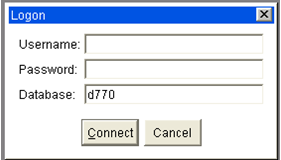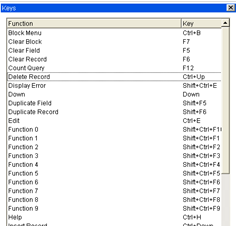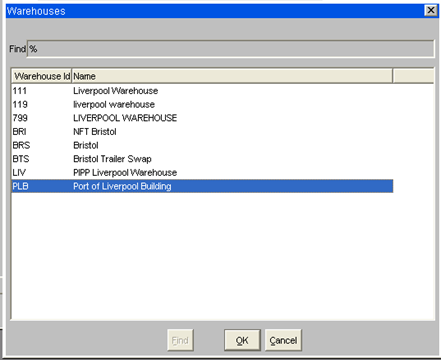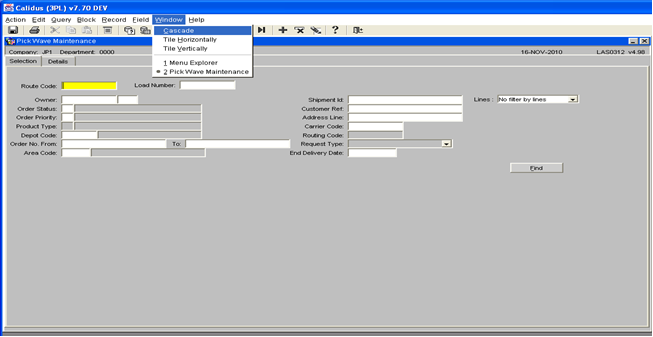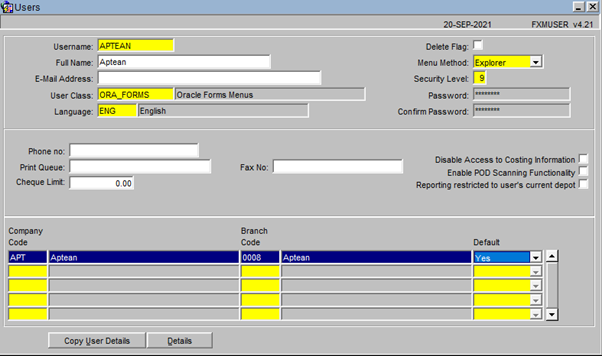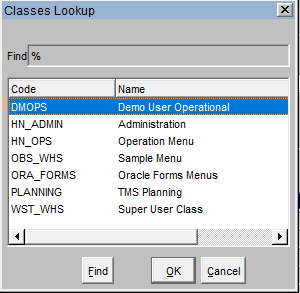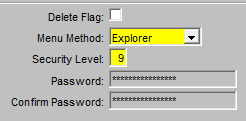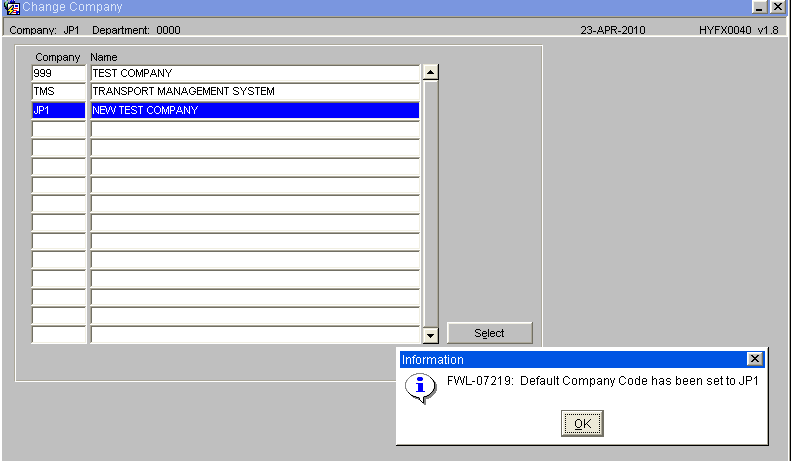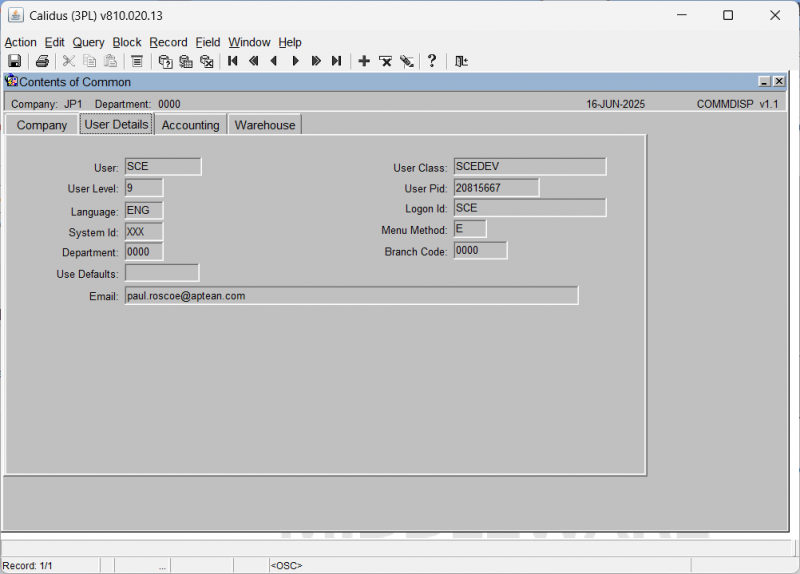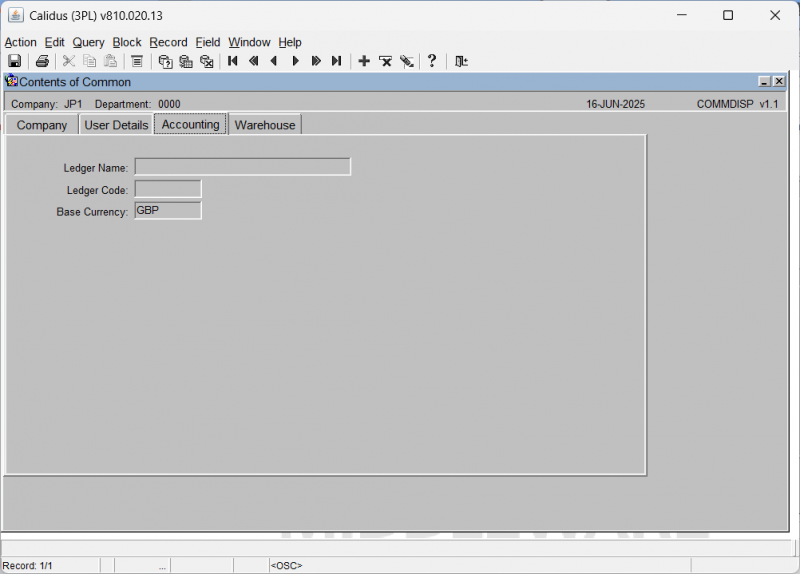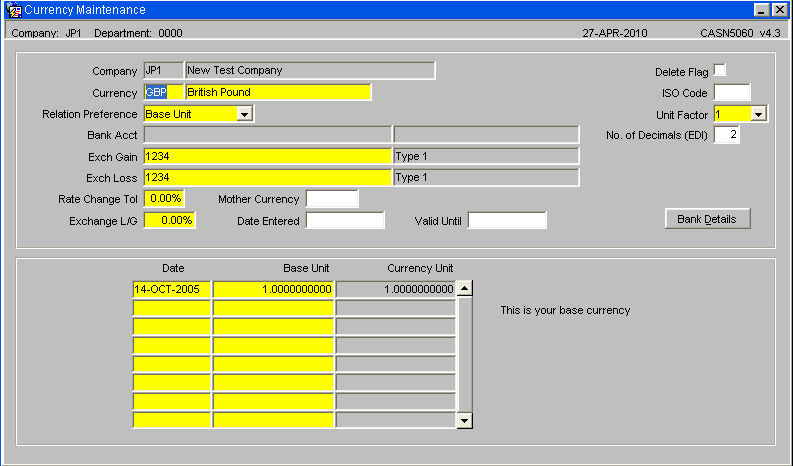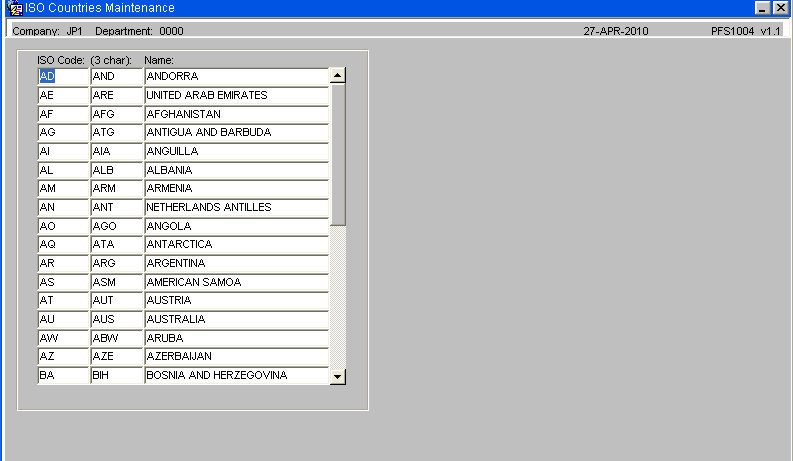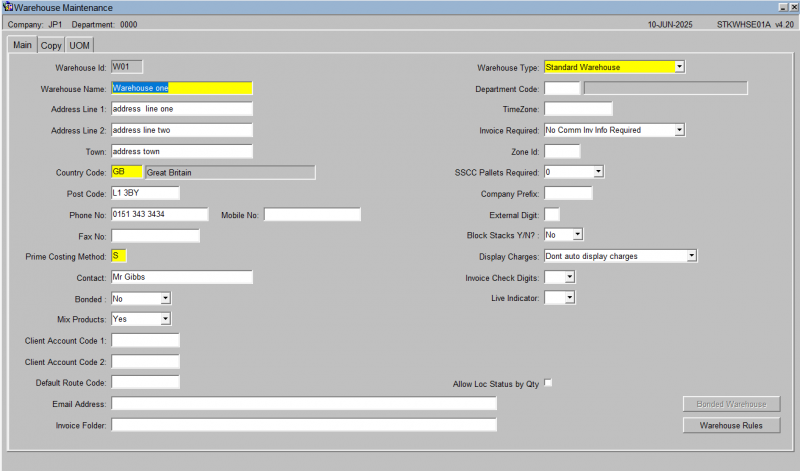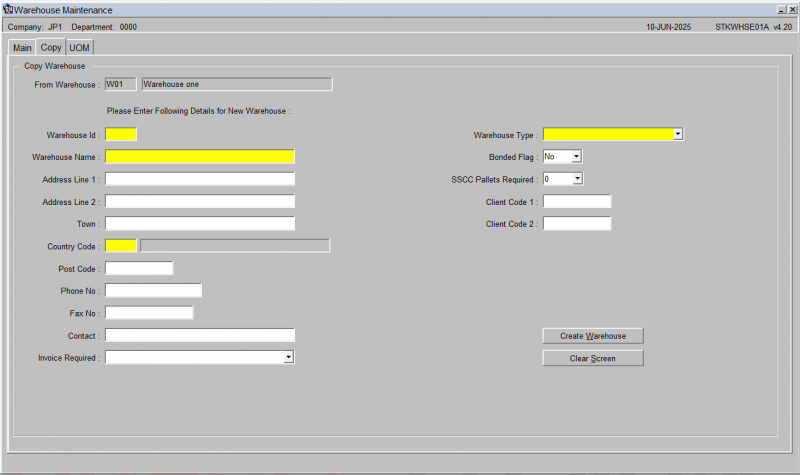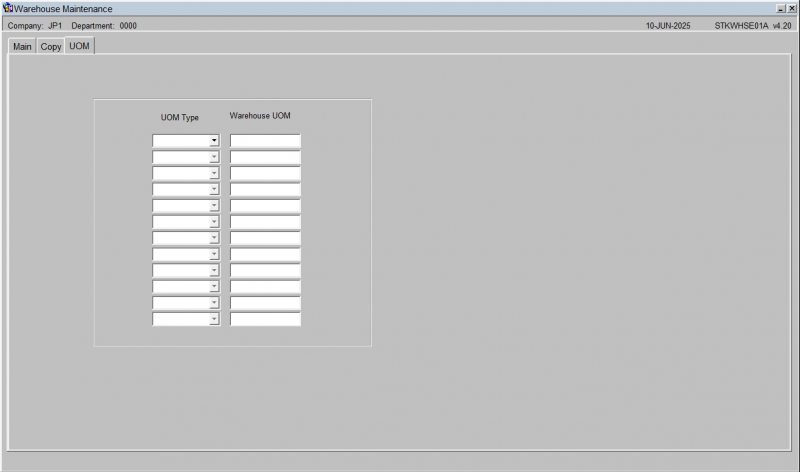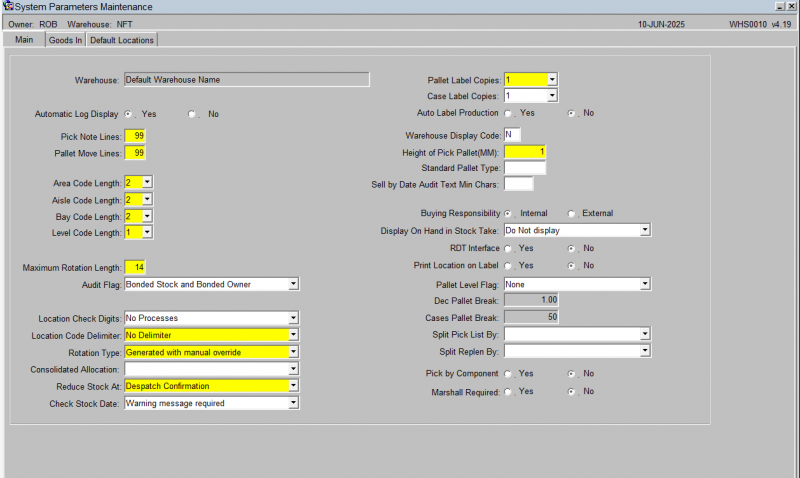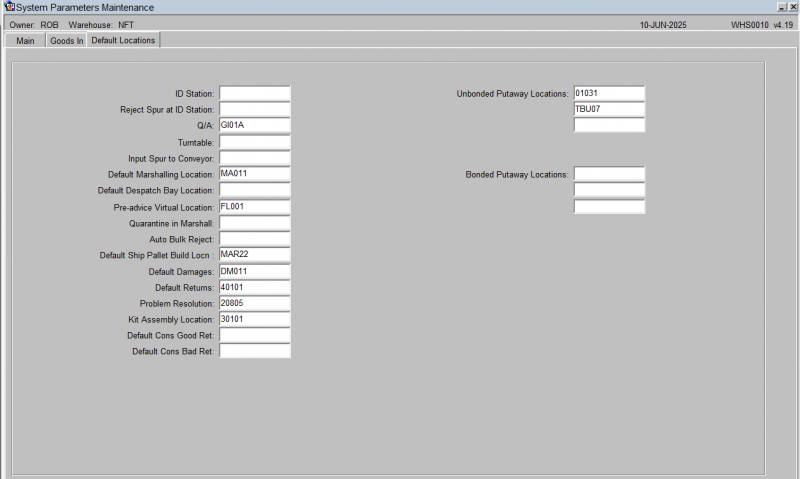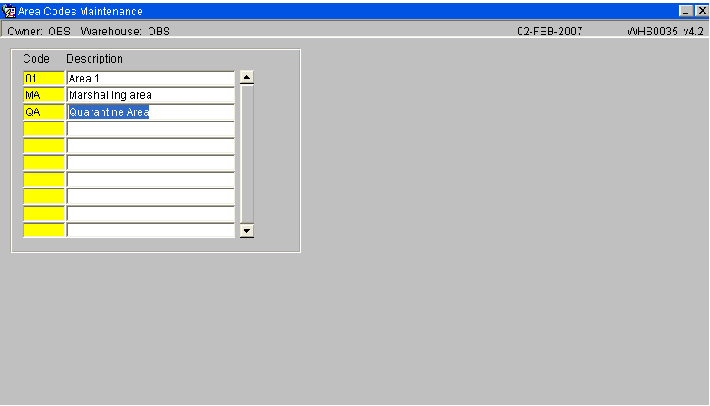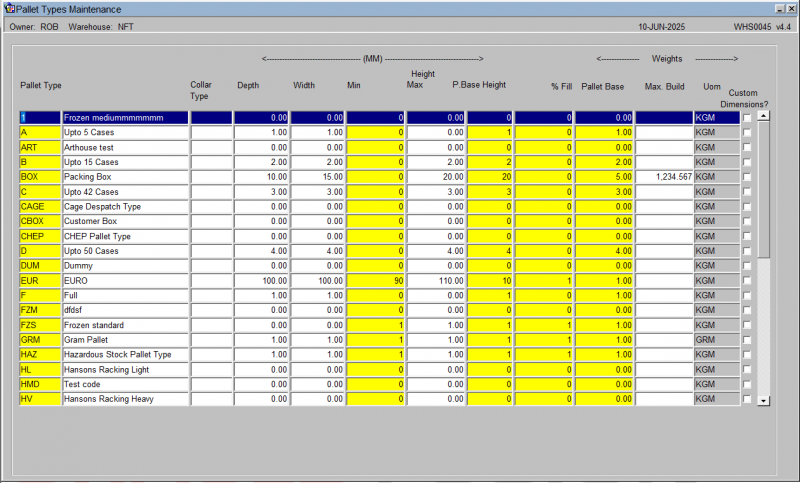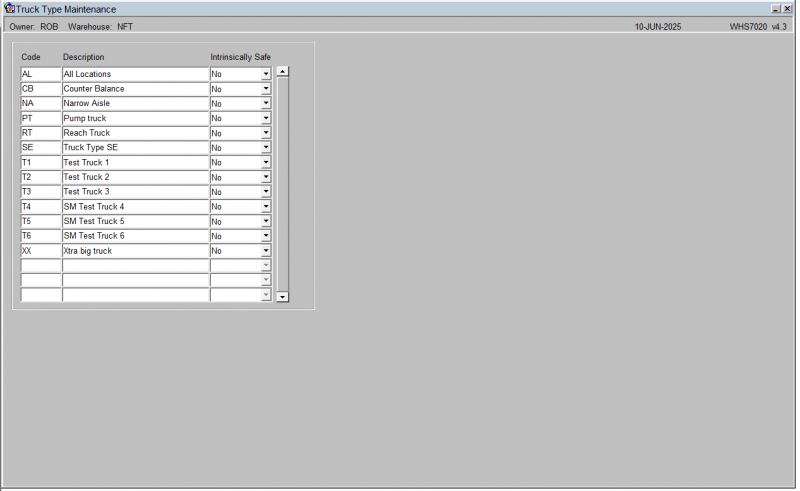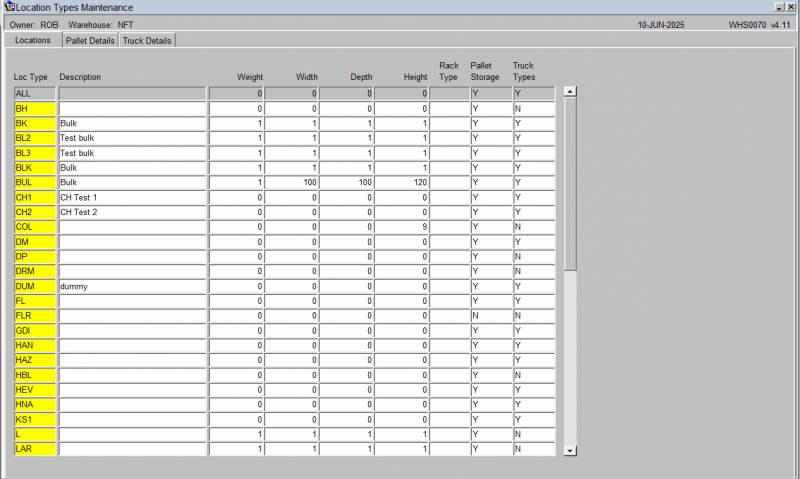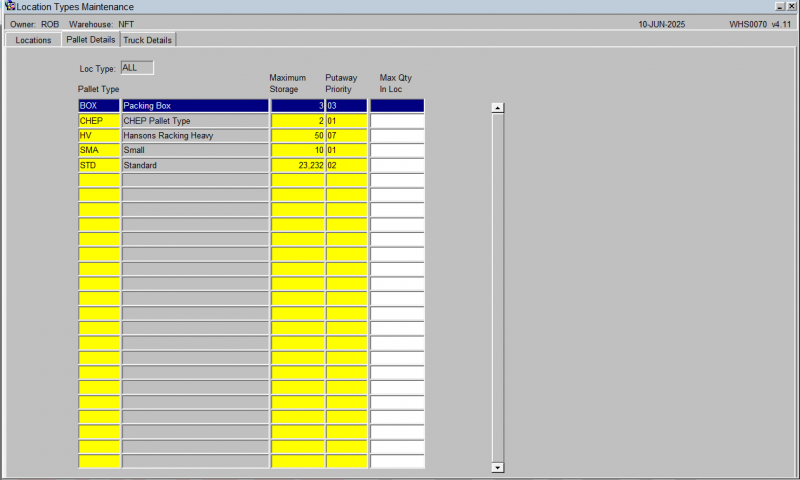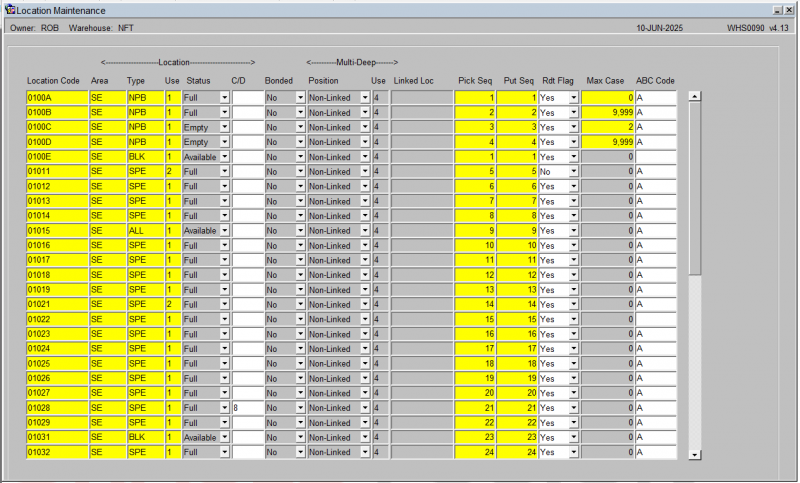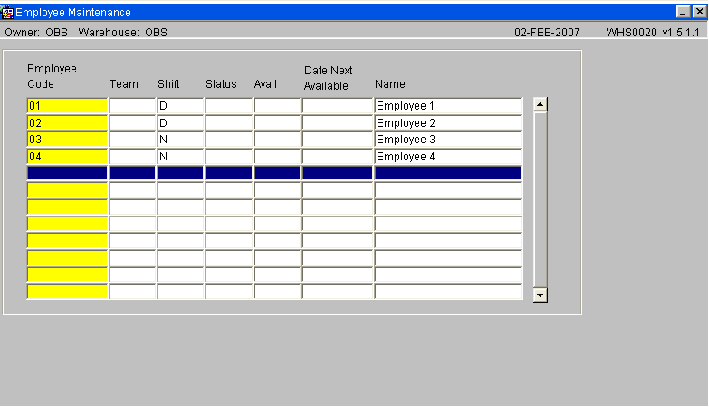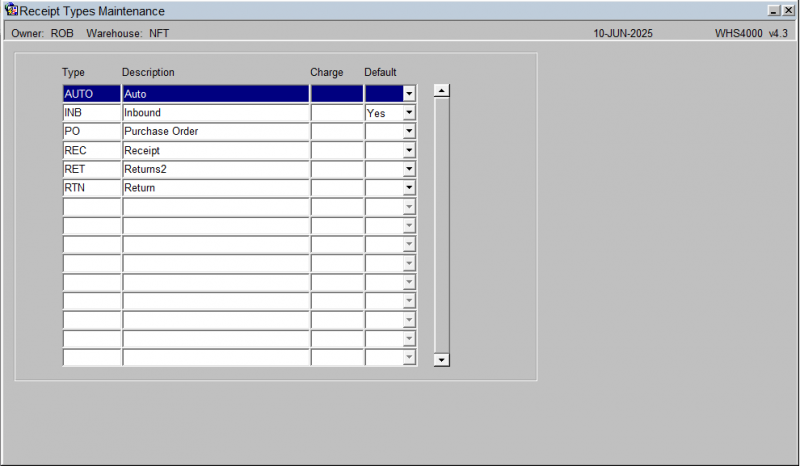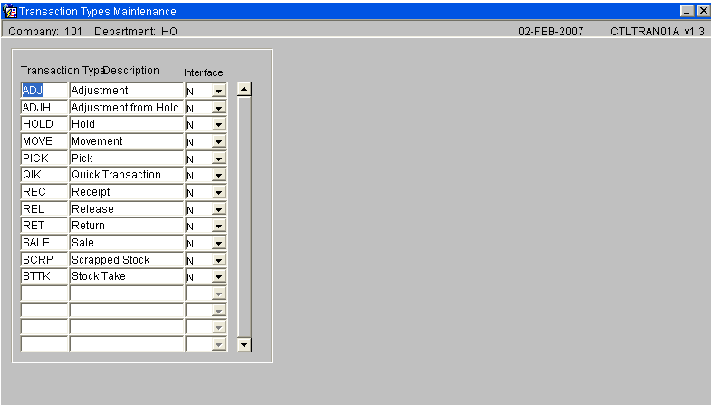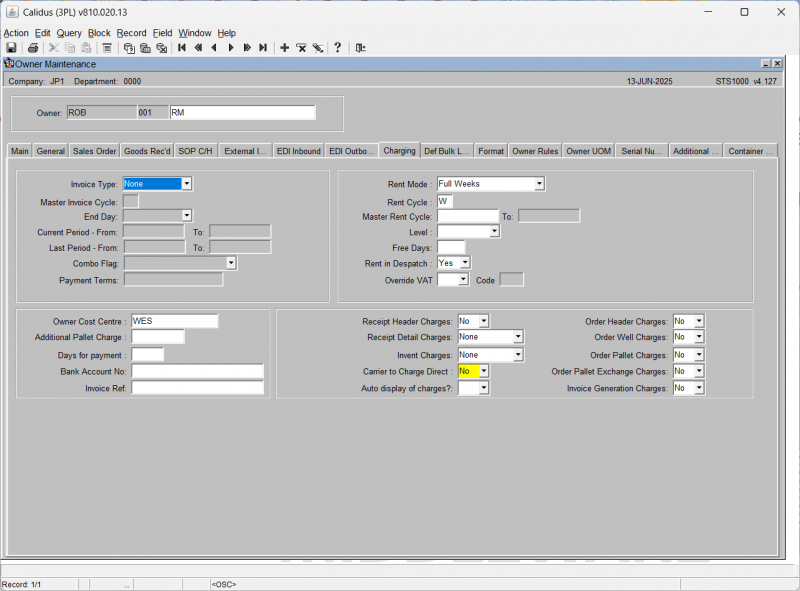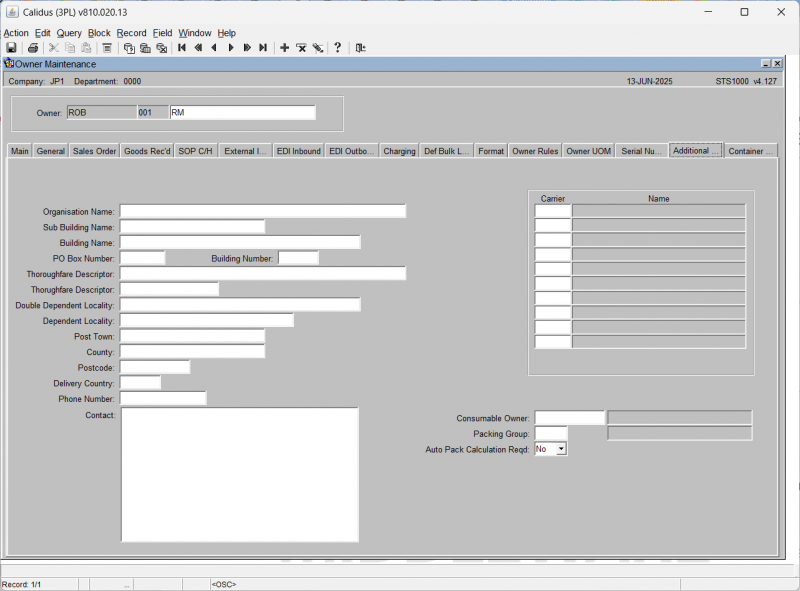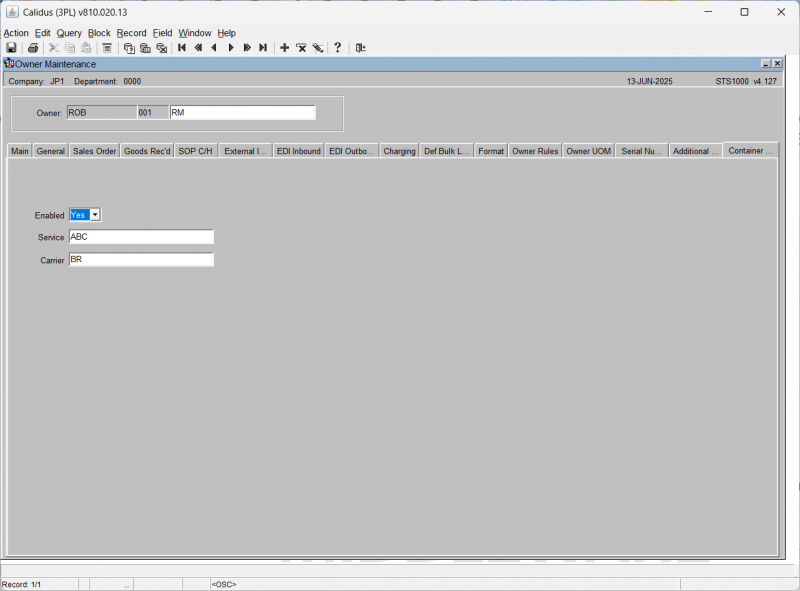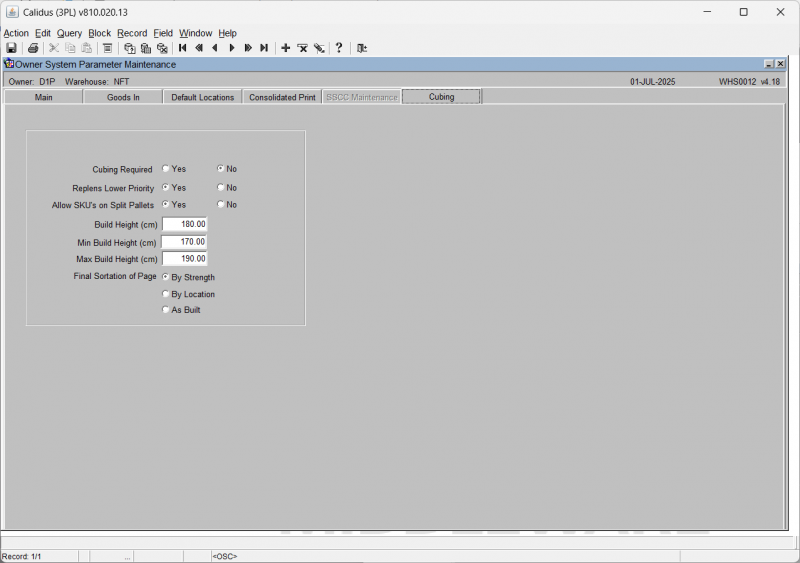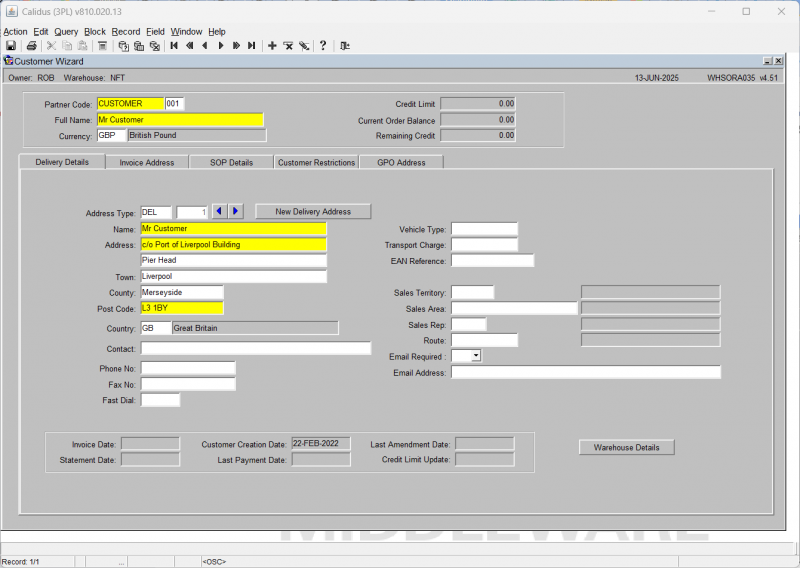UG 352167 C-WMS Standing Data Set-up Guide
![]()
Aptean
C-WMS Standing Data Set-up Guide
CALIDUS WMS - 810
1st July 2025 - 3.00
Reference: FS UG 352167
The purpose of this document is to provide the user with knowledge of how to navigate throughout the CALIDUS system. This document includes basic navigation of the screen, functionality of Icons and screen layouts.
Logging on
A unique username and password should be set up for logging on. This username can be established by Department, Office and User. This gives the user access to specific data that is required in order to fulfil their role. Enter the username and password at the prompt.
OUTLINE
The main menu screen is the first screen displayed when the user has logged into the system. The toolbars around the perimeter of the screen are generic throughout the system and provide the user with various options to update, insert, query and display information.
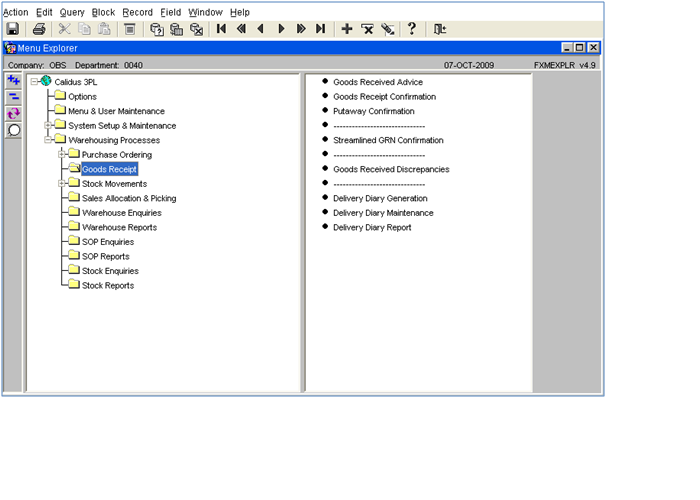
Function toolbar
The purpose of the function toolbar is to allow the user to query, insert, delete and update information. The main applications used are shown as icons on the formatting toolbar.
Each function has a list of associated functions attached to it, these can be can be accessed by clicking on them using the mouse or pressing the underlined letter on the keyboard.
When the user clicks on a function, a drop-down list of items will show, as below.
- Action
- Save - saves changed data (see below for important information on saving)
[CTRL-S] - Clear All - clears all existing data
- Print - prints the screen
- Exit - exits the screen (however use the exit icon - see below)
- Save - saves changed data (see below for important information on saving)
- Edit
- Cut - cuts selected information to be moved elsewhere*
- Copy - makes a copy of selected information*
- Paste - pastes either the cut or copied information to the selected new location*
- Edit - find and replace function for text
- Display list - produces a list of values for the field that can be selected for the field
- Query
- Enter - used to find existing data using specific parameters (
[F11]) - Execute - asks the system to find data within selected parameters (
[CTRL-F11]) - Cancel - cancels any query that was set up
- Last criteria - retrieves last query
- Count hits - displays quantity of records to search
- Fetch next set - retrieves next set of data
- Enter - used to find existing data using specific parameters (
- Block
- Previous - moves cursor to previous block of data
- Next - moves cursor to next block of data
- Clear - clears information in the block of data the cursor is in
- Record
- Previous - displays previous record
- Next - displays next record
- Page up - moves scroll bar up
- Page down - moves scroll bar down
- First - displays first record
- Last - display last record
- Insert - clears data for new record to be inserted
- Remove - deletes data permanently
- Duplicate - duplicate previous record data in next record for updating purposes
- Clear - clear the record
- Field
- Previous - moves to previous field
- Next - moves to next field
- Clear - clears the selected field
- Duplicate - duplicates previous field data in next detail line
- Help
- Screen Help - prompts a help page for the screen
- Contents and Index - N/A
- Properties - displays the properties of the selected field
- Keys - lists the functions keys to use instead of a mouse (
[CTRL-K]) - Display error - display error details on the information bar
- Display common - displays common details about the user and system setting
- About... - web page
Format Toolbar
The formatting toolbar is made up of the most regular functions used in navigating through the system. Icon buttons are displayed for quick access, all the functions are as detailed in the previous section.
From left to right:
- Save - To ensure that any change to data input is saved, even to a single field, you must move out of the last field that you have changed before you exit the screen. If you do not then the system will not recognise the change, even if you hit save. You can move out of the last changed field by either using the enter key, the tab key or by using your mouse to click onto another field. (
[CTRL-S]) - Cut *
- Copy *
- Paste *
- List of Values (LOV) - displays a list of values if there is one (this will be indicated in the status bar). (
[CTRL-L]) - Enter a query - used to find existing data using specific parameters (
[F11]). Note that the colour of the title bar changes to turquoise, denoting that the screen is now in query mode. - Execute a query - asks the system to find data within selected parameters (
[CTRL-F11]) - Cancel a query - cancels any query that was set up.
- First record - This [First Record] button displays the first record of the database.
- Previous page - This [Previous Page] button displays the previous page.
- Previous record - By clicking on this [Previous Record] button you can view the previous record. For example if you are in Order no. PIP00000000000000337 and you click the [Previous record] button then you can view the booking done prior to this Order - in this example, PIP00000000000000336
- Next record - This [Next Record] button takes you to the next record.
- Next page - This [Next Page] button displays the next page.
- Last record - This [Last Record] button displays the last record of the database.
- Insert - The purpose of the [Insert Record] button is to help you to insert new record in the system. If you want to add new record then by clicking this [Insert Record] button you can add a new record.
- Remove - This [Remove Record] button help you to delete a particular record. By clicking on this you can delete the record from the database.
- Clear - This purpose of this [Clear Record] button is to clear the record from that particular screen. The difference between clear record and the delete record is that delete record will completely delete the record from the database but clear record just clear that record from that particular screen. Clear records can again be retrieved from the database.
- Help - This [Help] button prompts a help page.
- Exit - This [Exit] button helps the user to come out of the particular screen (
[F4]). Always use the exit door to come out of a screen as opposed to the ‘x’ in the top right hand corner. Using the ‘x’ can cause problems with saving any changes or may even throw you out of the system.
![]() Note: Items marked with an asterisk (*) are mainly used in Notepad screens.
Note: Items marked with an asterisk (*) are mainly used in Notepad screens.
TO SAVE CHANGES/AMENDMENTS
![]() Note: To ensure that any change to data input is saved, even to a single field, you must move out of the last field that you have changed before you exit the screen. If you do not then the system will not recognise the change, even if you hit save.
Note: To ensure that any change to data input is saved, even to a single field, you must move out of the last field that you have changed before you exit the screen. If you do not then the system will not recognise the change, even if you hit save.
You can move out of the last changed field by either using the enter key, the tab key or by using your mouse to click onto another field.
Mandatory Fields
Certain fields within the System are highlighted in yellow.
These are mandatory fields in which user has to input the details in order to save any new/updated records successfully.
Shortcut Keys
You can access a list of valid keyboard shortcuts can be accessed on-screen by pressing [CTRL-K].
Title Bar
The purpose of the title bar is to tell the user the system parameters that they are working within.

The purpose of this toolbar is to help the user navigate through the menu tree options.
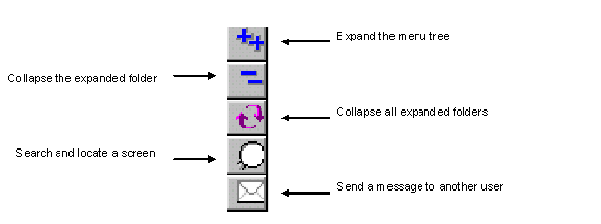
Menu Search
The purpose of the menu search (screen locator) is to find a screen if you are unsure about where is it located in the menu tree.
When you click on the Search button, a screen appears which enables you to enter either the screen number or the screen title. The system searches for the screen when the 'execute query' button is pressed and displays the screen details in the information bar underneath. When you click on the detail line you are taken into the screen.
![]() Note: Menu Search will only 'find' screens that are included in the menu trees. It will not 'find' screens that are called from within another screen.
Note: Menu Search will only 'find' screens that are included in the menu trees. It will not 'find' screens that are called from within another screen.

Messages
The purpose of the message icon is functionally the same as normal e-mail; the screen displays messages received and clicking on the details line or clicking the details button will open up the message. It is not an e-mail function. It will only send mail to other CALIDUS system users who are included in a valid e-mail list.
The filter is used to specify what the user wants to do;
- To compile a message, select new from the filter or click on the new button
- To read received mail, select received from the filter (a message is received when the message button is yellow instead of white).
- To view deleted messages, select deleted from the filter
- To check if a message has been read, select outgoing from the filter
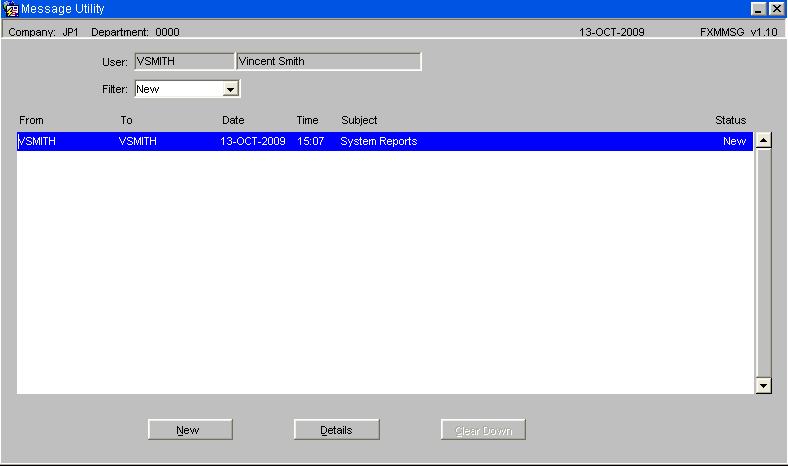
Tree Structures
The purpose of the main menu screen is to allow the user access to the required screen. The tree menu structure is designed to allow the user to access the screens logically and quickly. The menus are configurable and can be customised as required. See Menu Maintenance for more details.
All information is stored in yellow file folders to the left of the screen, if the folder has a plus sign to the left of it, then there are more folders associated with it.
When the folder is selected the icon shows that it is open, all the screens associated with the folder header are detailed on the right of the screen and can be accessed by clicking on the screen title.
- Click on the plus sign or the yellow folder to expand the tree and show the associated folders.
- Click on the minus sign to collapse the tree back to the main folder.
Instead of using the mouse the user can use ‘hot keys’ to navigate the menu by using the TAB key and then the [UP]/[DOWN] arrows to navigate the left and right screen panels. He can then hit the [ENTER] key to access a particular screen.
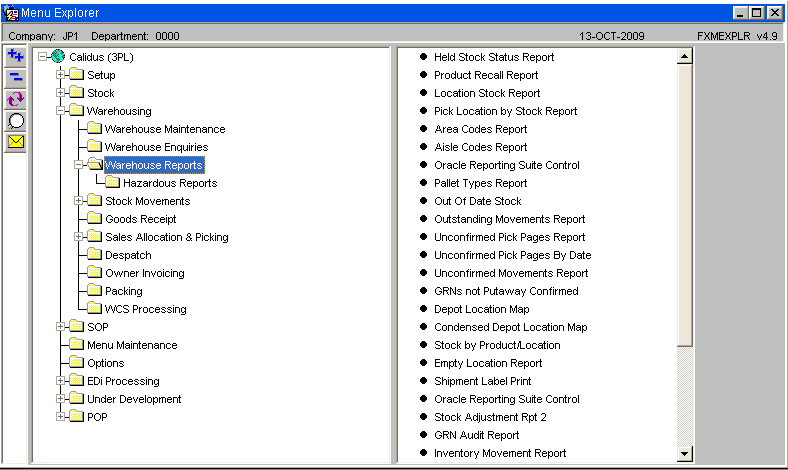
Information Bar
The purpose of the information bar is to provide details to the user of what the status of the screen is, i.e. executing a query, loading a new screen, or, what functions are available for the selected field.
Status of the screen
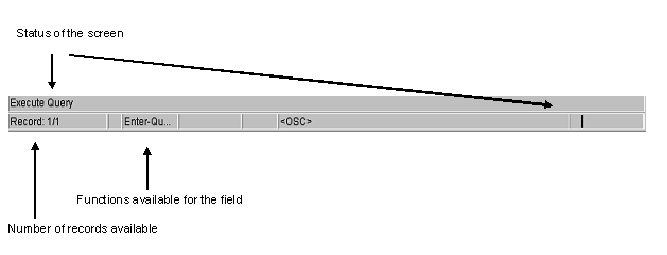
Querying Records
The purpose of querying records is to search, locate and display information quickly rather than paging through information.
To enter a query the user can either clicks on the [Enter Query] button on the formatting toolbar or press [F11] on the keyboard. The user will know that they are in ‘enter query’ mode when the title bar will change colour and the information bar will have a query message displayed on it.
The user then enters the information they wish to query i.e. a booking reference and clicks on the [Execute Query] button on the formatting toolbar or [CTRL-F11] on the keyboard. The system will then display the relevant record and the title bar and information bar will return back to normal.
The [Cancel Query] button will clear any query information that is on the screen to allow the user to enter new query details. User can also press [F4] to cancel query.
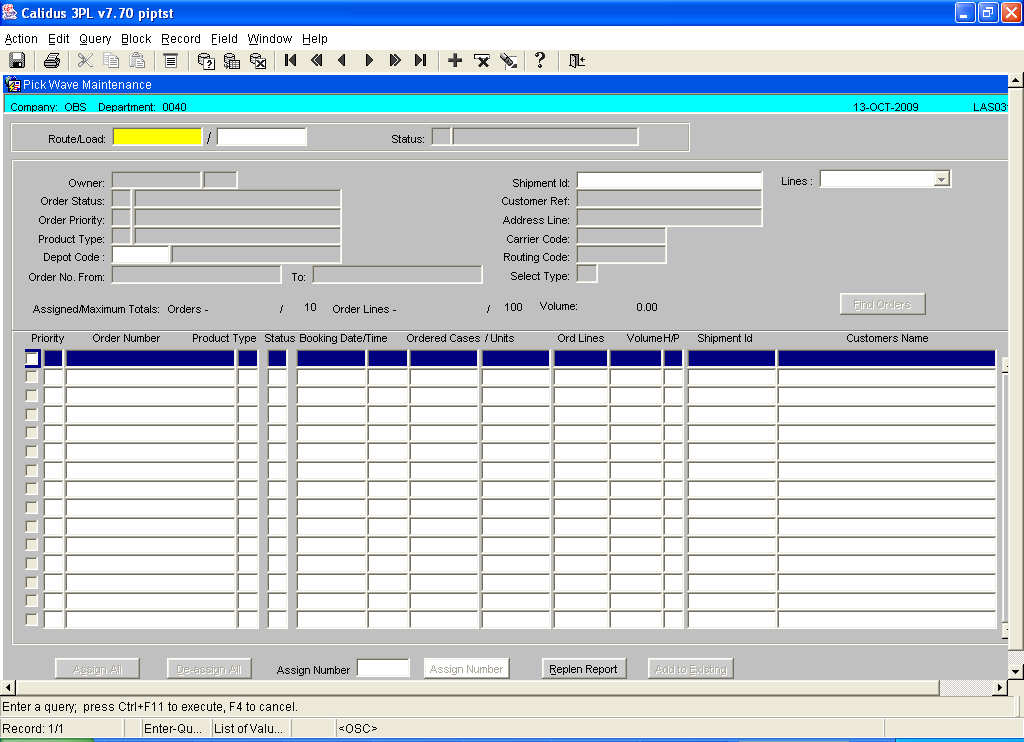
List of Values (LOV)
The purpose of a list of values is to provide the user with associated information attached to a specific field. The mandatory or main information fields will usually have a LOV attached to it. This is shown in the information bar at the bottom of the screen. [CTRL-L]
For example, Currency Code will have a LOV of existing Currency Codes
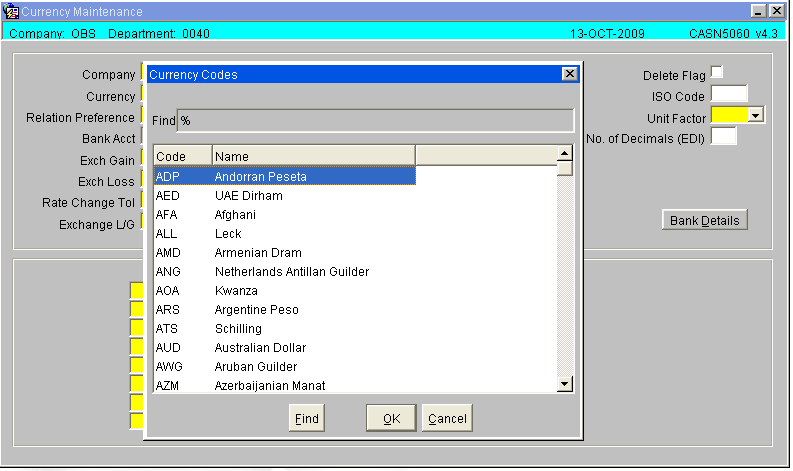
Partial LOV
The purpose of a partial LOV is to be specific about the data the user wishes to retrieve,
For example, a user wishes to enter a warehouse code for Liverpool
The user enters the first 2 letter of the code then clicks on the LOV icon on the formatting toolbar or keys [CTRL-L]. This action pulls up the LOV but is filtered straight to warehouse code beginning with LI.
The user can select the required data from the list displayed by highlighting the detail line and clicking on the OK button.
The scroll bar on the right of the LOV allows the user to look throughout the list of information.
The find field at the top of the LOV can be entered into and more specific data can be added and filtered using the Find button.
![]() Note: The percentage sign
Note: The percentage sign % is a programming key that tells the system to find all information containing text within the parameters. This key can be entered either in the field before the LOV is displayed to go to specific information direct or entry can be made after the LOV is displayed i.e. %OL will display all codes ending in OL.
Screen Buttons
The purpose of screen buttons are to access additional relevant screens from the screen the user is currently working in. This saves the user from having to exit back to the main menu screen to enter more details.
For example, the Pick Confirmation screen has various buttons to help the user to enter direct information about the order, - Details, Order Notes etc
When a button is pressed the called screen is displayed on top of the existing screen. When exiting the called screen, the user will be returned to the calling screen.
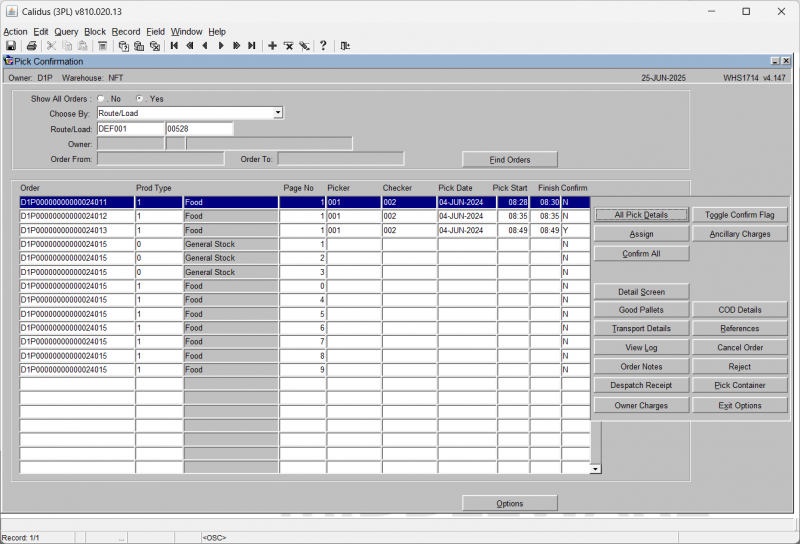
Tabs
Tabs are another way of grouping information.
Different groups of data can be accessed from one single screen with the help of tabs.
Like on this Stock Maintenance screen.
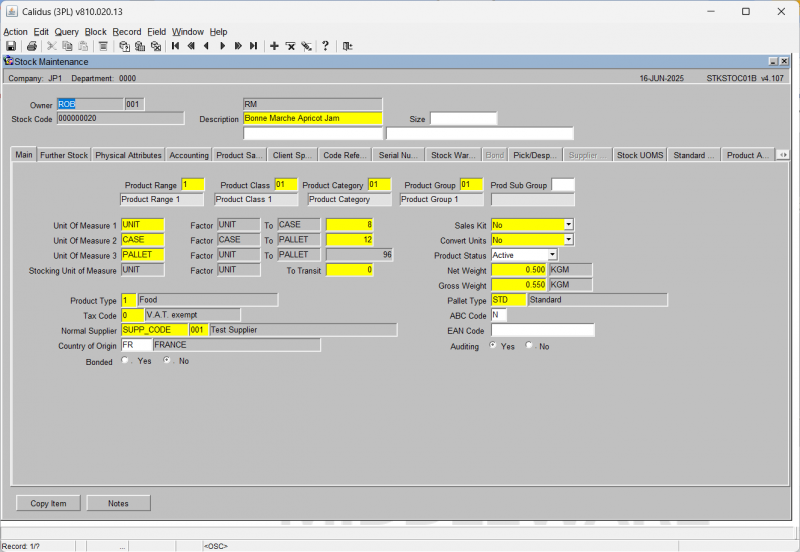
Multiple Screen Access
User can toggle between the two or more screens with the help of [CTRL-TAB] buttons on the keyboard, or using the Window option on the top toolbar.
Right Click Function
On certain screens it is possible to use a right mouse click (or the right click/list key on the keyboard) to call a panel of options. For example, on the Goods Receipt Confirmation screen (WHS01501), the right click function is used on the stock code line to call a panel of options.
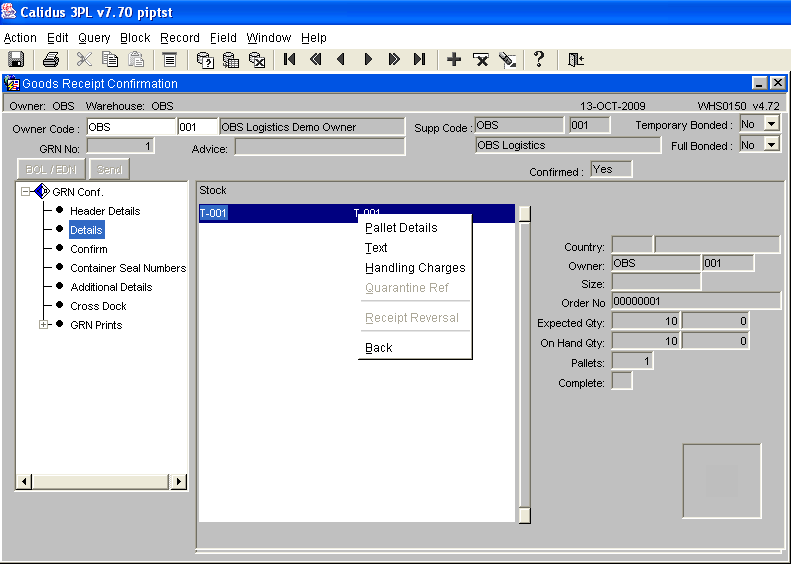
Company Set-up
This document describes the process and the required screens to be used in setting up the information for the Company running the warehouse. Other guides describe the set up of the warehouse, owners, etc.
This is a generic guide based on the version of the CALIDUS WMS system at the time of writing.
Note that fields marked '**' are mandatory and are needed to ensure correct set up of the system.
SYSTEM REGISTRY (ULF0030)
In order to create a company, you must be given the authority to do so.

In system registry, against your user id, move the cursor to the right hand side of the browser and click on the '+' icon. This will show you the box below. Enter the text exactly as shown (without spaces.)
In order to create a department (required) you also need to take the same steps, but entering a description of DepartmentSuperUser and a data value of 1.
In addition to setting up the user account to allow the company to be created, a system registry setting must be set for units of measure.
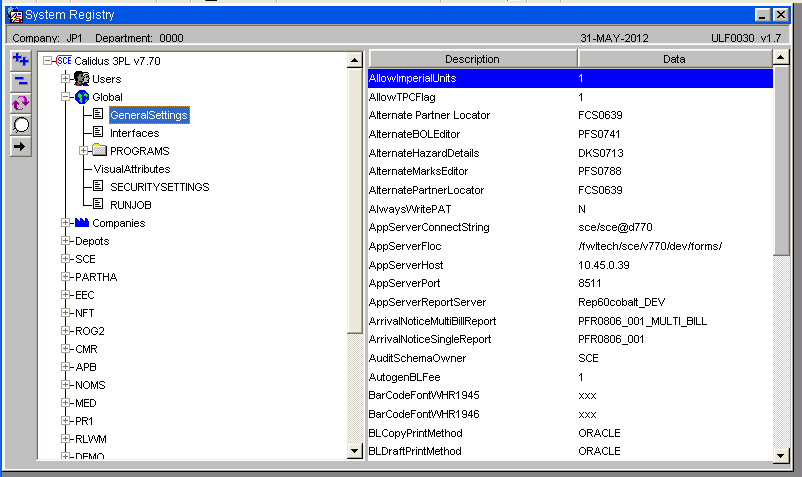
Ensure that the system registry value 'AllowImperialUnits' with a data value of '1' is set at either Company level (this may require a new Company data node to be added to the menu or enter at the Global level.
![]() Note: If the value is not set then there is the possibility that inbound EDI messages mail fail to upload.
Note: If the value is not set then there is the possibility that inbound EDI messages mail fail to upload.
COMPANY MAINTENANCE (CASN5010)
Main Tab
![]() Note: Ensure the three character Company Code does not start with a number
Note: Ensure the three character Company Code does not start with a number
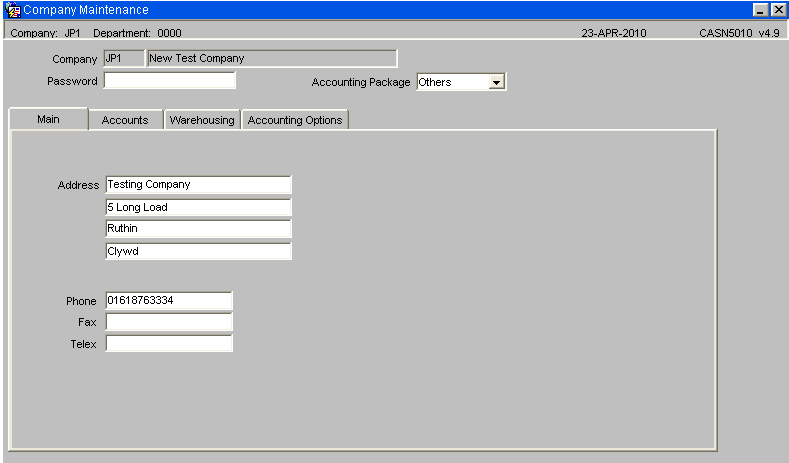
Ensure that the company code and name are entered, the company address is entered and the tel/fax/telex numbers if required are entered with no spaces in between the numbers.
If a password is entered then this must be also entered if ever enquiring on or updating the company before the execute enquiry is selected.
| Field Name | Description | Options | Generic Value |
|---|---|---|---|
| Company Code ** | This is the 3ch code used to define the company all warehouses and owners will be under | Any 3 character code, that does not start with a number | Defined by the client |
| Password | Used to restrict users from accessing the company maintenance screen | 30 character field or left blank | Blank |
| Accounting Package ** | Used to defined ledger and accountancy information | Agresso, Coda, SCE, Other | Other |
| Address ** | The address of the company | 4 x 30 character free text fields or left blank | Defined by the client |
| Phone | Phone number of the company | 15 character free text field or left blank | Defined by the client |
| Fax | Fax number of the company | 14 character free text field or left blank | Defined by the client |
| Telex | Telex number of the company | 14 character free text field or left blank | Defined by the client |
Accounts Tab
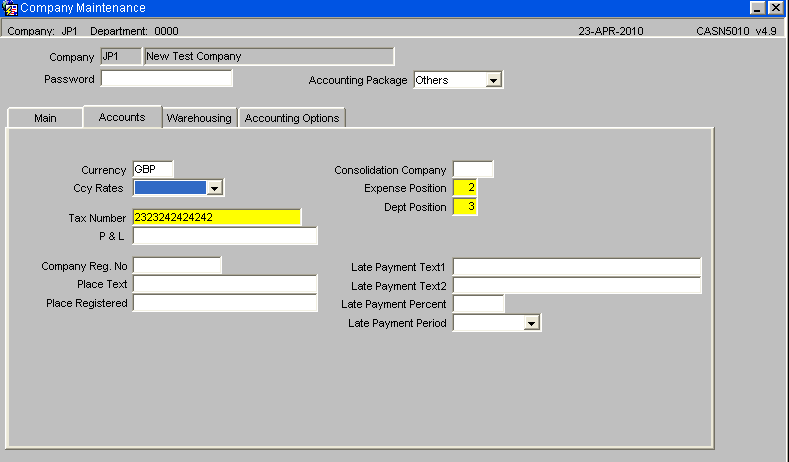
Ensure that the currency is entered, even though no currencies exist for this new company yet, then enter a tax number for the company.
The expense position must be before the debt position although without financial integration these numbers do nothing.
An information message will be generated by the system 'FWL-04534' "Enter the year and period, N/L processing is to begin." Click OK.
The Nominal Ledger start period will automatically be put to the current year followed by 01. (A)
| Field Name | Description | Options | Generic Value |
|---|---|---|---|
| Currency ** | Base currency of the company | Pre defined in currency maintenance normally ISO standard - LOV available | EUR |
| Ccy Rates ** | Determines the method of updating currency codes - will default to 'Stand Alone' | Master, Update, Stand Alone | Stand Alone |
| Tax Number ** | Unique Tax reference number for the company | 20 character free text field | Defined |
| P&L | Purchase and Ledger reference number | 30 character free text field or left blank | Blank |
| Consolidation Company | If the client has multiple company codes, the consolidated or master company code is entered here | Must have been created in company codes maintenance or left blank | Blank |
| Expense Position ** | The expense code's numerical position within the nominal ledger code - used for accounts | 01-Oct | 1 |
| Dept Position ** | The dept code's numerical position within the nominal ledger code - used for accounts | 01-Oct | 3 |
| NL Start Position ** | The year and month the company's accounts will start from | YYYYMM | Defined by the client |
| Late Payment Text 1 | A text box to dictate what should appear on the invoice | 40 character free text field or left blank | Blank |
| Late Payment Text 2 | An additional text box to dictate what should appear on the invoice | 40 character free text field or left blank | Blank |
| Late Payment Percent | The percentage at which the company can accept late payment | 0 - 100.00 | Blank |
| Late Payment Period | The period in which late payment is allowed | Per month, Per year | Blank |
For Owner Invoicing, the following summarises the details that are required:
- Company Registration number
- VAT number
- Name and Address details for Head Office (HQ)
- ‘Registered in city/town’ fixed text details for invoice
- Late Payment rule – percentage and associated fixed text etc
This information relates to the ‘Head Office’ details for the Company. The code and details used for the Company Accounts and the details that will be printed on each invoice that will be sent to Stock Owners.
The ‘Late payment’ text etc. These lines and figures will be printed at the top of the invoice. See invoice details and example below.
Warehousing Tab
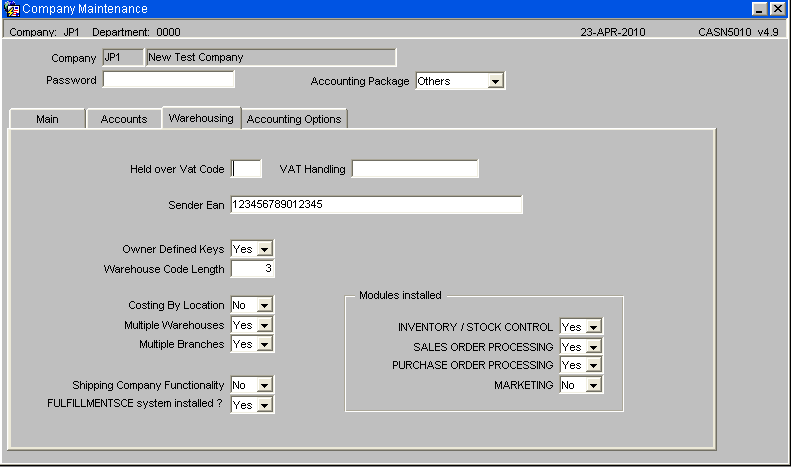
If the owner defined keys are set to 'Y' then all customers/suppliers will only be available for the owner that they are set up with. If set to 'N' then the customers/suppliers will have '+' placed in their owner fields and will be be seen and available by all owners.
![]() Note: Ensure the warehouse code length is set to 3.
Note: Ensure the warehouse code length is set to 3.
Ensure Multiple Warehouses , Multiple Branches are set to Yes.
Ensure FulfillmentSystemSCE installed is set to yes.
Ensure that the top 3 modules installed are set to yes.
| Field Name | Description | Options | Generic Value |
|---|---|---|---|
| Held Over VAT code | Zero rated vat rate of the company | Predefined in Vat Rates maintenance or left blank | Blank |
| Sender Ean | The European EAN number of the edi owner | Defined by the client or left blank | Blank |
| Owner Defined Keys ** | Used to specify if the owners within the company are allowed to see/use each others' suppliers anc customers | Y or N | N |
| Warehouse Code Length ** | The length of the warehouse code to be set up | Numerical value between 1 and 9 - but if using RDT, has to be no longer than 3 | 3 |
| Costing by Location ** | Used for accounting if charging by location | Y or N | N |
| Multiple Warehouses ** | Defines whether there will be more than one warehouse under the company | Y or N | N |
| Multiple Branches ** | Defines whether there will be more than one warehouse under the company | Y or N | Y |
| Shipping Company Functionality ** | Determines whether the company will use shipping functionality as well as WMS | Y or N | N |
| Fulfillment SCE system installed? ** | Determines whether the company will be using the freight functionality | Y or N | N |
| Modules Installed (all) ** | Defines which parts of the WMS functionality the company will be utilising | Y or N for all options | Y for all |
Accounting Options Tab
Not relevant for the implementation of WMS
OFFICE/DEPARTMENT SET UP (PFS1025)
Note that only a few defined fields are required for warehousing. These are detailed below. All other fields can be ignored.
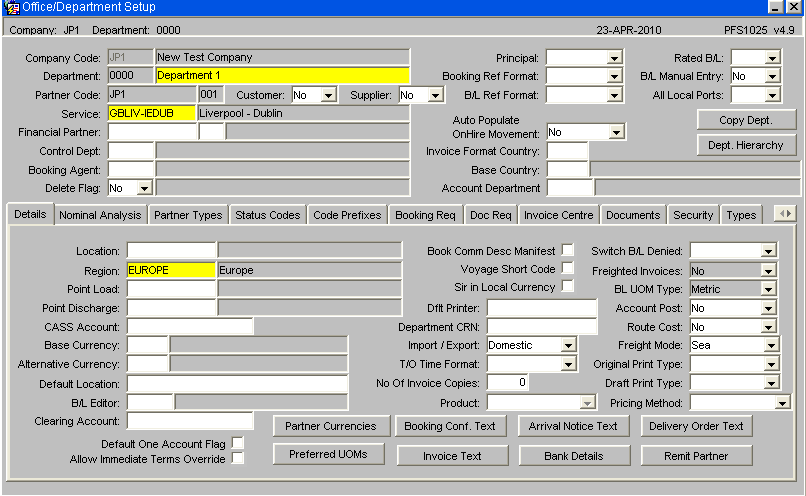
Before attempting to create a department ensure the user being used has the registry setting DepartmentSuperUser is set to 1. (See above - System Registry)
The screen requires the entry of a new department, enter a new department and description that will be used for warehousing with this company.
Next enter the company code that you have just created.
Next enter a partner code this does not have to already exist.
Choose a service, these can be set up in service maintenance but are irrelevant to warehousing.
The only other field to enter is Region, an LOV is available so just enter the nearest region to the company main office, once again this is irrelevant to warehousing.
| Field Name | Description | Options | Generic Value |
|---|---|---|---|
| Company Code ** | The company code you have created which you wish to assign a department to | 3 character free text field | Defined by the client |
| Department ** | The department code and department description that will be assigned to the company | 3 character free text field | Defined by the client |
| Partner Code ** | The partner code to be associated with this department | 10 character free text field (no validation) | Defined by the client |
| Region ** | The region the country is situated in | Must have been set up in region maintenance | Defined by the client |
USER MAINTENANCE (FXMUSER)
Add the new company code and department code to your current user.
User records are setup in FXMUSER (Maintenance User Maint WMS Admin Users)
The key items that determine the level of access that a user has are:
User Class -
This determines the menus that a user can see when they log into WMS
Security Level - Each screen and submenu is graded with a security level. Users can only see the screens and submenus that are at or below their assigned level. The level can be set at 1 through to 9
Company Details (highlight line and press Details)
Details - This determines which Owners, Ledgers (PL1/SL1), and Warehouses the user can access
Container Yard Management
Note that the Owner under which you are configuring the user must be configure for Container Yard Management, through Owner Rules (CTMG).
Users are of a specific type
- Non Container management user (no access at all)
- Admin (access to all container management functions)
- PDA (access to device screens only)
- Customer (access to customer screens only)
Change Company (HYFX0040)
Select the company you have just created and added to you user and click Select.
Common Values (COMMDISP)
To call the screen - Select Help / Display Common from the toolbar.
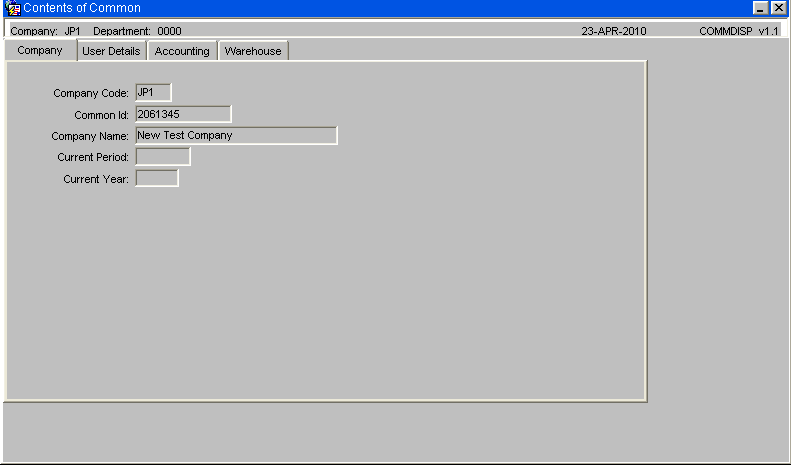
When you change company (using HYFX0040), you can use this to ensure that the company has actually changed. If not, set the new company as the default in the User Maintenance screen and log out and back in again to re-set the company.
Here you can also view
User Details
Accounting
Warehouse
CODE TYPES MAINTENANCE (CASN5150)
Although the following screens are not used by the WMS, they still need to be created in order to use the company code. The following steps are needed in order to create the nominal master.
To set up the nominal master you need to create a minimum of 4 records in code types maintenance - codes 1 to 4 all with length 1.
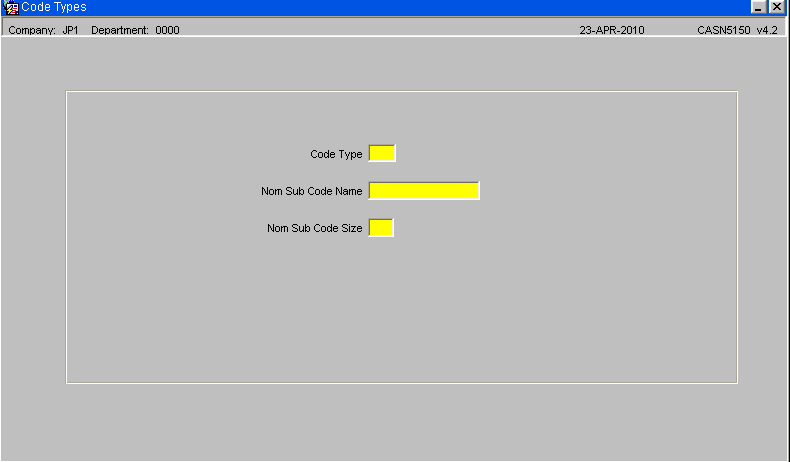
Four different code types need to be set up. The Code Type (A) needs to run from 1 to 4. The Nom Sub Code Description (B) can be Type * where * is the number. The Nom Sub Code Size (C) must always be 1.
| Field Name | Description | Options | Generic Value |
|---|---|---|---|
| Code Type ** | The numerical code given in order to create the code | 1 digit field | Defined by the client 1 |
| Nom Sub Code Name ** | The name given to the code type | 15 character free text field | Defined by the client ?? |
| Nom Sub Code Size ** | The size of the code type | 1 digit field Defined by the client | 1 |
CODES MAINTENANCE (CASN5040)
For each code type you just created go into codes maintenance - the code in the 2nd block will make up part of the nominal code in the following way:-
- Code type 1 code = 1
- Code type 2 code = 2
- Code type 3 code = 3
- Code type 4 code = 4
The nominal code will now be 1234


For types 2 - 4 only the code information and description need entering.
| Field Name | Description | Options | Generic Value |
|---|---|---|---|
| Code Type ** | The code type the code will be set up against | Must have been created in code types maintenance - LOV available | Defined by the client |
| Code Size ** | The size of the code type | Will default to the size entered in code types maintenance | Defined by the client |
| Code ** | The code to be created | Defined by the required setup (you will need to repeat this for numbers 1,2,3 and 4) | 1 |
| Description ** | The description for the code to be created | 25 character free text field | Defined by the client |
| Acc Type ** | The type of account this code relates to | P & L Account | P&L Account |
| Debit/Credit ** | Determines whether the code is to be used for credit or debit purposes (not used by the wms) | Credit | Credit |
| Ccy Bals ** | Are currency balances to be recorded? | Y or N - will default to Y | Y |
NOMINAL ACCOUNT MAINTENANCE (CASN5120)
Nominal code maintenance create record 1234
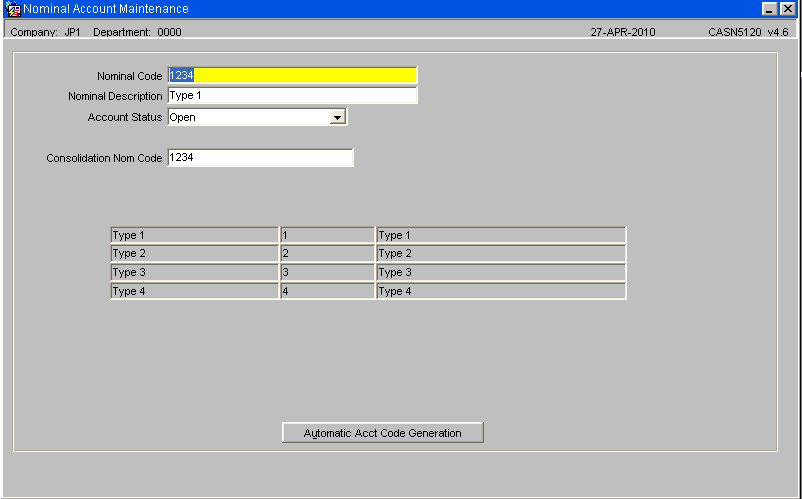
Enter a nominal code (A) of '1234', the rest of the information should default in, and save.
| Field Name | Description | Options | Generic Value |
|---|---|---|---|
| Nominal Code ** | The nominal code for the company | 1234 | 1234 |
| Nominal Description ** | The description for the nominal code | 35 character free text field | Defined by the client |
| Account Status ** | The status of the account | Open | Open |
| Closed | |||
| Closed by Segment Close | |||
| Consolidation Nom Code ** | The nominal code used when consolidating accounts | 1234 | 1234 |
| Alt Currency Code | The alternative currency code for this nominal master | Display only - will default to blank | Blank |
| Reconciliation Tick ** | Determines whether this nominal code will be used for accounting reconciliation (not migrated) | Y or N - display only | N/A |
| The remaining fields are display only and will default to those previously setup | |||
LEDGER MAINTENANCE (CASN5020)
Possible Error 1
From this point on most of the screens set up need to have the user set up fully to enter more information. This is mainly the ledger information under the new company but it will shortly include the owner and warehouse information as well. The following error screen will show that the user now needs to be completed fully.
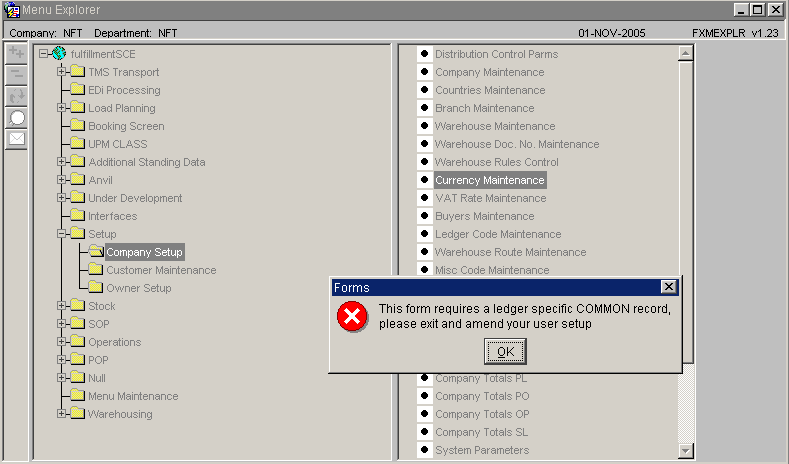
Before this can be completed to ledgers PL1 and SL1 may need to be added.
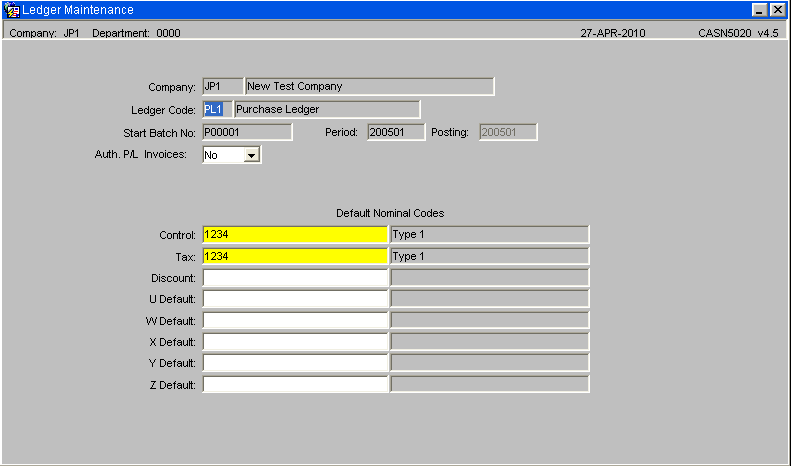
Enter the purchase ledgers PL1 and SL1 as above and save.
| Field Name | Description | Options | Generic Value |
|---|---|---|---|
| Company ** | The company code you need to assign the ledger codes against | Must have been created in company codes maintenance - LOV available | Defined by the client |
| Ledger Code ** | The ledger codes to be assigned to the company (note, you will need to set one record up for each of the following ledger codes) | PL1, SL1, SYS, ACC, REV | PL1, SL1, SYS, ACC, REV |
| Start Batch No | The starting control number for this ledger code | P00001, S00001, S00001, A00001, R00001 | P00001, S00001, S00001, A00001, R00001 |
| Period | The period the ledger code will run from | YYYYMM format | Defined by the client |
| Cleardown Period | The period a cleardown will run for (not used by the wms) | 0 | 0 |
| Auth Invoices | Does this ledger code need authorisation during invoicing? | Y or N - will default to N | N |
The remaining fields are not required by the WMS.
CURRENCY MAINTENANCE (CASN5060)
This is the currency maintenance screen.
Ensure that the first currency that you enter for the new company is to be the base currency as this is the way that it will be saved becoming the default currency for the company.
Enter the company
Ensure the Relation position is Base Unit
Currency and description
Nominal account
Then tab through the rest of the fields until the record is created
| Field Name | Description | Options | Generic Value |
|---|---|---|---|
| Company ** | Company code the currency will apply to | Predefined in company maintenance | Predefined 3 ch code |
| Currency ** | Currency code and name denoting specific currencies | 3 ch text field followed by 30 character currency description | Various |
| Relation Preference ** | Denotes whether the currency code will be a base unit or currency unit | Base Unit or Currency Unit | Currency Unit |
| Bank Acct | Pulled in from company maintenance if setup | Prepopulated | Defined by client |
| Exch Gain ** | Based on the nominal ledger setup - the nominal code entered here will define the exhange and gain rate | Predefined in nominal master maintenance | 1234 |
| Exch Loss ** | Based on the nominal ledger setup - the nominal code entered here will define the exhange and gain loss | Predefined in nominal master maintenance | 1234 |
| Rate Change Tol ** | The tolerance at which an exchange rate can be changed | 0 - 100 | Defined by the client |
| Exchange L/G | The loss and gain rate that can be applied to the exchange rate | 0 - 100 | Defined by the client |
| Mother Currency | The parent currency code for this currency | Blank | Blank |
| Date Entered | The date the currency code was created | Must be a valid date or left blank | Blank |
| Valid Until | The date the currency code will be valid til | Must be a valid date or left blank | Blank |
| Delete Flag | Is this currency code marked for deletion? (If checked, this currency code can no longer be used) | Checked or left blank | Blank |
| ISO Code | The standard ISO code for this currency | 3 character free text field or left blank | Defined by the client |
| Unit Factor ** | The factor by which the currency will be divided by (not used by the wms) | 1, 10, 100, 1000, 10000 | 1 |
| No. of Decimals (EDI) | The number of decimal places the exchange rate for the currency code will be displayed in within the edi message (not used by the wms) | 2 digit numerical field or left blank | Blank |
| Date | The date of the exchange rate | Must be a valid date - once entered, cannot be amended | Defined by the client |
| Base Unit | The base exchange rate for the currency | Will default to the exchange rate set up against the company | Display only |
| Currency Unit | The rate by which the exchange rate will be multiplied for each unit | 0 - 99999999.9999999999 | Defined by the client |
You can view and enter bank details using the Bank Details button.
A new pop-up window titled "Bank Details" (BNKDETAILS v1.3) appears.
This window displays the following fields:
- Currency
- Bank Code
- Bank Name
- Account No
- SWIFT
- IBAN
- Bank Key
- Branch Code
- Branch Name
- Account Type
- Description
- Beneficiary
- Country Code
The window may instead display Bank Maintenance fields as follows:
- Nominal Code
- Description
- Bank Name
- Address 1
- Address 2
- Address 3
- Address 4
- Postcode
- Bank Tel No
- Bank Fax No
- Sort Code
- Branch Code
- Branch Name
- Account Type
- Beneficiary
- Country Code
The window is populated with data for the selected currency.
The following summarises the details that are required for Owner Invoicing:
Note that the following BANK information can be held for any / all currencies used by the company.
- Bank Name
- Bank Account number
- Payment address
- Bank Giro number
- Postgiro number
- IBAN (International Bank Account Number)
- SWIFT code
Similarly, this detail relates to the Company Bank details and the various account codes utilised. Separate details are expected for each Currency code that the Company will utilise.
These details will be printed at the bottom of each invoice produced.
You then click the Return button to close the "Bank Details" window.
ISO COUNTRIES MAINTENANCE (PFS1004)
Ensure all required countries are set up on the ISO countries file, if one you require is missing then add it.
| Field Name | Description | Options | Generic Value |
|---|---|---|---|
| ISO Code | Two-letter country code as defined in ISO 3166 Standard alpha-2 | Can be manually maintained, though the original file will be created as part of the system delivery | As specified in the ISO 3166 Standards |
| Three-letter country code | Which allow a better visual association between the codes and the country names than the alpha-2 codes | Can be manually maintained, though the original file will be created as part of the system delivery | As specified in the ISO 3166 Standards |
| Name | Name of the country associated to the code | Can be manually maintained, though the original file will be created as part of the system delivery | As specified in the ISO 3166 Standards |
COUNTRIES MAINTENANCE (PFS1002)
Once the country has been entered in to the ISO countries code, it is necessary to create a country maintenance record.
This is done as below.
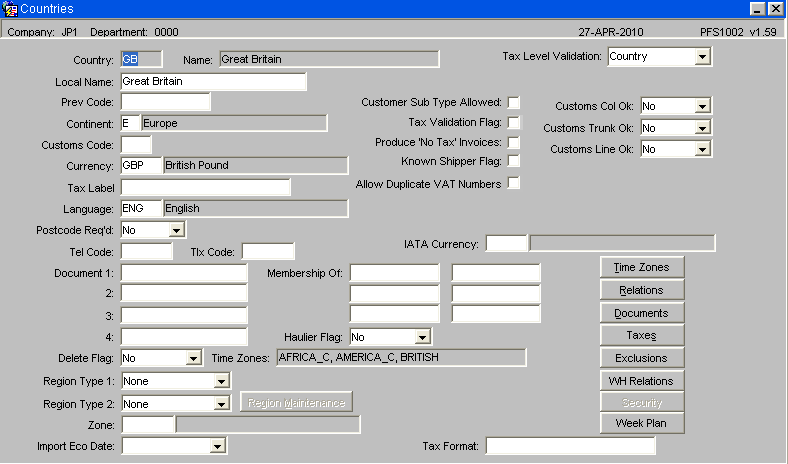
| Field Name | Description | Options | Generic Value |
|---|---|---|---|
| Country Code ** | ISO country code - normally 2 chs in length - allows up to 3 | Predefined by the client as to which countries they need to set up - must have been created as an ISO country code | Defined by the client |
| Local Name ** | Country name | Max 30ch country description | Defined by the client |
| Currency ** | Currency code of the country | Predefined in currency codes maintenance | Defined by the client |
| Region Type 1 ** | The region type for this country (not used by the WMS) | None, State, County, Province | None |
| Region Type 2 ** | The 2nd region type for this country (not used by the WMS) | None, State, County, Province | None |
| Tax Level Validation ** | The base level at which tax is applied | Country, Department | Country |
| Customs Col OK ** | Is customs consolidation allowed? | Y or N | No |
| Buttons | |||
| Time Zones | Takes the user to an additional screen to assign a time zone to the country (see below) | ||
| WH Relations | Takes the user to an additional screen to enter client specific invoicing and export information (see below) | ||
VAT CODES MAINTENANCE (CASN5130)
This is the VAT Codes Maintenance screen.
| Field Name | Description | Options | Generic Value |
|---|---|---|---|
| Vat Code ** | The code used to determine what VAT rate will be applied | 2 character free text field | Defined by the client |
| Vat Description | The description of the vat code | 25 character free text field or left blank | Defined by the client |
| Vat Rate ** | The percentage to be applied against this vat code | 0 - 999.99 | Defined by the client |
NEXT STEP
Once the above set up has been completed it will be possible to create the required warehouse, customers, suppers, owners, stock, users etc for the company.
Warehouse Set-up
This section describes the required screens to be used in setting up the information concerned with the actual physical warehouse. Other guides describe the set up of company, user, stock, owners etc.
This is a generic guide based on the version of the CALIDUS WMS system at the time of writing.
It can also be used by clients to specify their specific data values to aid initial system set up as well as for future reference.
![]() Note: Fields marked '**' are mandatory and are needed to ensure correct set up of the system.
Note: Fields marked '**' are mandatory and are needed to ensure correct set up of the system.
Warehouse Setup Steps
In order to create a warehouse, the user must set the standing data up in a pre-defined order. As most of the screens are co-dependant, any missed step may cause the setup of a following screen to fail.
![]() Note: All screens shown in this user guide will display a default generic set up.
Note: All screens shown in this user guide will display a default generic set up.
- Warehouse Maintenance (STKWHSE01A)
- System Parameters (WHS0010)
- Area Codes Maintenance (WHS0035)
- Aisle Codes Maintenance (WHS0050)
- Aisle Sequence Maintenance (WHS0060)
- Aisle Status Maintenance (WHS8231)
- Pallet Types Maintenance (WHS0045)
- Location Types Maintenance (WHS0070)
- Location Maintenance (WHS0090)
- Automatic Location Maintenance (WHS0470)
- Reason Codes Maintenance (WHS0080)
- Employee Maintenance (WHS0020)
- System Reason Codes Maintenance (WHS0085)
- Transaction Types Maintenance (CTLTRAN01A)
- Receipt Types Maintenance (WHS4000)
- Truck Type Maintenance (WHS7020)
WAREHOUSE MAINTENANCE (STKWHSE01A)
Warehouse Maintenance (STKWHSE01A)
This is the main screen where the warehouse id is set up. Note, in order to allow changes within this screen, the user must have logged in as this warehouse.
Warehouse specific information is maintained in this screen. The above set up is the generic set up for a basic warehouse. Please see information at the end of this user guide for more details on the client specific flags
Note:
- Greyed-out fields means no entry in that field is allowed
- A yellow field means this field is mandatory – something has to be entered before the record can be saved
- A field with an arrow against it allows the user to choose from a number of options. A drop down box appears when the arrow is clicked on
- The ‘Warehouse ID’ field is greyed out. This field will display the warehouse id entered. No amendment is allowed
- The country codes are maintained in country codes maintenance. See the Company Maintenance user Guide for details
- Copy Warehouse enables the user to copy the set-up in this warehouse to another existing warehouse
- The Warehouse Rules button takes the user to another screen. Note. Warehouse rules are maintained within the Company Maintenance User Guide
Copy Warehouse (STKWHSE01A)
Enables the user to copy the set-up in this warehouse to another existing warehouse id.
Note:
- From Warehouse: Display Only and is pulled from the Main Warehouse Maintenance Screen
- Warehouse ID: Maximum of 3 Characters
- When all the required information has been entered, the ‘Create Warehouse’ Button needs to be pressed in order for the New Warehouse to be Created
Warehouse UOMs (STKWHSE01A)
You can maintain the UOMs for Area, Length, Volume and Weight here.
This enables the different types of measure and their associated unit. If volumetric information is not required all values can be left blank.
![]() Note: It is advisable to not use the values 'MM'(millimetres) and 'GRM'(grammes)as it very easy to exceed the system maximums for these values. Areas affected include Allocation and EDI.
Note: It is advisable to not use the values 'MM'(millimetres) and 'GRM'(grammes)as it very easy to exceed the system maximums for these values. Areas affected include Allocation and EDI.
Warehouse Rules (WHS0078)
Warehouse rules are established as part of the development of the system functionality. The ability to specify which specific functionality is to be enabled in the warehouse and give any specific values is given in this screen.
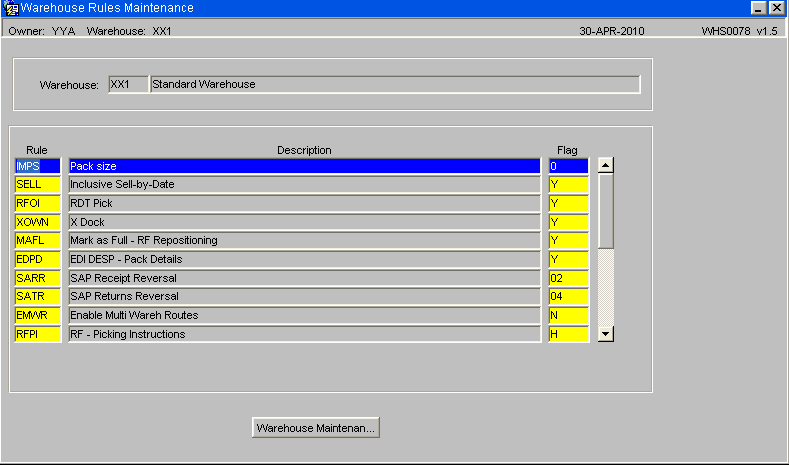
| Field Name | Description | Options |
|---|---|---|
| Four Character Code as Held in Warehouse Rules Control | Description of rule controlled functionality | Value to enable functionality |
SYSTEM PARAMETERS (WHS0010)
System Parameters (WHS0010)
This screen maintains all the static formats that will be used to set up the warehouse. There are three tabs in all. This page will detail the setup required within the MAIN tab.
Warehouse specific information is maintained in this screen. The above set up is the generic set up for a basic warehouse. Please see information at the end of this user guide for more details on the client specific flags
Used to specify a number of parameters that will govern the way the system will operate and how various items of information will be formatted in this warehouse.
Note, again, the user must be logged in as the correct warehouse in order to make changes
Note:
- Auto Log Display determines whether the user wishes to see the allocation log once a set of orders has been allocated
- Pick Note and Pal Move Lines specifies the number of lines allowed on a printed pick or move note
- The Area, Aisle, Bay and Level lengths are used to determine the format of the location codes. I.E. A location code of AA-01-1A would have an aisle, bay and level length of 2 each (the area code is not included)
- Max. Rotation Length is the length of the system generated rotation number
- Loc Delimiter is the symbol used to separate the aisle, bay and level within the location code (for our example, the delimiter would be ‘-’
- The Rotation Type is how the system generates the rotation number, or whether it is to be manually entered by the user.
- Reduce Stk At will determine when stock is downdated during the order cycle. Note, this is extremely important, if you choose ‘Pick Confirmation’ Despatch will not be feasible .
GOODS IN TAB
The Goods In tab of the System Parameters screen specifies what functionality during goods receipt you wish to use.
Note:
- The Auto Putaway flag must only be set to ‘Y’ if you wish the system to dictate where stock is located during the goods receipt process
- The Opposite and Next Aisle Param fields are to determine how many locations you wish the system to search before moving to the next, or opposite aisle during Auto Putaway
- The Hold Stk until Putaway flag should always be set to ‘Y’ If this is not set, stock received on a goods receipt could be ordered before it has been physically located within the warehouse
DEFAULT LOCATIONS TAB
The Default Locations tab is used to determine which locations are to be used during certain automatic processes throughout the system.
Note, this screen cannot be set up until the location codes have been created. The user normally saves the first two tabs of System Parameters, then returns to complete this tab once the necessary locations have been created
Note:
- Only the Default Marshalling Location is used within generic basic warehouse set-up. Any other locations required will be determined by the client specific processes
- Note, failure to enter a marshalling location here will mean that it will be required to be manually entered for each allocation run.
AREA CODES MAINTENANCE (WHS0035)
The creation of an area code is to enable the user to assign locations to a specific physical area within the warehouse. Note, bigger warehouse will have more clearly defined areas than that of a smaller operation.
These codes are used as part of the location identifier as well as in sorting pick lists, structuring stock take etc..
Note:
- The code specified must be within the area code length defined in system parameters main tab
- The description is used to enable the user to clearly see where the area is within the warehouse
AISLE CODES MAINTENANCE (WHS0050)
Aisle Codes Maintenance enables the user to create aisles within the warehouse.
The aisles can then be configured using the opposite and next aisle fields to specify where they are physically located in relation to each other.
These codes are used as part of the location identifier as well as in sorting pick lists, structuring stock take etc..
Note:
- The Aisle Code entered must be within the defined length as set up in system parameters
- The Opp and Next Aisles can only be created once the original aisle code is set up
- The Aisle Max Sequence is used to determine the number of locations within that aisle.
AISLE SEQUENCE MAINTENANCE (WHS0060)
In this screen the user can configure the sequence in which the aisles will be used. For Bulk aisles such as Marshalling and Quarantine the maximum sequence is used as these do not follow any algorithm.
This screen needs to be maintained if using the auto-putaway at receipt. It will determine the priority and order of aisles to be received into.
![]() Note:
Note:
- Link an aisle to an area code, and assign a unique sequence.
- All aisles created within Aisle Codes Maintenance must be entered in this screen.
AISLE STATUS MAINTENANCE (WHS8231)
In order to make the aisle available to the system, all aisle codes to be used must be set to available. Note, the default on entry within the screen is No.
Used to indicate if a given aisle is actually currently in use or is available. Used in the event of physical access problems etc. The screen is used with the RF system.
Note:
- The system will automatically default in all aisle codes previously set up. The user then simply has to change the Available Flag from N to Y for each one.
PALLET TYPES MAINTENANCE (WHS0045)
All pallet types used within the warehouse are to be maintained in this screen. Pallet type by definition is the media used to store goods within each location. Media can include such things as wooden pallets, plastic storage boxes or cartons.
Note:
- Pallet Type is a free text field that can hold up to four characters. The user should ensure that the abbreviation used can be easily understood by the operational staff.
- The mandatory height, weight and %fill fields must be populated with the correct values in order to ensure the accuracy of auto-putaway
TRUCK TYPES MAINTENANCE (WHS7020)
Mainly used for RF enabled warehouses, this screen determines what kind of truck can be used around the warehouse. The truck types entered here can then either be added into location types maintenance, or entered onto a handheld RDT when processing.
![]() Note:
Note:
- The Truck Type entered must be 2 characters long
- Intrinsically Safe identifies whether the truck is considered safe for use with Flammable goods stored in flammable aisles.
- The Send button will refresh the WCS with all truck types, their description and the intrinsically safe information.
LOCATION TYPES MAINTENANCE (WHS0070)
The Location Types screen is used to build the locations within the system.
Location Types - Locations Tab
Here the user specifies what kind of location is in each aisle.
For example, some racking maybe narrower in certain sections, meaning the number of pallets allowed in each bay is reduced.
To make this clear, a different location type would be assigned to each location.
For each location type, the maximum number of pallets and the type of pallet allowed is then given to each location type.
The user can then assign a priority to when using auto-putaway, the system uses priority 1, then 2 etc.
Location Types - Pallet Details Tab
Used to specify what pallet types can be used in a given location type.
![]() Note:
Note:
- In order to use the pallet details tab, the user must enter 'Y' in the Pallet Storage field. Entering 'N' will cause the location type to be seen as non-palletised and therefore not use-able for any stock stored on a pallet.
- The maximum storage is the number of pallets allowed in that location. For auto-putaway, the system will stop using that location once this maximum storage quantity has been exceeded.
Location Types - Truck Details Tab
The Location Truck types are required to define the access of trucks to this location type, for use within the WCS.
![]() Note:
Note:
- In order to use the truck details tab, the user must enter 'Y' in the Truck Types field.
- The Send button will refresh the RF system with all Location/Pallet Details/Truck Type information. Any additions or changes are automatically sent to the RF system on saving changes or a adding a new record.
LOCATION CLASS MAINTENANCE (WHS8056)
Used to assign a particular product classification to ranges of locations. Used by putaway to store products in relevant areas of the warehouse especially where segregation may be required.
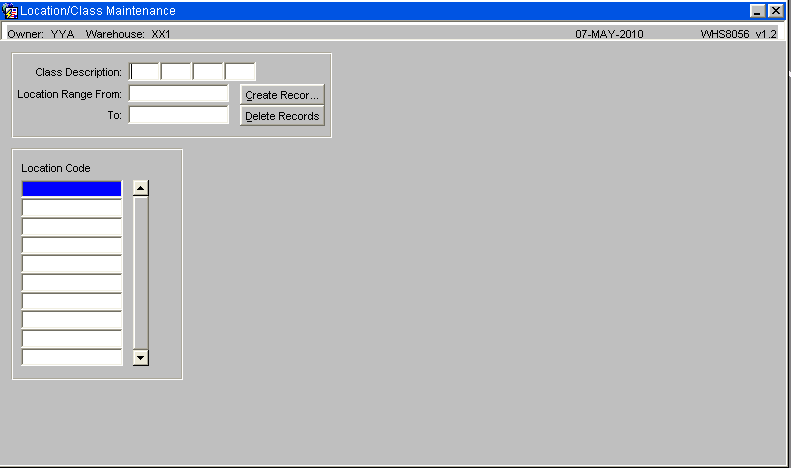
![]() Note:
Note:
- Product classification is maintained with Stock Maintenance.
- It is possible to assign either a range of locations or to add and remove on a location by location basis.
LOCATION CODES MAINTENANCE (WHS0090)
This is the manual screen that allows the user to create each location code within the warehouse. The non-mandatory fields (not yellow) will be defaulted with the values shown in the figure below.
If using the Automatic Location Maintenance screen, the Marshalling location must be created in order to enter this into the Default locations of System Parameters.
Note:
- The location code specified must be the total length of the aisle, bay and level code lengths defined in system parameters, main tab
- The area code must be one predefined in area codes maintenance
- The use determines what the location will be used for.
Standard values are:
- 0 - Preadvice Location
- 1 - Bulk Location
- 2 - Pick Location
- 3 - Receipt Location
- 4 - Returns Location
- 5 - Damaged Stock Location
- 6 - Marshalling Location
- 7 - Goods In/Out Bay Location
- 8 - Quarantine Location
- 9 - Replenishment Location
- D - Dynamic Pick Face
- M - Multi-Pallet Storage Location
- P - P&D (Pick and Drop) Location
- U - Units Pick Location
The Multi-Deep values specify how an M type location is used and validates:
- Position - one of
- Front
- Back
- Non-Linked
- Use - one of:
- 4 - Valid pallets contain the same stock, batch number and owner batch
- 5 - Valid pallets contain the same stock.
- 6 - Valid pallets contain the same stock and sell-by date.
- 7 - Check the last receipt location for pallets containing the same GRN and stock.
- 8 - Valid pallets contain the same stock and manufacturing date
- Linked Loc - if front or back, which location is this location linked to.
AUTOMATIC LOCATION MAINTENANCE (WHS0470)
This screen allows the user to create large quantities of locations in one screen.
It is easier and quicker than using the manual location codes maintenance.
Used to automatically create contiguous ranges of locations. This screen allows the user to automatically create large quantities of locations in one continuous range. It is easier and quicker than using the manual location codes maintenance.
![]() Note: To prevent unexpected locations being created, deleted or amended it is advisable to restrict the selection parameters to an aisle as a time.
Note: To prevent unexpected locations being created, deleted or amended it is advisable to restrict the selection parameters to an aisle as a time.
Fields:
- The Run Type field has four options, Create, Delete, Release and Suspend. Suspend and Release only hold and release locations respectively, they do not delete them.
- The Area for Aisle must be one predefined in Area Codes maintenance
- The Location Type must be one predefined in Location Type maintenance
- Location Usage is the use type of the location (1,2,6 or 8 as explained in the Location Codes Maintenance page)
- Bonded, default is always N
- RDT. This flag is only to be used if the locations are to be RF enabled. Default is N
- Start and End Location. This is the range of locations to be created. Note, care must be taken when entering the range, especially if using different types/uses.
Once entered, you can click the Generate button to generate locations according to the template parameters provided.
EMPLOYEE MAINTENANCE (WHS0020)
This is where the employee codes are set up. Each person using the system or working in the warehouse need to be assigned an employee code.
Note:
- Employee Code: Although the field allows up to 10 characters, only a maximum of three can be used if the system is RF enabled
- All fields other than Employee Code can be left blank. However, the Name should always be populated for cross referencing in the future.
- The Send button will refresh the RF system with all employee detail information. Any additions or changes are automatically sent to the RF system on saving changes or adding a new record.
REASON CODES MAINTENANCE (WHS0080)
This is used to establish all of the Reason Codes that may be selected when performing a stock management transaction within the warehouse.
Reason Codes are two character abbreviations used to describe why a particular action within the system has been taken.
For example, reason codes needs to be entered for every stock adjustment, hold and pick adjustment.
Whether a reason code is to be used to hold stock or not, determines whether the hold code flags are set to Y or N.
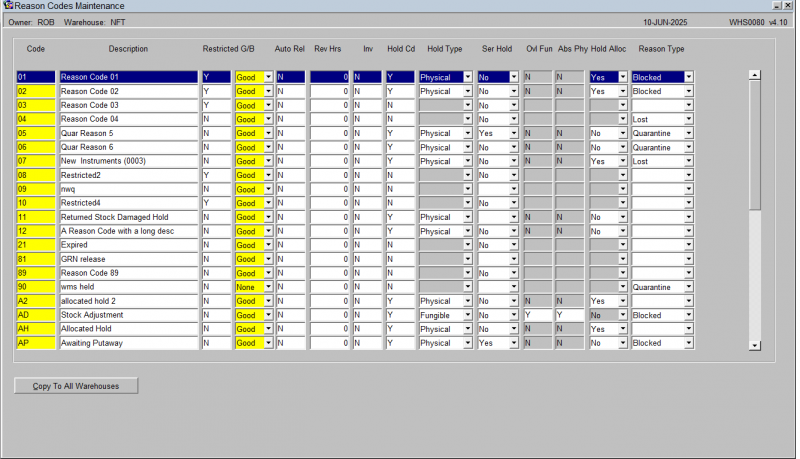
![]() Note:
Note:
- The codes used to describe an adjustment must be clearly understood by the operational staff as the Description entered here is not shown throughout all of the screens during processing.
- The G/B field determines whether a reason code is good or bad. This functionality is mainly used within Sales Order Processing (Proof of Delivery) to determine whether stock should be written off or not.
- The user may see a different layout to this screen than the one shown here. This is based on a Program level registry setting 'WHS Layout Visible' under WHS0080. The versions shown here is the generic screen.
- The Send button will refresh the RF system with all employee detail information. Any additions or changes are automatically sent to the RF system on saving changes or adding a new record.
SYSTEM REASON CODE MAINTENANCE (WHS0085)
This screen does not have to be set up.
However, during various processes, the system dictates its own hard-coded reason codes.
As there is no table to specify what these codes mean, this table can be used to ‘translate’ a system generated reason code.
For example, after Receipt Confirmation has been completed, the system automatically puts stock on hold with a reason code of ’90’.
When querying the product, all the user will see is an unknown number.
‘AP’ is created in reason codes maintenance and assigned to System Code ’90’
For all future queries, the user will then see a more recognizable ‘AP’.
Note:
- The System Code is the one generated by Calidus 3pl. For a full list, please see your representative from Aptean.
- The Reason Code must have been previously set up in Reason Codes Maintenance.
Below is the current list of System Reason Codes from the time of writing, these will be added to as the system is developed.
| Reason Code | Description |
|---|---|
| 5M | RF Ad hoc stock move |
| 6A | Allocation shortage |
| 73 | Rework |
| 74 | Allocation Hold Code |
| 75 | EDI serial (approve/reject) |
| 81 | Goods putaway confirmation |
| 82 | Pallet movement confirm - from |
| 83 | Subcontracting order |
| 84 | Stock movement confirm - from |
| 85 | Stock movement confirm - to |
| 86 | Awaiting review |
| 87 | Quality inspection hold |
| 88 | GRN reversals |
| 90 | Received awaiting putaway |
| 92 | Auto quarantine of stock |
| 93 | Pallet movement request - from |
| 94 | Pallet movement request - to |
| 95 | Held in damaged location |
| 96 | Under delivery |
| 97 | Damaged prior to receipt |
| 98 | Over delivery |
| RT | Held in returns location |
The user reason codes are configurable but MUST have reason codes that match the link items in the system reason code table, reference the example data below.
| Reason Code | Description |
|---|---|
| DA | Damaged Stock |
| 90 | Awaiting Putaway |
| 6A | Scrap item |
| QA | Quality - Assurance |
| QH | Quality - Hold Stock |
| RT | Rerurned Stock - Auto Hold |
| 81 | Stock Putaway |
| ** | Stock Take Adjustment |
| 19 | Stock Take - Decrease |
| 20 | Stock Take – Increase |
| R1 | Reserved Stock |
RECEIPT TYPES MAINTENANCE (WHS4000)
When processing a goods receipt, or requesting reports regarding receipts, a Receipt Type is requested. This is used to separate different kinds of receipts for ease in future queries.
Note:
- The Receipt Type entered must be 3 characters long.
- Generic types are REC (Receipt), RET (Return), and PUR (Purchase Order).
TRANSACTION TYPES MAINTENANCE (CTLTRAN01A)
This screen only has to be amended/created if wanting to use the Transactions Report. The system will automatically generate the Transaction Types when processing. Note, some of the Transaction Types are already created when opening this screen. The values below are the default types.
![]() Note:
Note:
- The Transaction denotes each system or user generated transaction type during all processes
- The Interface flag is used is client specific EDI Processing
Owner Set-up
Owner Maintenance
This document describes the required screens to be used in setting up the information concerned with the Owners of stock in the warehouse. Other guides describe the set up of company, user, warehouse, stock etc.
This is a generic guide based on the version of the CALIDUS WMS system at the time of writing.
It can also be used by clients to specify their specific data values to aid initial system set up as well as for future reference.
Note that fields marked '**' are mandatory and are needed to ensure correct set up of the system.
Owner Maintenance - Main Tab
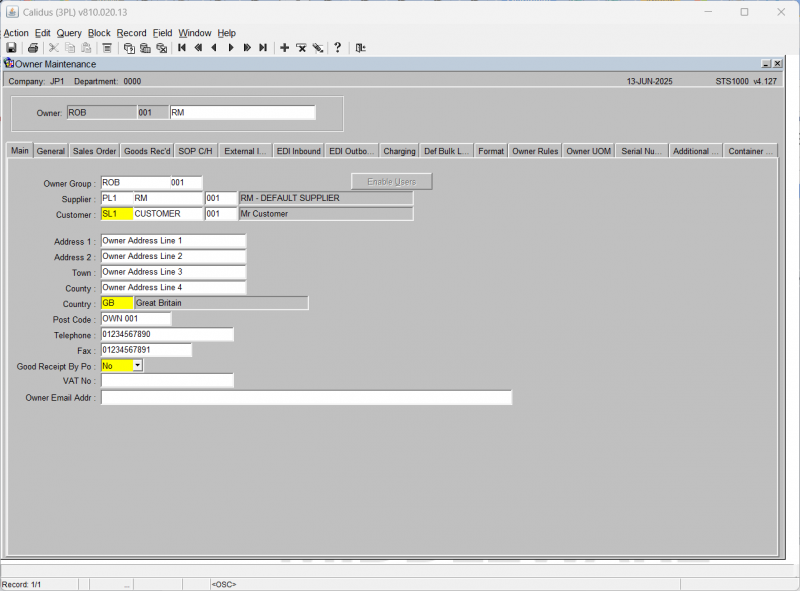
| Field Name | Description | Options | Generic Value |
|---|---|---|---|
| Owner ** | Owner code - note, in order to setup an owner from scratch or to make any amendments or changes to the parameters within this screen - you must have registry setting 'OwnerSuperUser' set to '1' | 10 character free text field - note, for RF and other processing, the owner code must only be 3 characters - LOV available in query mode | Defined by the client |
| SubCode ** (not labelled) | Sub code of the owner - this allows the user to have the same owner code with multiple entries, however, the standard is always '001' | 3 character free text field | 001 |
| Description (not labelled) ** | The name of the owner | 30 character free text field | Defined by the client |
| Owner Group ** | Used for EDI reporting purposes, the ability to group multiple owners under one owner. This then becomes the master and the 'owner group' - (not migrated) | Must exist in owner maintenance - will default to current owner code - LOV available | Defined by the client |
| Supplier - 1st field - ledger code ** | Ledger code associated with the supplier | Must have been created in ledger codes maintenance and assigned to the user id - always PL1 | PL1 |
| Supplier - 2nd field - supplier code | Default supplier for the owner - this can be used at goods receipt to automatically default in this supplier code at pre advice | Must have been created in partners maintenance - LOV available | Defined by the client |
| Supplier - 3rd filed - supplier sub code | The sub code for the default supplier for the owner | 001 or left blank | Defined by the client |
| Customer - 1st field - ledger code ** | Ledger code associated with the customer | Must have been created in ledger codes maintenance and assigned to the user id - always SL1 | SL1 |
| Customer - 2nd field - customer code | Default customer for the owner | Must have been created in partners maintenance or customer wizard - LOV available | Defined by the client |
| Customer - 3rd filed - customer sub code | The sub code for the default customer for the owner | 001 or left blank | Defined by the client |
| Address 1 | The first line of the address for the owner | 30 character free text field or left blank | Defined by the client |
| Address 2 | The second line of the address for the owner | 30 character free text field or left blank | Defined by the client |
| Town | The town in which the owners address is situated | 30 character free text field or left blank | Defined by the client |
| County | The county in which the owners address is situated | 30 character free text field or left blank | Defined by the client |
| Country ** | The country in which the owners address is situated | Must have been created in country codes maintenance - LOV available | Defined by the client |
| Post Code | The post code for the owners | 10 character free text field or left blank | Defined by the client |
| Tel | The tel no for the owners address | 20 character free text field or left blank | Defined by the client |
| Fax | The fax no for the owners address | 14 character free text field or left blank | Defined by the client |
| Goods Receipt by PO | Defines whether receipts by purchase orders are required (not migrated) | Y or N | N |
| VAT No | The VAT number | Lookup | |
| Owner Email Addr | Owner's email address |
Owner Maintenance - General Tab
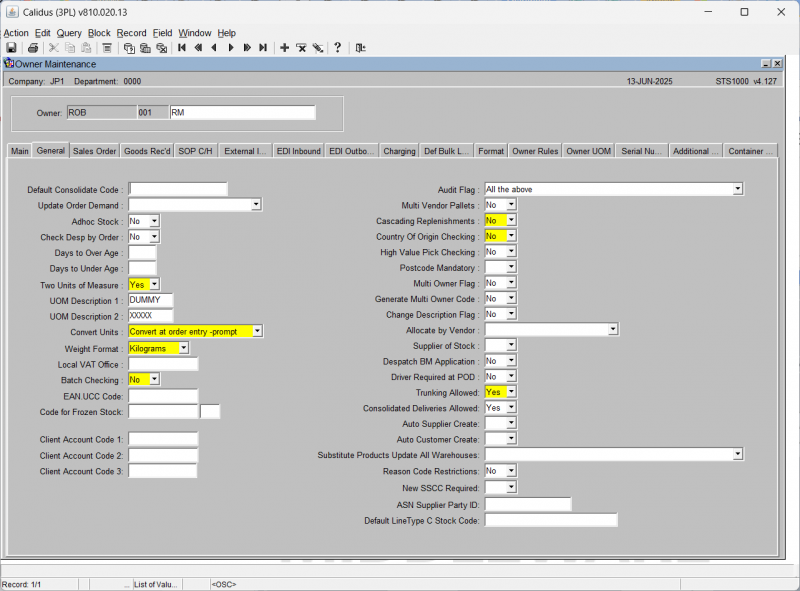
| Field Name | Description | Options | Generic Value |
|---|---|---|---|
| Default Consolidate Code | Allows you to enter a code which will validate against the owner's receipts and orders to be consolidated from collection no. or advice note and order header details - client specific (not migrated) | None | Blank |
| Update Order Demand | Allows you to update the order demand records (used for reporting purposes) - not migrated | 1 - Update with ordered quantity 2 - Update with pick confirmed quantity or left blank |
Blank |
| Adhoc Stock | If set to 'Y', allows the user to be automatically taken into the stock set up screen if they enter a product that does not exist (not migrated) | Y or N or left blank | Defined by the client |
| Check Desp by Order | Enables the prevention of despatching orders on a route load individually | Y, N or left blank | Defined by the client |
| Days to Over Age | As per the same stock fields, this states how many days the product is in the warehouse before it is over age (see stock maintenance guide for details) - this value will apply to all products for this owner (not migrated) | 0 - 999 or left blank | Blank |
| Days to Under Age | As per the same stock fields, this states how many days the product is in the warehouse before it is under age (see stock maintenance guide for details) - this value will apply to all products for this owner (not migrated) | 0 - 999 or left blank | Blank |
| Two Units of Measure ** | Dictates whether the owner will be using cases and units, rather than just cases | Y or N | Defined by the client |
| UOM Description 1 | Description of the highest unit of measure to be used if two units of measure flag is set to Y (not migrated) | Must have been set up in unit of measure maintenance or left blank - LOV available | Blank |
| UOM Description 2 | Description of the lowest unit of measure to be used if two units of measure flag is set to Y (not migrated) | Must have been set up in unit of measure maintenance or left blank - LOV available | Blank |
| Convert Units ** | Specifies whether, if using two units of measure, you wish the system to explode the number of units into cases | N - Do not convert units to cases Y - Convert at order entry - Prompt E - Convert at order entry - do not prompt |
Defined by the client |
| Weight Format ** | The default weight for the owner | Must exist on the ml_captions table for weight_format | Defined by the client |
| Local Vat Office | Specifies the reference number for the location VAT office | 10 character free text field or left blank | Blank |
| Batch Checking ** | Do you require the system to do an additional check on batch quantities. I.e. for stock adjustments, the user will be prompted for a batch amount - the adjustment will not be completed until the amount adjusted = the batch amount (not migrated) | Y or N | N |
| Audit Flag ** | Determines what auditing records the system will keep. This will note changes to the various records for future reference (partially migrated) | 0 None 1 Stock and Owner 2 Bonded Stock and Bonded Owner 3 Stock Records Only 4 Owner Records Only 5 Bonded Owner and Owner 6 Bonded Stock and Stock 7 All the above - will default to 'Stock and Owner' |
1 |
| EAN.UCC Code | Used for SSCC number/label production - this client specific company prefix number is used within the SSCC autogenerated number | 10 character free text field or left blank | Blank |
| Code for Frozen Stock | A field for a 'virtual owner' code to be used to allow changes of state of stock by 'change of ownership' (i.e. frozen to chilled etc) without using a product level flag | 10 character free text field plus sub code field or left blank | Blank |
| Multi Vendor Pallets | Specifies whether the owner will have more than one supplier - this will flag for a supplier code to be entered at all positive additions to stock quantities (not migrated) | Y or N | N |
| Client Account Code 1 | Client specific additional reference code for the owner | 10 character free text field or left blank | Blank |
| Client Account Code 2 | Client specific additional reference code for the owner | 10 character free text field or left blank | Blank |
| Client Account Code 3 | Client specific additional reference code for the owner | 10 character free text field or left blank | Blank |
| Cascading Replenishments ** | Does the owner use cascading replenishment. This is used if the owner has multiple uoms and wishes to cascade the replenishment to each one i.e. unit to box, box to case, case to pallet and back down again (not migrated) | Y or N | N |
| Country of Origin Checking ** | Determines whether the system will force the user to validate the country of origin during processing (not migrated) | Y or N | N |
| High Value Pick Checking ** | Are high value check digits required prior to pick confirmation? (not migrated) | Y, N or left blank | Blank |
| Postcode Mandatory | Is the postcode to be mandatory for customers address? (not migrated) | Y, N or left blank | Blank |
| Multi Owner Flag | Is this owner a multi owner or not. If set to Y, can be used to enable multi owner ordering under one owner i.e. if one product exists under 2 owners, an order placed under this owner would allow allocation from either (not migrated) | Y, N or left blank | Blank |
| Generate Multi Owner Code | If the owner is a multi owner, should the system generate a multi owner reference? (not migrated) | Y, N or left blank | Blank |
| Change Description Flag | Determines whether, if copying a product to a new product, whether the product description can be changed | Y, N or left blank | Blank |
| Allocate by Vendor | If allocate by vendor = 1 or 2, the system will prompt you for a supplier on order entry. If there is insufficient stock for this stock/supplier combination, (even if there is stock for a different supplier) the allocation will fail (not migrated) | 0 - Do not allocate by supplier 1 - Allocate-update for types 1-8 2 - Allocate-update for all types or left blank |
Blank |
| Supplier of Stock | If this flag is set to 'Y', the system will prompt for a supplier at goods receipt (not migrated) | Y, N or left blank | Blank |
| Despatch BM Application | Determines whether a BM application number is required at despatch - client specific (not migrated) | Y, N or left blank | Blank |
| Driver Required at POD | Specifies whether, at POD confirmation a drivers name is required (not migrated) | Y or N - will default to No | No |
| Trunking Allowed ** | Used in conjunction with the waybill screen, specifies whether orders can be Mantled (Mantling relates to a delivery to an intermediate distribution centre before the individual shipments are separated according to their end delivery points) - the waybill screen will check this flag to see if this process is required | Y or N | Defined by the client |
| Consolidated Deliveries Allowed ** | Used in conjunction with the waybill screen, specifies whether orders can be Samtaxered (Samtaxering relates to the grouping of multiple orders for the same delivery point and the subsequent production of one Waybill) - the waybill screen will check this flag to see if this process is required | Y or N | Defined by the client |
| Auto Supplier Create | Option select Yes or No | Defined by the client | |
| Auto Customer Create | Option select Yes or No | Defined by the client | |
| Substitute Products Update All Warehouses | No - Changes only apply to current warehouse
Prompt - ask user before applying changes to all warehouses. Yes - Automatically apply changes to all warehouses. |
Defined by the client | |
| Reason Code Restrictions | Yes or No | Defined by the client | |
| New SSCC Required | Yes or No | Defined by the client | |
| ASN Supplier Party ID | Defined by the client | ||
| Default Line Type C Stock Code | Defined by the client |
Owner Maintenance - Sales Order Tab
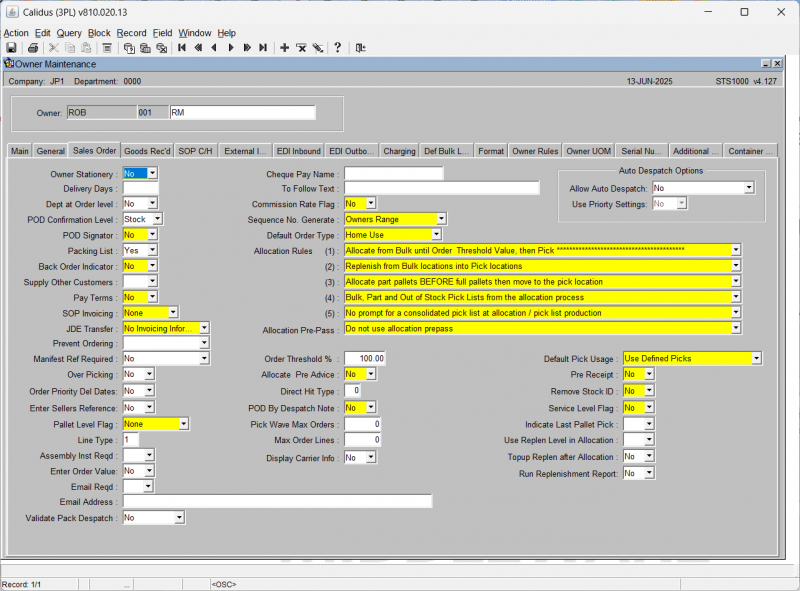
| Field Name | Description | Options | Generic Value |
|---|---|---|---|
| Owner Stationery | Is documentation produced from the WMS to be pre-printed on the client's own stationery? (not migrated) | Y or N - will default to No | N |
| Delivery Days | Indicates how many days are required to deliver stock for this owner (not migrated) | 0 - 999 or left blank | Blank |
| Dept. At Order Level | Determines whether a department code should be prompted for at order entry (not migrated) | Y, N or left blank | Blank |
| POD Confirmation Level | Determines whether POD will be actioned at stock or pallet level (not migrated) | S - POD Confirm at Product level (no regard for batch or pallets) P - POD Confirm at Batch/Pallet level - or left blank |
Blank |
| POD Signator ** | Determines whether a signature is required at entry of POD before confirmation is allowed | Y or N | Defined by the client |
| Packing List | Determines whether a packing list is required, and if so, at what point. Note, this is based on the 'old' packing functionality. If set to 'Y' and then use the new packing screens, the system will prevent you from despatching orders. | N No P Pick Y Yes |
N |
| Back Order Indicator ** | Used in conjunction with product and product class flags to determine whether back ordering is required (not migrated) | Y or N | N |
| Supply Other Customers | Indicates whether this owner will supply other owners' customers (not migrated) | Y, N or left blank | Blank |
| Pay Terms ** | Used in the old invoicing functionality - if flag set to 'Y', would override standard payment terms (not migrated) | Y, N or left blank | Blank |
| SOP Invoicing ** | Relates to old invoicing functionality - determines when invoicing is to be produced (not migrated) | N - None I - Immediate W - Weekly |
None |
| JDE Transfer ** | Relates to old invoicing functionality - whether the invoices are to be interfaced to JDE (not migrated) | C Client Invoicing N No Invoicing Information S SOP Invoicing Y Submit all invoices to JDE |
N |
| Prevent Ordering | Used in conjunction with a similar flag at customer level, will determine whether sales orders can be generated or not | Y - Prevent ordering for all customers C - Prevent ordering if the customer flag is set to 'Y' N - Do not prevent ordering - or left blank |
Blank |
| Manifest Ref Required | Used in population of the PCK tables for packing messages. If set to 'Y' will prompt for a manifest reference at order entry. This will then be written to the PCK tables (Kewill) | Y, N or left blank | Blank |
| Over Picking | States whether the owner allows over picking at pick confirmation | Y, N or left blank | Blank |
| Order Priority Del Dates | Yes or No | ||
| Enter Sellers Reference | Yes or No | ||
| Pallet Level Flag ** | Determines whether pallet levelling is required, and if so, how (not migrated) | C By No. of Cases N None P Pallet Fill Factor |
N |
| Line Type ** | Specifies the default line type. This will dictate how the system allocates stock and in what priority | 1 - Standard 2 - Non-Stock 3 - Rotation 4 - Pallet 5 - Cust Rotation 6 - Cust Pallet R - Rot - Nocommit M - Medical |
1 |
| Assembly Inst Reqd | Yes or No | ||
| Enter Order Value | Yes or No | ||
| Email Reqd | Yes or No | ||
| Email Address | Email address if email is required. | ||
| Validate Pack Despatch | Carrier Required
Yes or No |
||
| Cheque Pay Name | Used in old invoicing functionality - the name to appear on the cheque (not migrated) | 20 character free text field or left blank | Blank |
| To Follow Text | Used in old invoicing functionality - 'to follow' text to appear on invoicing documentation - (not migrated) | 40 character free text field or left blank | Blank |
| Commission Rate Flag ** | Used in old invoicing functionality - determines whether the commission rate should be overridden (not migrated) | Y or N | N |
| Sequence No. Generate ** | Determines how the order number is generated when entering an order at order entry and/or edi (all migrated apart from no.4) | 1 General Range 2 Owners Range 3 Mandatory 4 Prefix with Order Class |
1 |
| Default Order Type ** | Specifies the default order type for this owner | C Community (EU) E Export H Home Use O No default processing |
H |
| Allocation Rules (1) ** | Dictates in what sequence the system will allocate the stock | 0 Bulk Until OT Then Pick 1 Pick Locations first 2 Bulk Locations first 3 ONLY from Pick Locations 4 ONLY from Bulk Locations 5 Partial Multi-Deep First 6 Sequence Against Stock 7 As 6 Till OT then Rule 3 Reverse |
Defined by Client |
| Allocation Rules (2) ** | Dictates the sequence for replenishment | 0 Replenish Bulk -> Pick 1 Replenish Replen -> Pick 2 Replenish Bulk -> Rep -> Pick 3 Do NOT Replen in Allocation |
3 |
| Allocation Rules (3) ** | Dictates the sequence for allocating part pallets vs full (bulk) pallets | 0 Part In Sequence 1 Part Before Full Pallets 2 Part After Full Pallets 3 Part in Sequence- Move to Pick 4 Part Before Full - Move to Pick 5 Part After Full - Move to Pick 6 Part Before Full - Rp Pt In Seq 7 Part After Full - Rp Pt in Seq 8 Pt Bf Ful - Rp Pt in Sq Mv Pick 9 Pt Af Ful - Rp Pt in Sq Mv Pick |
0 |
| Allocation Rules (4) ** | Dictates when and how the pick lists are produced (currently only 0 is applicable) | 0 Blk Prt and OOS PL from PL 1 Blk and Prt PL (Sep) from PL 2 Prt and OOS PL from PL 3 Blk and Prt (Cmb) from PL 4 Blk and Prt (Cmb). OOS from PL |
0 |
| Allocation Rules (5) ** | Dictates whether consolidated pick list is required and whether the system is required to prompt for it (not migrated) | 0 No prompt for Con PL at ALL/PCK 1 Do Prompt for Con PL at ALL/PCK |
0 |
| Allocation Pre-Pass ** | Determines whether the system should reset the order back to committed if there is insufficient stock in the warehouse, dependant on what level you wish it to restrict. | 0 Accept Shortages 1 Do Not Short Alloc. Order line 2 Do Not Short Alloc. Product Type 3 Do Not Short Alloc. Order 4 Do Not Short Alloc. Range C As N -unalloc set to committed N Do Not Use Allocation Prepass Y Use Allocation Prepass |
N |
| Order Threshold | Works in conjunction with allocation rule 1. The Break Point as a % of a Standard Pallet when Allocation will switch from Bulk to Pick | 0 - 100 or left blank | Defined by the client |
| Default Pick Usage ** | Will determine whether allocation has to allocate from pick locations first. Note, if this is set to 0 or 1, allocation will fail if no pick locations are set against the products | 0 Use Defined Picks
1 Must Exist Before Allocation |
2 |
| Alloc Pre-Advice ** | Specifies whether stock is allowed to be allocated if it is at the pre advice stage (not migrated) | Y or N | N |
| Pre Receipt ** | Specifies whether stock is allowed to be allocated if it is at receipt confirmed stage (not migrated) | Y or N | N |
| Direct Hit Type ** | Direct Hit type works in conjunction with the allocation rules. It uses the actual ordered quantity to specify which pallet to allocate from. The system will look for a pallet with the exact or nearest quantity available to that ordered. Dependant on which hit type used, determines which sequence of locations it searches in to allocate. (not migrated) | 0 - Do not use Direct Hits 1 - Hit in Sequence specified against the stock code 2 - Hit in Sequence with preference to pick 3 - Hit in Sequence with preference to bulk 4 - Hit in stock code sequence then oldest part pallet greater than remainder. 5 - Hit in sequence with preference to pick then oldest part pallet greater than remainder. 6 - Hit in sequence with preference to bulk then oldest part pallet greater than remainder |
0 |
| Remove Stock Id ** | Determines whether all system ids i.e. pallet id, rotation, sell by dates etc are removed on transfer to a pick location (not migrated) | Y or N | N |
| POD by Despatch Note ** | Indicates whether POD is to be displayed in despatch note sequence (not migrated) | Y or N | N |
| Service Level Flag ** | Indicates whether a service level is mandatory at order entry (not migrated) | Y or N | N |
| Pick Wave Max Orders | Integer | ||
| Indicate Last Pallet Pick | Yes or No | ||
| Max Order Lines | Integer | ||
| Use Replen Level in Allocation | Yes or No | ||
| Display Carrier Info | Yes or No | ||
| Topup Replen After Allocation | Yes or No | ||
| Run Replenishment Report | Yes or No |
Owner Maintenance - Goods Received Tab
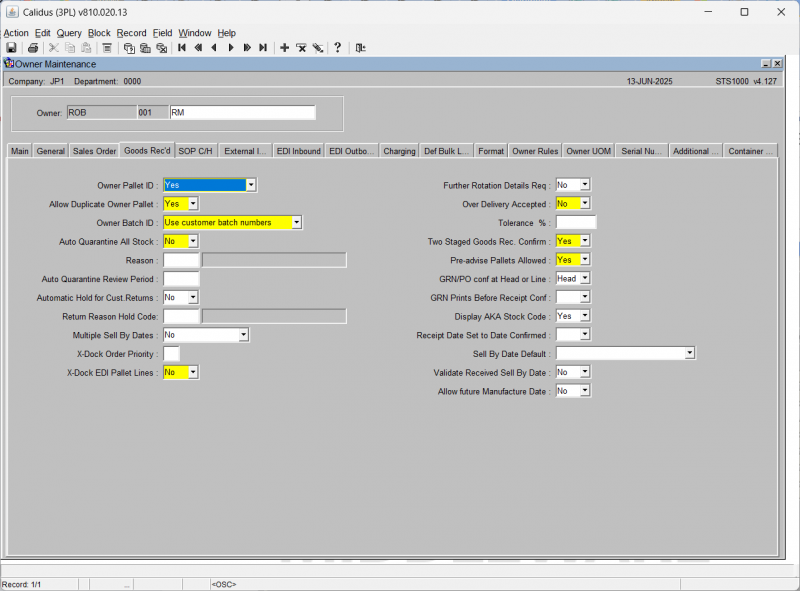
| Field Name | Description | Options | Generic Value |
|---|---|---|---|
| Owner Pallet Id ** | Specifies whether a customer pallet id is required | Y or N | Defined by the client |
| Allow Duplicate Owner Pallet Id ** | If customer pallet id's are required, are duplicates allowed? | Y or N | Defined by the client |
| Owner Batch Id ** | Specifies whether a customer rotation is required | N - Don't use cust batch numbers R - As Y - returns are restricted Y - Use customer batch numbers |
Defined by the client |
| Auto Quarantine All Stock ** | Rather than on product level, allows you to auto hold all products for this owner at receipt | Y or N | Defined by the client |
| Reason | Reason code for the auto quarantine if auto quarantine is set to 'Y' | Must exist on reason codes maintenance or left blank if no auto quarantine - LOV available | Defined by the client |
| Auto Quarantine Review Period | Sets the number of days the stock will be held under quarantine (not migrated) | 0 - 999 or left blank | Blank |
| Automatic Hold for Cust. Returns | Are goods received as a customer return to be automatically put on hold? - will generate a system reason code of '89' | Y or N | Defined by the client |
| Multiple Sell by Dates | Are pallets with the same rotation number allowed to have multiple sell by dates? (not migrated) | N No S No but amendable Y Yes |
N |
| X-Dock Order Priority | If an order priority code is entered here, only orders with that priority code can be cross docked | Must exist in order priority maintenance or left blank - LOV available | Defined by the client |
| X-Dock EDI Pallet Lines ** | Are the extra cross docked pallet details to be sent in the outbound receipt message (not migrated) | Y or N | N |
| Further Rotation Details Req | Are additional rotation details to be entered at receipt? | Y, N or left blank | Defined by the client |
| Over Delivery Accepted ** | Used with purchase ordering, determines whether this owner is allowed to receive more stock than advised on the P.O. | Y or N | Defined by the client |
| Tolerance % | If over delivery is set to 'Y' - a percentage of how much over the advised quantity you are allowed to receive | 0 - 100 or left blank | Defined by the client |
| Two Staged Goods Rec. Confirm ** | Determines whether an additional stage of goods receipt is required (not migrated) | Y or N | N |
| Pre-Advise Pallets Allowed ** | Determines if, at goods receipt, you wish to enter pallet level information | Y or N | Defined by the client |
| GRN/PO Conf at Header or Line | Determines whether receipt confirmation will occur at header or line level (not migrated) | H - Head L - Line - will default to header |
H |
| GRN Prints before Receipt Conf | Yes or No | ||
| Display AKA Stock Code | Yes or No | ||
| Receipt Date set to Date Confirmed | Yes or No | ||
| Sell By Date Default | Receipt Date + Intake Life
Manufacture Date + Intake Life System Date + Intake Life Rec Date + Intake Life + Alloc Man Date + Intake Life + Alloc Sys Date + Intake Life + Alloc |
||
| Validate Received Sell By Date | Yes or No | ||
| Allow Future Manufacture Date | Yes or No |
Owner Maintenance - SOP Charging Tab

| Field Name | Description | Options | Generic Value |
|---|---|---|---|
| SOP Invoicing Required | Determines whether SOP invoicing for this owner is enabled | Y, N or left blank | Defined by the client |
| Allow Change To: Price ** | Is the stock price at order entry, order invoice maintenance or pre-invoice allowed to be changed | Y, N or left blank - will default to No | Defined by the client |
| Allow Change To: Price Band ** | Is the Price band at order invoice maintenance or pre-invoice allowed to be changed | Y, N or left blank | Defined by the client |
| Allow Change To: Invoice Amount ** | Is the Invoice Amount at invoice maintenance or pre-invoice allowed to be changed | Y, N or left blank | Defined by the client |
| SOP Invoice : Minimum Number | Determines the lowest number in the range for the SOP invoice number. Invoice numbers will be generated from this value, incremented by 1 | 0 - 99999999 - will default to 0 | Defined by the client |
| SOP Invoice : Maximum Number | Determines the highest number in the range for the SOP invoice number. Invoice numbers will be generated upto this value | 0 - 99999999 - will default to 1 | Defined by the client |
| SOP Invoice : Last Number | Determines last number produced for the SOP invoice number. | 0 - 99999999 - will default to 0 | Defined by the client |
| Credit Note: Minimum Number | Determines the lowest number in the range for the Credit Note number. Invoice numbers will be generated from this value, incremented by 1 | 0 - 99999999 - will default to 0 | Defined by the client |
| Credit Note: Maximum Number | Determines the highest number in the range for the Credit Note number. Invoice numbers will be generated upto this value | 0 - 99999999 - will default to 1 | Defined by the client |
| Credit Note: Last Number | Determines last number produced for the Credit Note number. | 0 - 99999999 - will default to 0 | Defined by the client |
| Number Format | Allows the user to set the invoice number format to be either a sequential running number, or more client specific, the first 7digits of the invoice last number, the last number from the current year and a check digit based on modulo-10 | '0' - Sequential Invoice Number '1' - 7/Year/Mod10 or left blank |
Defined by the client |
| SOP Invoice | A predefined 3 character format to determine an owner specific invoice format | 3 character free text field - the format used must be a valid system source format or left blank | Blank |
| Credit Note Format | A predefined 3 character format to determine an owner specific credit note format | 3 character free text field - the format used must be a valid system source format or left blank | Blank |
| Despatch Docs | Determines what documentation is required - whether a delivery note and/or waybill is to be produced | B - Both Dnote and Waybill req'd D - Dnote only required W - Waybill only required |
Blank |
| Min, Despatch Document No. | Determines the lowest number in the range for the Despatch Note Number number. Despatch Note numbers will be generated from this value, incremented by 1 | 0 - 9999999999 - will default to 0 | Defined by the client |
| Max. Despatch Document No. | Determines the highest number in the range for the Despatch Note number. Despatch Note umbers will be generated up to this value | 0 - 9999999999 - will default to 1 | Defined by the client |
| Last Despatch Document No. | Determines last number produced for the Despatch Note number. | 0 - 9999999999 - will default to 0 | Defined by the client |
Owner Maintenance - External Interface Tab

| Field Name | Description | Options | Generic Value |
|---|---|---|---|
| External SOAP API Interfaces | |||
| Metapack Required | Is this interface required? | Y, N | N |
| NetDespatch Required | Is this interface required? | Y, N | N |
| Intelligent Shipper Required | Is this interface required? | Y, N | N |
| Click and Drop Required | Is this interface required? | Y, N | N |
| Pro Shipping Required | Is this interface required? | Y, N | N |
| Inbound Transport Interface Options | |||
| Loading Details/Email | Is this required? If so, the email address. | Unchecked | |
| Tracking Details/Email | Is this required? If so, the email address. | Unchecked | |
| Despatch Confirmation/Email | Is this required? If so, the email address. | Unchecked | |
| Outbound Transport Interfaces | |||
| Transport Interface Required | The type of TMS interface required. | No, Yes, TMS Interface | No |
| Record Pallet Count | Whether to record the pallet count | No, Yes | No |
| Record No. of Lifts | Whether to record the number of lifts | No, Yes | No |
| Ordered | Whether to interface at this status. | Unchecked | |
| Allocated | Whether to interface at this status. | Unchecked | |
| Pick List Printed | Whether to interface at this status. | Unchecked | |
| Pick Confirmed | Whether to interface at this status. | Unchecked | |
| Pack Confirmed | Whether to interface at this status. | Unchecked | |
| Despatch Confirmed | Whether to interface at this status. | Unchecked | |
| Other Interfaces | |||
| Account Code | |||
| Ext. Account Code | |||
| Invoice Format | |||
| Exclude from Interface | No, Yes | No | |
| Generate Tariffs | No, Yes | No | |
Owner Maintenance - EDI Inbound Tab
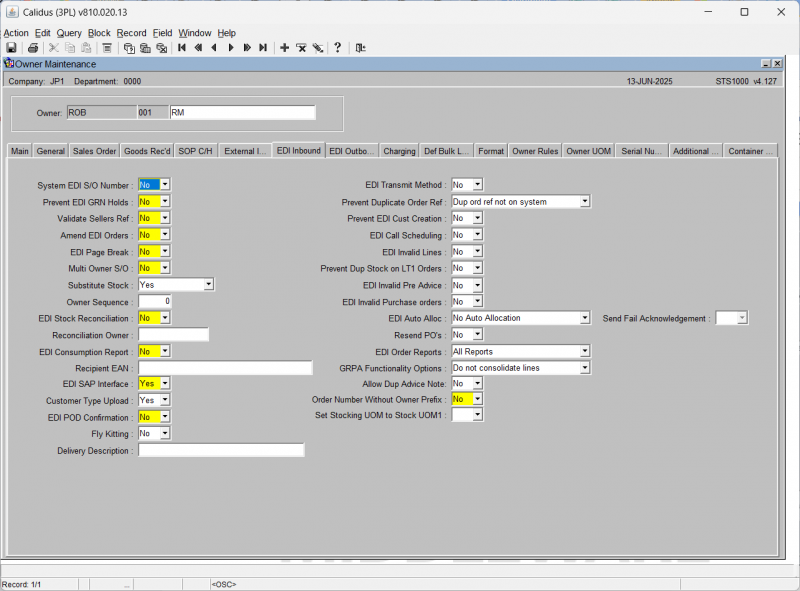
| Field Name | Description | Options | Generic Value |
|---|---|---|---|
| System EDI S/O Number ** | Determines whether, when using edi sales order uploads, you wish the system to auto generate the order number (not migrated) | Y or N - will default to No | Y |
| Prevent EDI GRN Holds ** | Determines whether you wish to prevent awaiting putaway holds from being mapped in edi (not migrated) | Y or N - will default to No | N |
| Validate Sellers Ref ** | Y or N - will default to No | N | |
| Amend EDI Orders ** | Is the user allowed to amend orders that have been created via edi? (not migrated) | Y or N - will default to No | Y |
| EDI Page Break ** | Do you wish a page break to be inserted at every order number in the edi message? (not migrated) | Y or N - will default to No | N |
| Multi Owner S/O | Y or N | N | |
| Substitute Stock | Used with the multi owner s/o flag. Specifies whether substitute stock codes are to be used. On upload the system will explode the orders out into muliple owner orders using substitute stock codes (not migrated) | Y or N | N |
| Owner Sequence | Used in conjunction with the multi owner s/o flag. Specifies what priority sequence the owners will have (not migrated) | 001 - 999 - will default to zero | 0 |
| EDI Stock Reconciliation ** | Determines whether this owner is to be included in the stock reconciliation edi report (not migrated) | Y or N - will default to No | N |
| Reconciliation Owner | The owner code to be displayed on the reconciliation report (not migrated) | 3 character free text field or left blank | Blank |
| EDI Consumption Report ** | Determines whether this owner is to be included in the edi consumption report (not migrated) | Y or N - will default to No | N |
| Recipient EAN | The European Article Number of the recipient of the edi messages | 35 character free text field or left blank | Blank |
| EDI SAP Interface ** | Used to enable SAP details to be entered at goods receipt. If set to 'Y' an additional button will appear at goods receipt to allow sap details | Y or N - will default to No | Defined by the client |
| Customer Type Upload | Yes or No | No | |
| EDI POD Confirmation ** | Yes or No | No | |
| Fly Kitting | Yes or No | No | |
| Delivery Description | |||
| EDI Transmit Method | Dictates whether EDI is to be used (not migrated) | Y or N - will default to No | N |
| Prevent Duplicate Order Ref | Determines, if using sales order upload, whether duplicate order references are allowed (not migrated) | A - Dup ord ref not on system N - Duplicate order ref allowed Y - Dup ord ref not on customer - default is N |
N |
| Prevent EDI Cust Creation | Specifies whether you wish the system to prevent customer codes from being prevented on sales order upload | Y or N - will default to No | N |
| EDI Call Scheduling | Client specific flag to enable telesales edi schedules (not migrated) | Y or N - will default to No | N |
| EDI Invalid Lines | Determines whether the system will allow orders with invalid detail lines (not migrated) | Y, N or left blank | Blank |
| Prevent Dup Stock on LT1 orders | Determines whether the system should prevent duplicate stock codes from being uploaded on a line type 1 order (not migrated) | Y or N - will default to No | N |
| EDI Invalid Pre Advice | Determines whether the system should allow invalid detail lines on inbound pre advice (not migrated) | Y or N - will default to No | N |
| EDI Invalid Purchase Orders | Determines whether the system should allow invalid detail lines on inbound purchase orders (not migrated) | Y or N - will default to No | N |
| EDI Out Alloc | Should the system only allow edi orders to be interfaced on the outbound allocation message (not migrated) | Y or N - will default to No | N |
| Resend PO's | Determines whether the system will allow previously uploaded purchase orders to be overwritten with new quantities from a new upload (not migrated) | Y or N - will default to No | N |
| EDI Order Reports | Specifies what type of report is to be produced on upload of an edi order (not migrated) | 0 - No Reports 1 - All Reports 2 - Over Committed Only 3 - Order Detail Summary 4 - Over Committed and Detail 5 - Over Committed and summary 6 - Order Detail Summary 7 - Order Summary Only |
0 |
| GRPA Functionality Options | Should pallet detail lines be consolidated or expanded on upload of the pre advice (not migrated) | N - Do not consolidate lines R - Don't consolidate expand palls S - Consolidate and expand pallets Y - Consolidate Lines |
N |
| Allow Dup Advice Note | Determines whether duplicate advice note numbers should be allowed on upload of pre advice | Y, N or left blank | Defined by the client |
| Order Number Without Owner Prefix ** | Should the system generated order number be allowed to not be prefixed with the owner code | Y or N - will default to No | N |
| Set Stocking UOM to Stock UOM1 | Y, N | N | |
| Send Fail Acknowledgement | Unchecked |
Owner Maintenance - EDI Outbound Tab
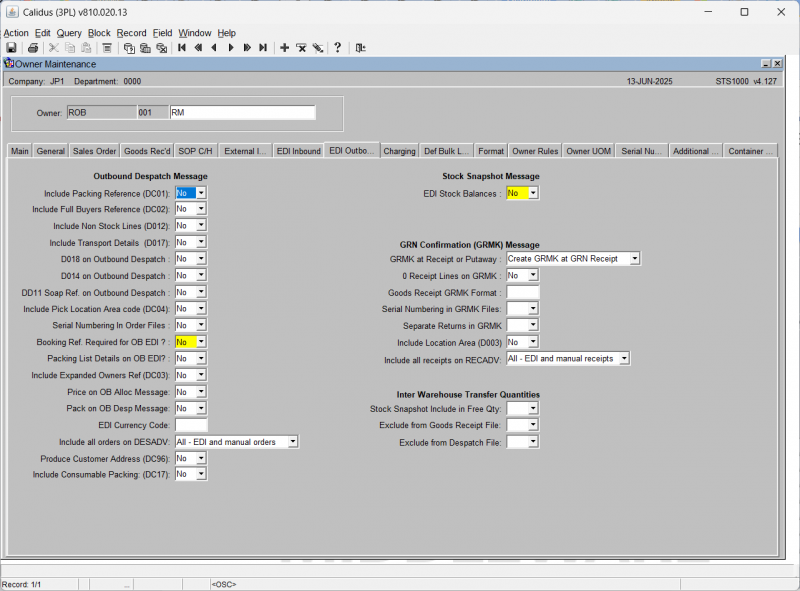
| Field Name | Description | Options | Generic Value |
|---|---|---|---|
| Stock Snapshot Message | |||
| EDI Stock Balances ** | Should the owner's stock balances be transmitted via edi (not migrated) | Y or N - will default to No | N |
| GRN Confirmation (GRMK) Message | |||
| GRMK at Receipt or Putaway? | Determines whether the outbound receipt confirmation message is sent after receipt confirmation or putaway confirmation P - Create GRMK at GRN Putaway R - Create GRMK at GRN Receipt - default is R |
Defined by the client | N |
| 0 Rec Lines on GRMK | Are zero received quantities to be sent in the outbound receipt confirmation message (not migrated) | Y or N - will default to No | N |
| Goods Receipt GRMK Format | Specifies which EDI receipt confirmation message is to be sent. (note, only one has been created so far) | HDM or left blank | Blank |
| Serial Numbering in GRMK Files | Y or N - will default to No | N | |
| Separate Returns in GRMK | Y or N - will default to No | N | |
| Include Location Area (D003) | Y or N - will default to No | N | |
| Include All Receipts in RECADV | Option Select
All - EDI and manual receipts EDI receipts only |
||
| Outbound Despatch Message | |||
| Include Packing Reference (DC01) | Y or N - will default to No | N | |
| Include Full Buyers Reference (DC02) | Y or N - will default to No | N | |
| Include Non Stock Lines (D012) | Y or N - will default to No | N | |
| Include Transport Details (D017) | Y or N - will default to No | N | |
| D018 on Outbound Despatch | Y or N - will default to No | N | |
| D014 on Outbound Despatch | Y or N - will default to No | N | |
| DD11 SOAP Ref on Outbound Despatch | Y or N - will default to No | N | |
| Include Pick Location Area Code (DC04) | Y or N - will default to No | N | |
| Serial Numbering in Order Files | Y or N - will default to No | N | |
| Booking Ref Required for OB EDI? ** | Should the booking screen be populated before the outbound Pick/Despatch message is sent (not migrated) | Y or N - will default to No | N |
| Packing List Details on OB EDI? | Are the packing list details to be sent on the OB Pick/Despatch Message? (Note, automatically sent on the SCH despatch flow with the SCH packing functionality) - (generic - not migrated) | Y or N - will default to No | N |
| Include Expanded Owners Ref (DC03) | Y or N - will default to No | N | |
| Price on OB Alloc Message | Y or N - will default to No | N | |
| Price on OB Desp Message | Y or N - will default to No | N | |
| EDI Currency Code | Y or N - will default to No | N | |
| Include All Orders on DESADV | Y or N - will default to No | N | |
| Produce Customer Address (DC96) | Y or N - will default to No | N | |
| Include Consumable Packing (DC17) | Y or N - will default to No | N | |
| Inter Warehouse Transfer Quantities | |||
| Stock Snapshot Include in Free Quantity | Y or N - will default to No | N | |
| Exclude from Goods Receipt File | Y or N - will default to No | N | |
| Exclude from Despatch File | Y or N - will default to No | N | |
Owner Maintenance - Charging Tab
This is split into 4 distinct sections:
Invoice Details – for Standard Invoice processing
| Field Name | Description | Options | Generic Value |
|---|---|---|---|
| Invoice Type | Flag to identify if Invoicing is applicable to this owner | NORMAL or
NONE |
|
| Master Invoice Cycle | Unique single character identifier for this owners cycle | Must be valid code from table INVOICE_CYCLE which will define it as Daily, Weekly, Half Monthly etc… | |
| End Day | If appropriate – defines that actual day that a period will end on | User defined | |
| Current Period From/To | The dates of the current Invoice Period for the Owner as defined by the running of the Invoice Production Process | Display only | |
| Last Period From/To | The dates of the last Invoice Period for the Owner as defined by the running of the Invoice Production Process | Display only | |
| Combo Flag | Identify whether Invoice and Credits should be produced as individual documents or combined onto one document | Drop down – COMBINED INDIVIDUAL | |
| Payment Terms | Free text for owner specific payment terms to be printed on Invoices | User input |
Rent Details – applicable to Rent Charge processing only
| Field Name | Description | Options | Generic Value |
|---|---|---|---|
| Rent Mode | Fixed definition of the type of Rent applicable for the owner | None / Advance / Average / Fixed Advance / Maximum | |
| Rent Cycle | Daily / Weekly / Monthly / Half-Monthly etc (as described above). Note that although the same table is used to define the CYCLE, the Rent and Invoice Cycle are separate processes. | As for Invoice cycle above | |
| Master Rent Cycle/To | Start and End date for the current Rent Cycle for the Owner | User sets up start date and system defines the end date based on the Rent Cycle and the regular (daily) update of rent processing. | |
| Level | The standard charge level for rent | Stock / Pallet / Rotation | |
| Free Days | Numeric value to represent the number of days that Stock can remain in the warehouse Free of Charge for rent | User input | |
| Rent in Despatch | Note this and WHOLE/PART, which is set by the MODE, determines if charges are for full periods, and whether or not Credits are to be generated when stock despatched (and the level of the credit). Also utilises the FREE DAYS to determine the generation of credits for rent already charged. | Yes / No flag | |
| Override VAT | Whether to override the VAT code | ||
| Code | The VAT code to use when overriding. |
Additional Information
| Field Name | Description | Options | Generic Value |
|---|---|---|---|
| Owner Cost Centre | An owner cost centre can be entered if required | Free Text | |
| Associated Pallet Charge | Legacy | N/A | |
| Days for payment | The number of days allowed for payment – between Invoice Date and Due Date printed on the invoice | N/A | |
| Back Account No | Legacy | N/A | |
| Invoice Ref | Free text reference for printing on the invoice | Free Text |
Charge Level Details – for control of individual ‘Charge Processing’
‘Auto charges’ (Charge codes with type of ‘Auto’) will be generated automatically within the individual processes if the appropriate flag is set to Yes. All are Yes / No flags (unless otherwise stated). These flags simply allow the user to ‘switch on/off’ charge generation for specific processing as required.
| Field Name | Description | Options | Generic Value |
|---|---|---|---|
| Receipt Header Charges | Receipt Header level | ||
| Receipt Details Charges | Receipt detail level | ||
| Invent Charges | Inventory Movements (inc. Freeze/Chill process) | ||
| Carrier to Charge Direct ** | Carrier charges (not UPM) – not used any more | ||
| Auto Display of Charges | Owner level check for display of auto generated charge codes (pre confirmation within individual processes) | ||
| Order Header Charges | Sales Order handling - Order header level | ||
| Order Well Charges | Sales Orders - Product type level | ||
| Order Pallet Charges | Sales Orders - Despatch pallet level | ||
| Order Pallet Exchange Charges | Special Pallet exchange code processing.
This checks if a specific charge is to be raised against the Stock Owner for the use of Pallets, due to the fact that neither the Stock Owner or their Customer has an account code for the Pallet Exchange system. |
||
| Invoice Generation Charges | Invoice generation process
Do we raise a charge each type we produice an Invoice for this owner? |
Owner Maintenance - Default Bulk Locations Tab
Used in conjunction with the putaway algorithm of stock. These locations can be used as anchor points at owner level. All products for this owner would then start their putaway locations from these anchor points.
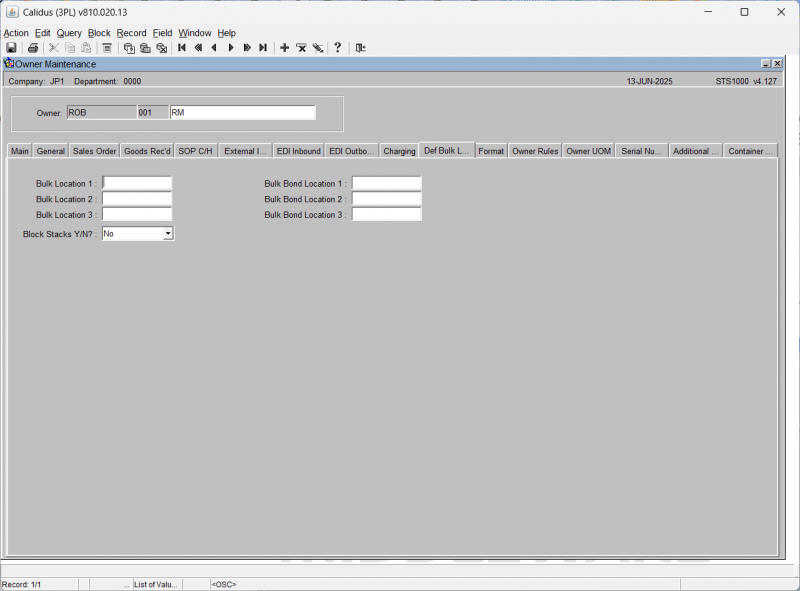
| Field Name | Description | Options | Generic Value |
|---|---|---|---|
| Bulk Location 1 | Defines the first anchor point for putaway | Must have been created in location codes maintenance or left blank - LOV available | Defined by the client |
| Bulk Location 2 | Defines the 2nd anchor point for putaway | Must have been created in location codes maintenance or left blank - LOV available | Defined by the client |
| Bulk Location 3 | Defines the last anchor point for putaway | Must have been created in location codes maintenance or left blank - LOV available | Defined by the client |
| Bulk Bond Location 1 | Defines the first anchor point for putaway for a bonded warehouse | Must have been created in location codes maintenance or left blank - LOV available | Defined by the client |
| Bulk Bond Location 2 | Defines the 2nd anchor point for putaway for a bonded warehouse | Must have been created in location codes maintenance or left blank - LOV available | Defined by the client |
| Bulk Bond Location 3 | Defines the last anchor point for putaway for a bonded warehouse | Must have been created in location codes maintenance or left blank - LOV available | Defined by the client |
| Block Stacks Y/N | Can the owner use block stacks? Note, if this flag is set to 'N', the owner will not be able to use pallet exchange or move pallets from any use type 'M' location | Y or N | Defined by the client |
Owner Maintenance - Format Tab
This screen will determine which client specific formats will be used for printing documents and labels. Note, each format used must be a valid source format i.e. WHR1700_CSP exists as a program, but WHR1700_XXX does not.

| Field Name | Description | Options | Generic Value |
|---|---|---|---|
| PRINT FORMATS | |||
| GRN Checklist | The format to be used for the GRN checklist (produced at receipt) | FWL, CLD (blank will denote the FWL generic) | Blank |
| Goods Receipt Note | The format to be used for the GRN note (produced at receipt) | FWL,(blank will denote the FWL generic) | Blank |
| Pick List | The format to be used for the pick list | FWL, CSP, SCH (blank will denote the FWL generic) | Blank |
| Pick By | Determines the sequence the allocated order lines will appear on the pick list | Sort by Aisle Sort by Location Sort by Stockist Sort by product type Sort by Rotation System Default |
System Default |
| Movement Pick List | The format to be used for the movement list (produced at stock or pallet move) | FWL, (blank will denote the FWL generic) | Blank |
| Despatch | The format to be used for the GRN note (produced at receipt) | FWL, SCH (blank will denote the FWL generic) | Blank |
| Collection Note | The format to be used for the collection note (produced at receipt) | FWL,(blank will denote the FWL generic) | Blank |
| External Despatch | |||
| LABEL FORMATS | |||
| Rotation Labels | Rotation label format - produced at receipt | FWL, (blank will denote the FWL generic) | Blank |
| Pallet Label - PLBC | Pallet label format - produced at receipt | FWL, SCH (blank will denote the FWL generic) | Blank |
| Sup Code on Pall Label? | Should the supplier code appear on the receipt label | Y or N - will default to Y | Y |
| Product Label - PROL | Stock level receipt label format - produced at receipt | FWL, (blank will denote the FWL generic) | Blank |
| Case label - RECL | Case level label format - produced at receipt | FWL, (blank will denote the FWL generic) | Blank |
| Picking Label | Picking label format | FWL, SCH, PIP, RYA (blank will denote the FWL generic) | Blank |
| Picking Label Control | Determines when and how pick labels should be produced | A - Do not prompt, use defined N - Pick labels not required Y - Prompt for label format |
Defined by the client |
| Shipping Label Despatch Label | Shipping label format OBS, PIP (client specific, STR | None | Defined by the client |
| Shipping Label control | Determines when and how ship labels should be produced | A - Do not prompt, use defined N - Ship labels not required Y - Prompt for label format |
N |
| Transport Label | Transport label format - produced at pick | Y - Yes, produce simplified labels for the stock owner C - Refer to customer level setting N - No simplified labels required |
Blank |
| Default Comm Inv Type | Option select
AAA Format NKT Format XXX Format |
||
| Ticket Label at PL | Do not produce ticket or label
Produce ticket but not label Produce ticket and pallet label Prompt user whether to print |
||
| Shipping Labels at PL | Yes or No | ||
| Print Dnote When ** | Default
Create Desp Note at Allocation Print document at Pick Print document at Packing Print document at Despatch At Alloc/Pick when fully alloc Print at either Pick or Desp |
Default | |
| Waybill Format | |||
| Pallet Label | |||
| Other | |||
| Despatch | |||
| Short Receipt | |||
| GRN Type | Manifest
Purchase Order Non-Purchase Order Return of Non Sales Order Return of Sales Order |
||
| Alloc Email Format | |||
| Stock Re-order Email Format | |||
| Receipt | |||
| Sales Order | |||
| Short Pick Email Format | |||
| Short Pick Email Address | |||
| Stock Take Formats | |||
| Stock Take Format | |||
Owner Maintenance - Owner Rules Tab
This screen allows you to assign rules to a specific owner. Note, the rules themselves must have already been created in warehouse rules control maintenance for type 'OWNR'

| Field Name | Description | Options | Generic Value |
|---|---|---|---|
| Rule ** | The rule code to be applied to this owner | Must have been created in warehouse rules control | Defined by the client |
| Description | The description for the rule - note, this will default from the description set up in warehouse rules control | Non | N/A |
| Flag ** | The flag used to determine whether this rule is to be used, and how it is to be used (if applicable) | Determined by the flag size and valid values set in warehouse rules control | Defined by the client |
Owner Maintenance - Owner UOM Tab
This screen will determine for this owner, which units of measure are allowed and their conversion factors. The values set in here will then be used in other screens, i.e. stock maintenance to assign valid units of measure
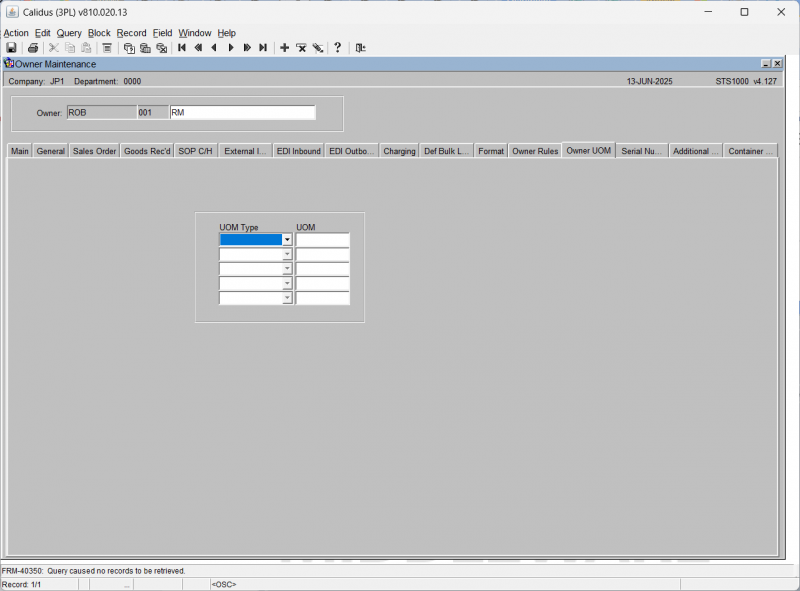
| Field Name | Description | Options | Generic Value |
|---|---|---|---|
| UOM Type ** | The type of unit of measure to be created | A - Area L - Length V - Volume W - Weight |
Defined by the client |
| UOM ** | The default unit of measure for this type | Must have been created in general codes, type 'UOM' | Defined by the client |
Owner Maintenance - Serial Number Tab
Only enter if serial numbering is required for the owner.
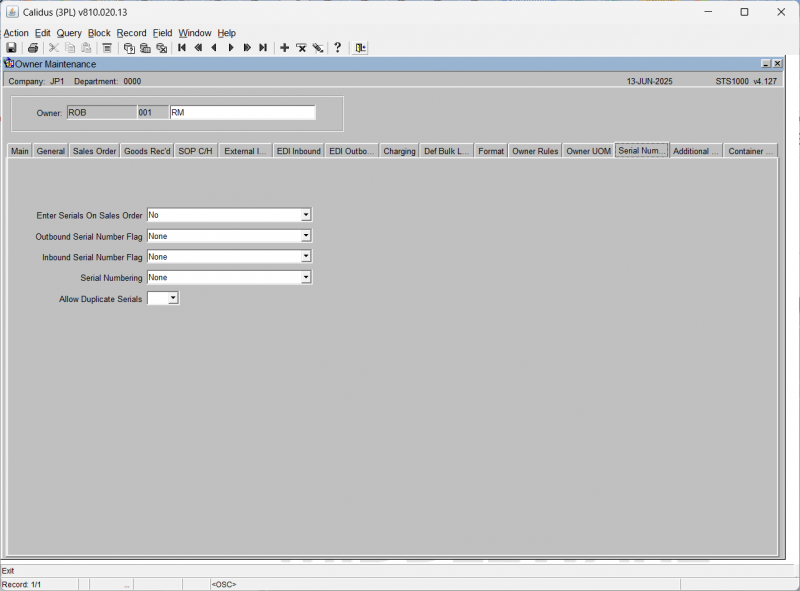
Values
Enter Serials on Sales Order
| No | (0) | Serial numbers not required at order entry |
| Optional allow held serials | (1) | Entry of serial numbers at order entry is optional (Free and held serial numbers can be entered) |
| Mandatory allow held serials | (2) | Entry of serial numbers at order entry is mandatory (Free and held serial numbers can be entered ) |
| Optional allow free serials | (3) | Entry of serial numbers at order entry is optional (Only free serial numbers can be entered) |
| Mandatory allow free serials | (4) | Entry of serial numbers at order entry is mandatory (Only free serial numbers can be entered) |
Ordering of held stock is currently done by using a line type R. For Medical Number functionality all ordering - both for free and held stock - will now be done through line type M functionality
Outbound Serial Number Flag
| None | (0) |
| Capture at Pick | (1) |
| Capture Latest at Pack | (2) |
| Capture Latest at Despatch | (3) |
| Capture Latest at POD | (4) |
Inbound Serial Number Flag
| Not required | Serial numbers are not required at Goods Receipt |
| Optional at Pre advice | This option should be used if serial numbers are to be entered at either pre advice or receipt confirm stage. |
| Mandatory at Pre advice | This option will be used if serial numbers are mandatory at the pre advice stage, and only displayed in the goods receipt confirmation screen. |
Serial Numbering
| None | Serial numbering is not required for this Owner / Stock code. |
| Case | Serial numbering is required for this stock code. 1 serial number is expected for every case. |
| Unit | Serial numbering is required for this stock code. 1 serial number is expected for every unit |
Allow Duplicate Serials
| No | Not allowed for this Owner/Stock Code. |
| Yes | allowed for this Owner/Stock Code. |
Owner Maintenance - Additional Control Tab
| Field Name | Description | Options | Generic Value |
|---|---|---|---|
| Organisation Name | |||
| Sub Building Name | |||
| Building Name | |||
| PO Box Number | |||
| Building Number | |||
| Thoroughfare Descriptor | |||
| Double Dependent Locality | |||
| Dependent Locality | |||
| Post Town | |||
| County | |||
| Postcode | |||
| Delivery Country | |||
| Phone Number | |||
| Contact | |||
| Consumable Owner | LOV available | ||
| Packing Group | |||
| Auto Pack Calculation Reqd | Yes or No | ||
| Carriers | |||
| Carrier | LOV Available | ||
Owner Maintenance - Container Yard Tab
| Field Name | Description | Options | Generic Value |
|---|---|---|---|
| Enabled | Yes or No | No | |
| Service | |||
| Carrier |
Owner Ware Parameters
This screen is almost identical to the system parameters screen, with the exception of a few fields. Where possible the screen should be setup exactly as per system parameters.
Owner Ware Parameters - Main Tab
![]() Note: For certain functionality such as barcode pallet labels this screen must be maintained.
Note: For certain functionality such as barcode pallet labels this screen must be maintained.
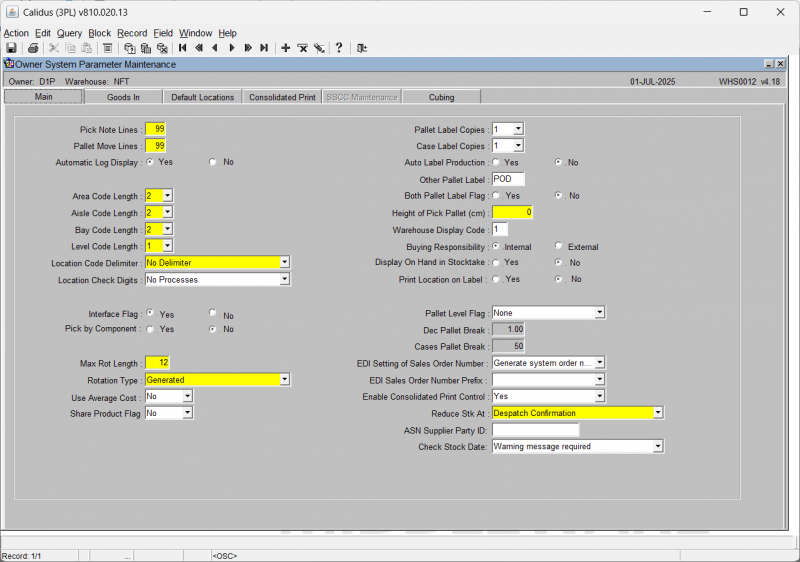
| Field Name | Description | Options | Generic Value |
|---|---|---|---|
| Pick Note Lines ** | The maximum number of lines printed on a pick note | 0-99 | 99 |
| Pal Move Lines ** | The maximum number of lines on a pallet move ticket print | 0-99 | 99 |
| Auto Log Display ** | Check box to determine whether you wish to see the allocation log | Check box, Yes or No | Y |
| Area Code Length ** | Number of characters the area code will be | 0-4 | Defined by the client |
| Aisle Code Length ** | Number of characters the aisle code will be | 0-4 | Defined by the client |
| Bay Code Length ** | Number of characters the bay code will be | 0-4 | Defined by the client |
| Level Code Length ** | Number of characters the level code will be | 0-4 | Defined by the client |
| Location Code Delimiter | States which delimiter will be used within the location code i.e. A1-001-01 | 1 - No Delimiter 2 - Space 3 - Forward Slash / 4 - Colon : 5 - Back Slash \ 6 - Underscore _ 7 - Minus - |
3 |
| Location Check Digits | Allows the user to state whether they will use check digits and which processes will use them | Y - All Processes N - No Processes * - Stock Movements and GRN |
N |
| Interface Flag ** | Used for RDT to determines whether RF functionality will be used | Check box Y or N - default is N | N |
| Pick by Component ** | Determines whether a product can be picked as a component (kits) | Check box Y or N - default is N | N |
| Max Rot Length ** | Maximum length of the system rotation number | 0-14 | 11 |
| Rotation Type ** | Determines whether system rotation numbers will be used and how they will be used | S - Sell by date O - Generated with manual override G - Generated M - Manual Entry B - Back Date/Seq R - Rotation |
G |
| Use Average Cost | Y or N | N | |
| Share Product Flag | Y or N | N | |
| Pallet Label Copies ** | Sets the number of auto-generated labels to be produced | 01-Apr | 1 |
| Case Label Copies | Sets the number of auto-generated case labels to be produced | 01-Apr | 1 |
| Auto Label Production ** | Defines whether labels are produced without user intervention | Y or N | Y |
| Other Pallet Label | The ability to enter an additional label format if required | Must be a valid format or left blank | Blank |
| Both Pallet Label Flag ** | Determines whether a pallet and case label should be produced automatically | Check box Y or N - will default to N | N |
| Height of Pick Pallet (cm) | Used for pallet levelling - determines the height of the pick pallet (not migrated) | 0 - 99999 | 0 |
| Height of Pick Pallet ** | The specific height of the pallets to be stored in pick locations | 0-9999 | 20 |
| Warehouse Display Code | Enables the autogeneration of ware_last_numbers (not migrated) | 0-Z or leave blank | 1 |
| Buying Responsibility ** | Used in purchase order suggestion to dictate the source of receipts | Internal check box or external check box | External |
| Display On Hand in Stocktake ** | Determines whether on hand can be displayed on stock take count sheets | Yes or No | Yes |
| Print Location on Label ** | Specifies whether the location code will be printed on the receipt label | Yes or No | Yes |
| Pallet Level Flag ** | Dictates at which point pallet levelling will be carried out | N - None P - Pallet Fill Factor C - By No. of Cases |
None |
| Dec Pallet Break | Decimal value | ||
| Cases Pallet Break | Integer value | ||
| EDI Setting of Sales Order Number | Use Extra Reference
Use Sellers Order Reference Use Customer PO Reference Generate System Order Number |
Generate System Order Number | |
| EDI Sales Order Number Prefix | Prefix with Owner Code
No Order Prefix |
||
| Enable Consolidated Print Control | Yes or No | ||
| Reduce Stk At ** | At which WH process will the stock levels be reduced? | Pick Confirmation
Despatch Confirmation |
|
| ASN Supplier Party ID | |||
| Check Stock Date | Warning Message Required
Error Message Required No check required at pick conf |
Owner Ware Parameters - Goods In Tab
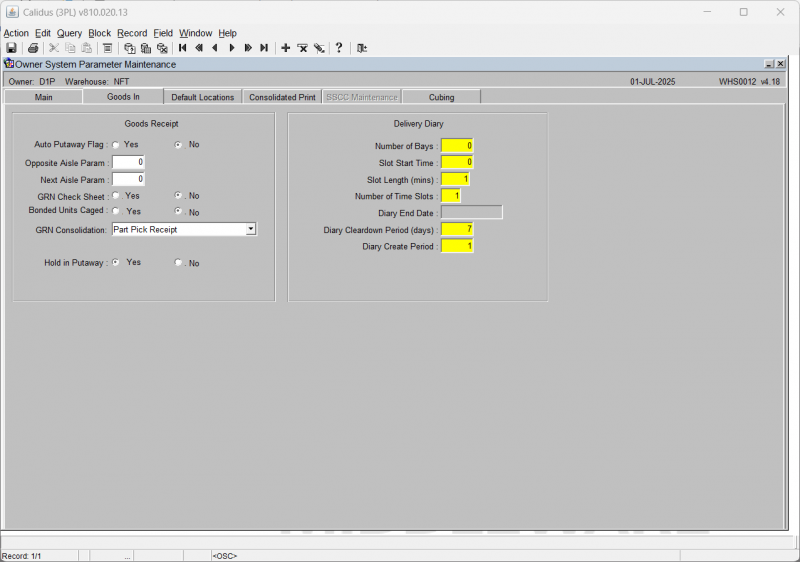
| Field Name | Description | Options | Generic Value |
|---|---|---|---|
| Auto Putaway Flag ** | Determines whether the warehouse will be utilising autoputaway. i.e. the system will suggest the locations to receive into | Y or N | Defined by the client |
| Opposite Aisle Param | Sets the number of locations the autoputaway will go through before moving to the opposite aisle | 0-4999 - will default to 0 | 999 |
| Next Aisle Param | Sets the number of locations the autoputaway will go through before moving to the next aisle | 0-4999 - will default to 0 | 999 |
| GRN Check Sheet ** | Is a GRN Check sheet required at pre advice? | Y or N | N |
| Bonded Units Caged ** | Will the warehouse be brining in non-duty paid stock stored in cages? | Y or N | N |
| GRN Consolidation | Specifies whether you wish to generate replenishments at receipt | N - None B - Pick Replen. & Partial Bulk P - Pick Replen. during GRN Part Pick Receipt |
N |
| Hold In Putaway ** | Determines whether you wish stock to be automatically put on hold until putaway confirmation has been completed | Check box - Y or N | Y |
| Number of Bays | Transport field - not used - specifies no. of bays to be loaded into | 0-9999 | 0 |
| Slot Start Time | Transport field - not used - defines when the receiving starts | 00:00 - 23:59 | 00:00 |
| Slot Length (mins) | Transport field - not used - defines how long a truck can be at the bay | 1-600 | 1 |
| Number of Time Slots | Transport field - not used - defines how many slots can be used in one day | Jan-99 | 1 |
| Diary Cleardown Period (days) | Transport field - not used - defines how many days before the diary is cleared down | Jan-99 | 1 |
| Diary Create Period | Transport field - not used - defines the number of days to be generated by the diary | 1-999 | 1 |
Owner Ware Parameters - Default Locations Tab

| Field Name | Description | Options | Generic Value |
|---|---|---|---|
| ID Station | Receipt ID Station | Predefined in locations maintenance | Blank |
| Reject Spur at ID Station | Client Specific -spur locations | Predefined in locations maintenance | Blank |
| Q/A | Default quarantine location | Predefined in locations maintenance | Blank |
| Turntable | Default turntable locations | Predefined in locations maintenance | Blank |
| Input Spur to Conveyor | Client specific - spur locations | Predefined in locations maintenance | Blank |
| Default Marshalling Location ** | Required to enable picking and allocation to function | Predefined in locations maintenance | Defined by client |
| Default Despatch Bay Location | Default Outbound Bay Location | Predefined in locations maintenance | Blank |
| Pre Advice Virtual Location | Default receiving staging area | Predefined in locations maintenance | Blank |
| Quarantine in Marshal | Default additional quarantine stage within the outbound process | Predefined in locations maintenance | Blank |
| Auto bulk Reject | Client Specific - Default rejection location | Predefined in locations maintenance | Blank |
| Default Ship Pallet Build Locn | Used in Shipment Pallet Building as default staging area | Predefined in locations maintenance | Blank |
| Default Damages | Default damages location for putaway | Predefined in locations maintenance | Blank |
| Default Cons Good Ret | Predefined in locations maintenance | Blank | |
| Default Cons Bad Ret | Predefined in locations maintenance | Blank | |
| Bonded Putaway Locations | 3 x Warehouse level anchor point for autoputaway for bonded warehouses | Predefined in locations maintenance | Blank |
| Unbonded Putaway Locations | 3 x Warehouse level anchor point for autoputaway for duty paid warehouses | Predefined in locations maintenance | Blank |
Owner Ware Parameters - Consolidated Pallet Tab
| Field Name | Description | Options | Generic Value |
|---|---|---|---|
| Owner Code | The Owner Code and Name | Display only | |
| Pick List | An option of whether the Pick List is consolidated, plus the default printer name. | Yes or No | |
| Out of Stock | An option of whether the Out of Stock is consolidated, plus the default printer name. | ||
| Replenishment | An option of whether the Replen List is consolidated, plus the default printer name. | ||
| Despatch Note | An option of whether the Despatch Note is consolidated, plus the default printer name. | ||
| Shipping Label | An option of whether the Shipping Label is consolidated, plus the default printer name. |
Owner Ware Parameters - Cubing Tab
This tab covers the options available for cubing of pallets during the picking process.
| Field Name | Description | Options | Generic Value |
|---|---|---|---|
| Cubing Required | Whether the owner uses the Cubing functionality. | Option select Yes or No | No |
| Replens Lower Priority | Whether to lower the priority of any replens when executing them through the WCS | Option select Yes or No | Yes |
| Allow SKUs on Split Pallets | Whether order lines/SKUs can be split across multiple picking pallets, or whether the full line quantity must stay on one picking pallet. | Option select Yes or No | Yes |
| Build Height (cm) | The target build height. | Decimal | As required. |
| Max Build Height (cm) | The maximum build height | Decimal | As required. |
| Min Build Height (cm) | The Minimum build height | Decimal | As required. |
| Final Sortation of Page | How the tasks and/or pick list will be sorted for picking. | By Strength
By Location As Built |
By Strength |
Owner Prompt Maintenance
This screen is used to enable the logon id to have a default owner. If the default owner flag is set to ‘No’ the user will always be prompted for an owner and will never have the common owner defaulted.
Owner Prompt Maintenance
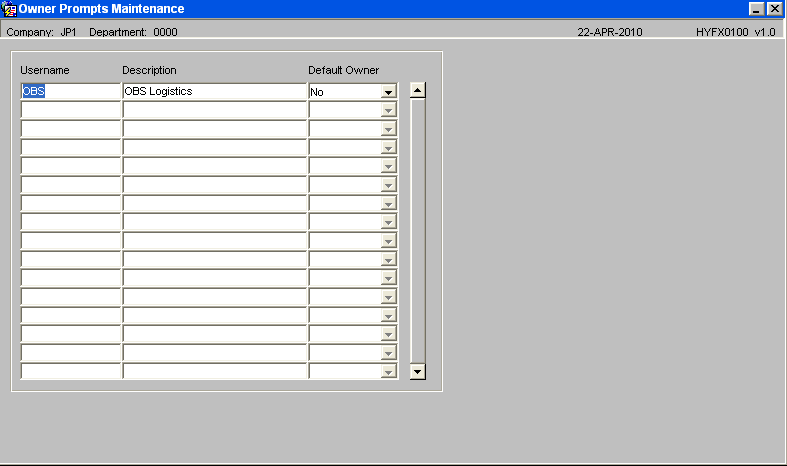
| Field Name | Description | Options | Generic Value |
| Username | The logon id onto the wms system | Defaulted in from users maintenance – no entry allowed | Defined by the client |
| Description | The name assigned to the logon id | Defaulted in from users maintenance – no entry allowed | Defined by the client |
| Default Owner | Determines whether this logon id should have its owner defaulted throughout the wms | Y or N – default is N | Defined by the client |
Owner Copy
The form will enable the user to create a new owner by copying an existing owner and all of its requisite data settings and parameters.
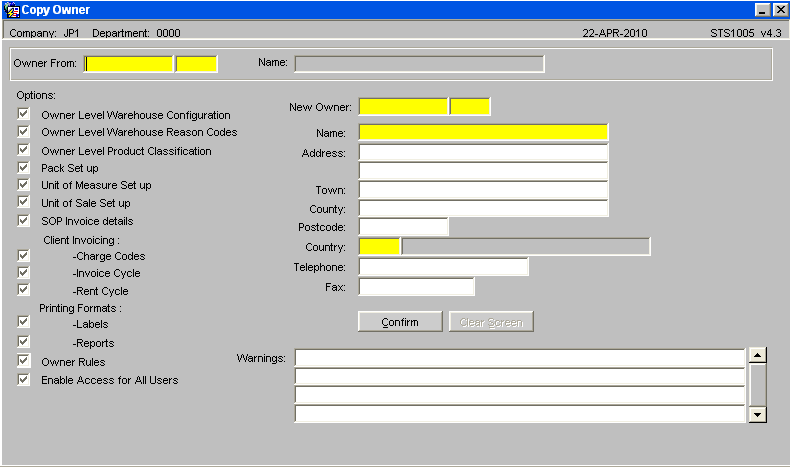
| Field Name | Description | Options | Generic Value |
|---|---|---|---|
| Owner From | Owner code of an existing client whose configuration you wish to copy | Look up on Owner table | Defined by User |
| Sub code | Sub code of the existing owner | Enter standard code | 001 |
| Name | Name of the owner | As held against the owner code | System value |
| Options | A list of options that can be selected or omitted during the copy routine | ||
| Owner Level Warehouse Configuration | Will copy Owner System Parameters - WHS0012 | Y or N | Y |
| Owner Level Warehouse Reason Codes | Not yet migrated | Y or N | Y |
| Owner Level Product Classification | Will copy Product Class Maintenance - STKPRCO01A | Y or N | Y |
| Pack Set up | Will Copy Pack Parameter Maintenance - WHS1944 | Y or N | Y |
| Unit of Measure Set Up | Will copy UOM Maintenance - SOS1300 | Y or N | Y |
| Unit of Sale Set up | Will copy Sales Units from Owner Maintenance/Unit of Sale tab - STS1000 | Y or N | Y |
| SOP Invoice Details | Will copy Sales Order Invoicing details | Y or N | Y |
| Client Invoicing - Charge Codes | Will copy the owner associated charge codes - WHS7100 | Y or N | Y |
| Client Invoicing - Invoice Cycle | Will copy the invoice cycle parameters - Owner Maintenance/Charging | Y or N | Y |
| Client Invoicing - Rent Cycle | will copy the rent cycle parameters - Owner Maintenance/Charging | Y or N | Y |
| Printing Formats - Labels | Will copy label formats i.e. Receipt Pallet Labels | Y or N | Y |
| Printing Formats - Reports | Will copy report formats i.e. Pick List and Despatch formats | Y or N | Y |
| Owner Rules | Will copy the Owner Rules table and it settings | Y or N | Y |
| Enable Access for All users | The ower code will be inserted into the profile of all users on the Database - FXMUSER/Owners | Y or N | Y |
| New Owner Details | |||
| New Owner ** | The new owner code followed by the sub code | 10 Character field - Alpha/Numeric | Defined by user |
| Name ** | The name of the new owner | 30 Character field - Alpha/Numeric | Defined by user |
| Address | Address details | Optional | Defined by user |
| Town | Town | Optional | Defined by user |
| County | County | Optional | Defined by user |
| Postcode | Postcode | Optional | Defined by user |
| Country ** | County | Look up on Countries Table | Defined by user |
| Telephone | Telephone | Optional | Defined by user |
| Fax | Fax | Optional | Defined by user |
| Warnings | Any options or parameters that cannot be copied from the original template will generate a warning/information message. Please note that the owner will still be created but the issues shown will need to be addressed. | ||
| Buttons | |||
| Confirm | Button that will create the new owner code with the selected options | ||
| Clear Screen | Button that will clear the form ready for the creation of the next record | ||
Customer & Supplier Set-up
This document describes the required screens to be used in setting up the information concerned with the Sales Order Process in the warehouse. Other guides describe the set up of company, user, warehouse, owners etc.
This is a generic guide based on the version of the CALIDUS WMS system at the time of writing.
It can also be used by clients to specify their specific data values to aid initial system set up as well as for future reference.
Note that fields marked '**' are mandatory and are needed to ensure correct set up of the system.
CUSTOMER CLASS MAINTENANCE (SOPCUCL01A)

| Field Name | Description | Options | Generic Value |
| Class ** | Code used to determine the type of customer (i.e. retail, wholesale etc) | 4 character free text field | Defined by the client |
| Description | Description of the customer class | 20 character free text field or left blank | Defined by the client |
CUSTOMER TYPES MAINTENANCE (WHS4010)
| Field Name | Description | Options | Generic Value |
| Type ** | The type of customer being delivered to | 2 character free text field | Defined by the client |
| Description | The description of the customer type | 30 character free text field or left blank | Defined by the client |
CUSTOMER PRIORITY MAINTENANCE (CASS5017)
Used for cross docking and order segregation, a priority set against a customer will determine which customers can be cross docked to.
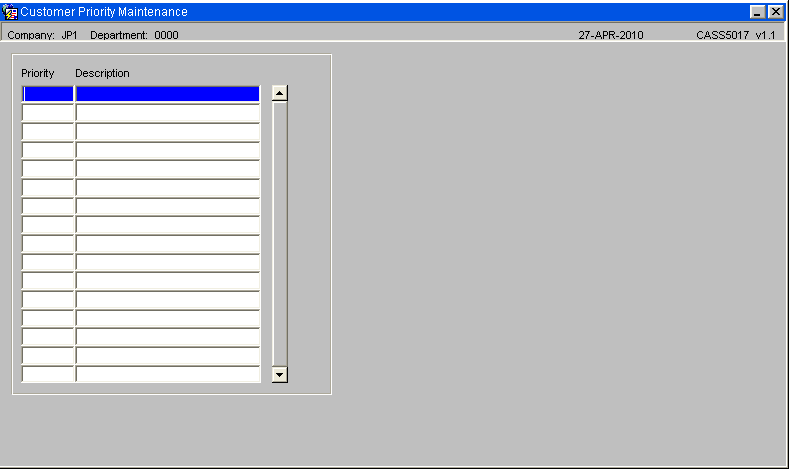
| Field Name | Description | Options | Generic Value |
| Priority ** | The priority code used | 1 character free text field | ‘X’ |
| Description | The description of the priority code | 30 character free text field | Defined by the client |
CUSTOMER WIZARD - DELIVERY DETAILS (WHSORA035)
Customer Wizard - Invoice Address (WHSORA035)
| Field Name | Description | Options | Generic Value |
|---|---|---|---|
| Partner Code ** | Customer code and sub code (Sub code must always be ‘001’) | 10 character free text field | Defined by the client |
| Full Name ** | Full name of the customer | 35 character free text field | Defined by the client |
| Currency ** | The currency code for the customer is to be invoiced in | Must have been created in currency codes maintenance – LOV available | Defined by the client |
| Address Type ** | The default address type for this customer and the address number | DEL – you can have multiple addresses for one customer | DEL |
| Name ** | The customer’s name | 35 character free text field | Defined by the client |
| Address ** | The first two lines of the customer’s address | 2 x 35 character free text field (note, 2nd line can be left blank) | Defined by the client |
| Town ** | The town the customer resides in | 35 character free text field | Defined by the client |
| Post Code ** | The post code/zip code for the customer | 10 character free text field | Defined by the client |
| County | The county /state for the customer | 15 character free text field or left blank | Defined by the client |
| Country | The country code for the customer | Must have been created in Country codes maintenance or left blank – LOV available | Defined by the client |
| Phone No | The telephone number for the customer | 15 character free text field or left blank | Defined by the client |
| EAN Reference | Client specific EAN number for this customer | 13 character free text field or left blank | Defined by the client |
| Transport Charge | The amount to be charged to the customer for transport | 10 digit numeric field | Defined by the client |
| Invoice Date | The date the customer was last invoiced | Display only | N/A |
| Customer Creation Date | The date the customer code was created | Display only | N/A |
| Last Amendment Date | The date details of the customer code were changed | Display only | N/A |
| Statement Date | The last statement date for the customer | Display only | N/A |
| Last Payment Date | The date the customer last paid an invoice | Display only | N/A |
| Buttons | |||
| New Delivery Address | Enables the user to add a new address for the customer | n/a | n/a |
| Warehouse Details | Enables the user to enter warehouse specific details for the customer (not migrated) | n/a | n/a |
Customer Wizard – Invoice Address (WHSORA035)
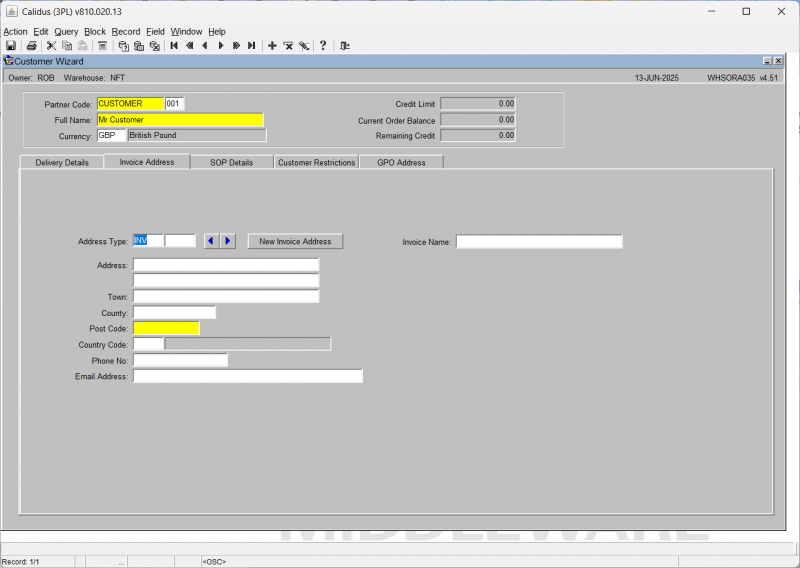
| Field Name | Description | Options | Generic Value |
|---|---|---|---|
| Address Type ** | The default address type for this customer and the address number | INV – you can have multiple addresses for one customer | INV |
| Address ** | The first two lines of the customer’s invoice address | 2 x 35 character free text field (note, 2nd line can be left blank) | Defined by the client |
| Town ** | The town of the invoice address | 35 character free text field | Defined by the client |
| Post Code ** | The post code/zip code for the invoice address | 10 character free text field | Defined by the client |
| County | The county /state of the invoice address | 15 character free text field or left blank | Defined by the client |
| Country Code | The country code of the invoice address | Must have been created in Country codes maintenance or left blank – LOV available | Defined by the client |
| Phone No | The telephone number of the invoice address | 15 character free text field or left blank | Defined by the client |
| Buttons | |||
| New Invoice Address | Enables the user to add an additional invoice address for the customer | n/a | n/a |
Customer Wizard – SOP Details (WHSORA035)
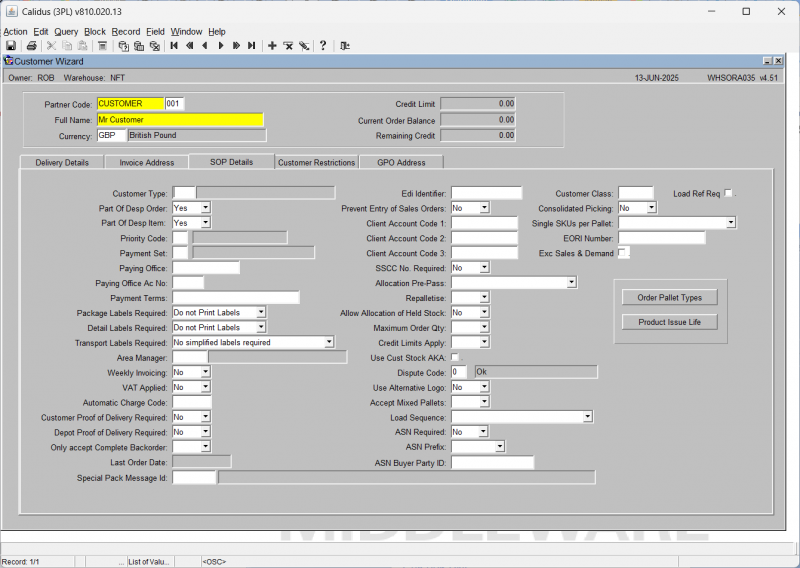
| Field Name | Description | Options | Generic Value |
|---|---|---|---|
| Customer Type | The customer type for this customer | Must have been created in customer types maintenance | Defined by the client |
| Part of Desp Order | Determines whether an order can be despatched if the whole order is not fulfilled (not migrated) | Y or N | Defined by the client |
| Part of Desp Item | Determines whether an order can be despatched if the whole product quantity is not fulfilled (not migrated) | Y or N | Defined by the client |
| Priority Code | The priority code for the customer | Must have been created in priority codes maintenance – LOV available | Defined by the client |
| Payment Set | The group code for the customer under which the invoice will be paid (not migrated) | 1 character free text field or left blank | Defined by the client |
| Paying Office | The office name where the invoice will be paid from (not migrated) | 10 character free text field or left blank | Defined by the client |
| Paying Office Ac No. | The account number for the invoicing paying office | 3 character free text field or left blank | Defined by the client |
| Package Labels Req | Does this customer require packing labels | Do Not Print Labels | Defined by the client |
| Print At All Levels | |||
| Print Labels | |||
| Detail Labels Req | Are packing labels required at detail level? (By stock code) | Do Not Print Labels | Defined by the client |
| Print At All Levels | |||
| Print Labels | |||
| Transport Labels Req | Are transport labels required | No Simplified Labels Required | Defined by the client |
| Yes, Produce Simplified Labels | |||
| Area Manager | The name of the area manager for this customer | 4 character free text field or left blank | Defined by the client |
| Special Pack Msg Id | The id code for a message that is to be produced at packing | 6 character free text field or left blank | Defined by the client |
| Weekly Invoicing | Does the customer require invoicing? (not migrated) | Y or N | Defined by the client |
| Vat Applied | Is V.A.T to be applied to the customer’s invoices? (not migrated) | Y or N | Defined by the client |
| Automatic Charge Code | If an automatic charge is to be applied to the invoice, what is the code for this charge | 5 character free text field or left blank | Defined by the client |
| Customer POD Req | Does the customer require a POD | Y or N | Defined by the client |
| Depot POD Required | Does the customer require an additional depot POD (not migrated) | Y or N | Defined by the client |
| Only Accept Complete Back Order | If backordering is used, will the customer only receive orders that completely fulfilled (not migrated) | Y or N | Defined by the client |
| EDI Identifier | The code that will be used to identify this customer on EDI flows (not migrated) | 11 character free text field or left blank | Defined by the client |
| Prevent Ordering | If set to ‘Y’, orders will not be able to be raised against this customer | Y or N | Defined by the client |
| Client Account Code 1 | An account number for the customer which will be produced on outbound documentation | 10 character free text field or left blank | Defined by the client |
| Client Account Code 2 | An additional account number for the customer which will be produced on outbound documentation | 10 character free text field or left blank | Defined by the client |
| SSCC No. Required | Are SSCC numbers to be used for this customer | Y or N | Defined by the client |
| Last Order Date | The date an order was last raised for this customer | Display only | N/A |
| Repalletise | Do orders need to be repalletised for this customer | Y or N | Defined by the client |
Customer Wizard – Customer Restrictions (WHSORA035)
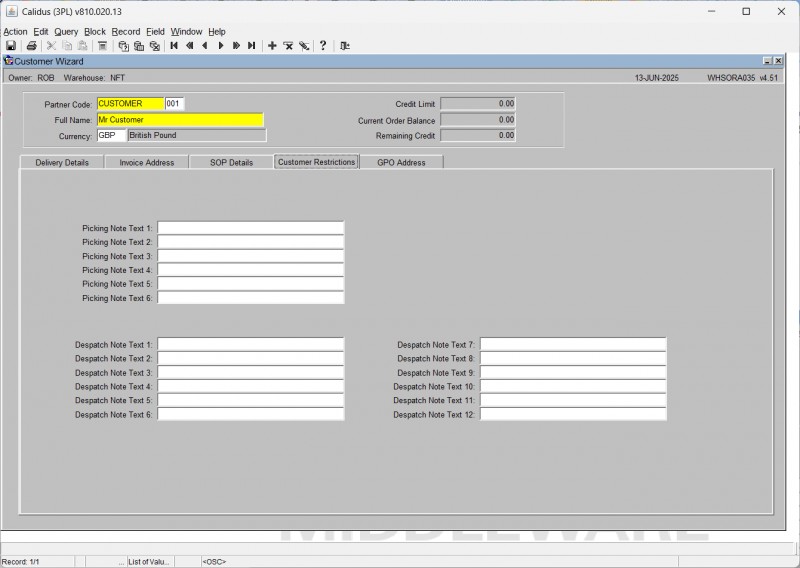
| Field Name | Description | Options | Generic Value |
|---|---|---|---|
| Picking Note Text 1-6 | Text entered here will be produced on the picking list | 6 x 40 character free text fields or left blank | Defined by the client |
| Despatch Note Text 1-10 | Text entered here will be produced on the delivery note | 10 x 40 character free text fields or left blank | Defined by the client |
Warehouse
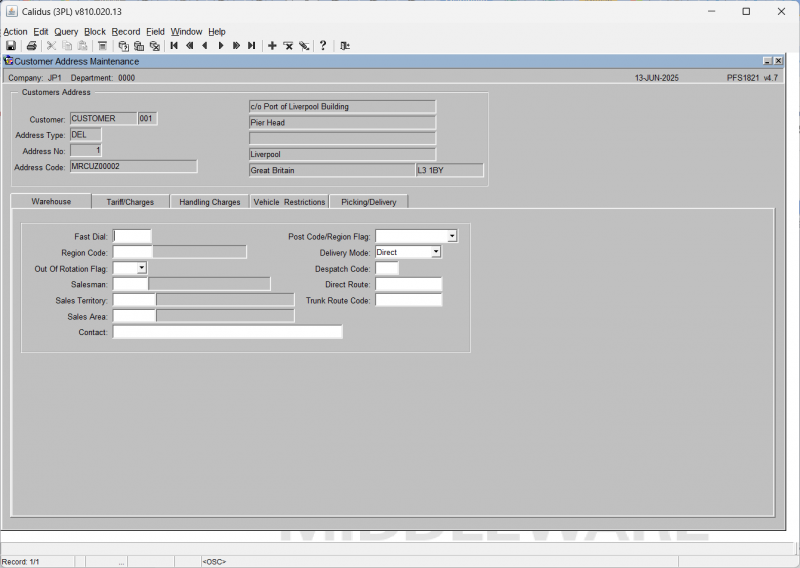
| Field Name | Description | Options | Generic Value |
|---|---|---|---|
| Fast Dial | |||
| Region Code | |||
| Out of Rotation Flag | No, Yes | Yes | |
| Salesman | |||
| Sales Territory | |||
| Sales Area | |||
| Contact | |||
| Post Code/Region Flag | |||
| Delivery Mode | Direct, Trunk | Direct | |
| Despatch Code | |||
| Direct Route | |||
| Trunk Route Code |
Tariff/Charges
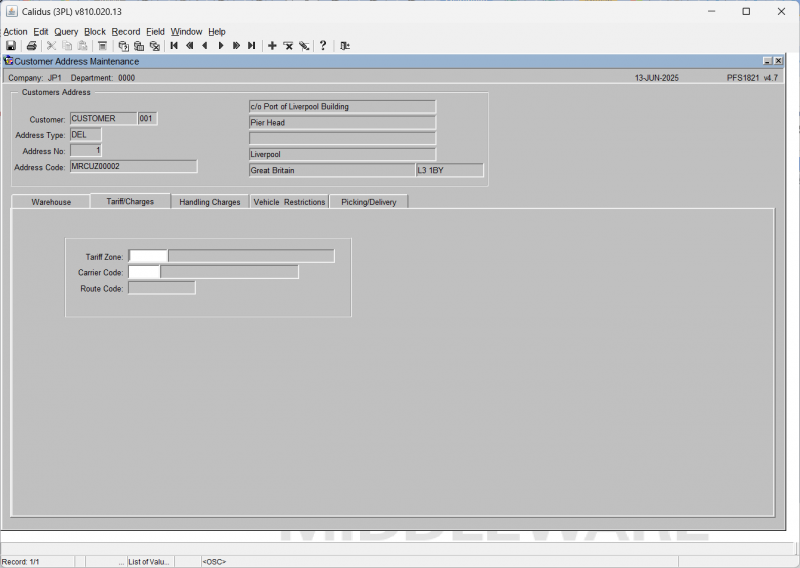
| Field Name | Description | Options | Generic Value |
|---|---|---|---|
| Tariff Zone | |||
| Carrier Code |
Handling Charges

| Field Name | Description | Options | Generic Value |
|---|---|---|---|
| Product Code | |||
| Handling Charge |
Vehicle Restrictions
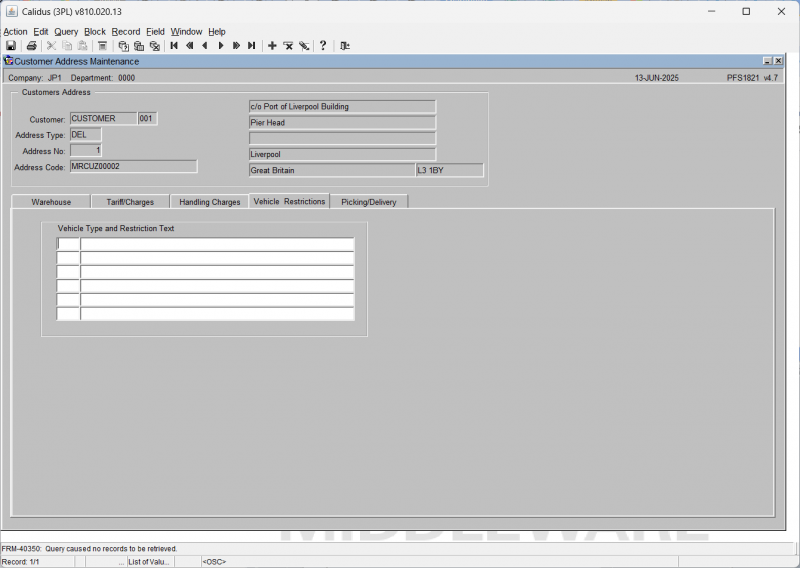
| Field Name | Description | Options | Generic Value |
|---|---|---|---|
| Vehicle Type | |||
| Restriction Text |
Picking/Delivery
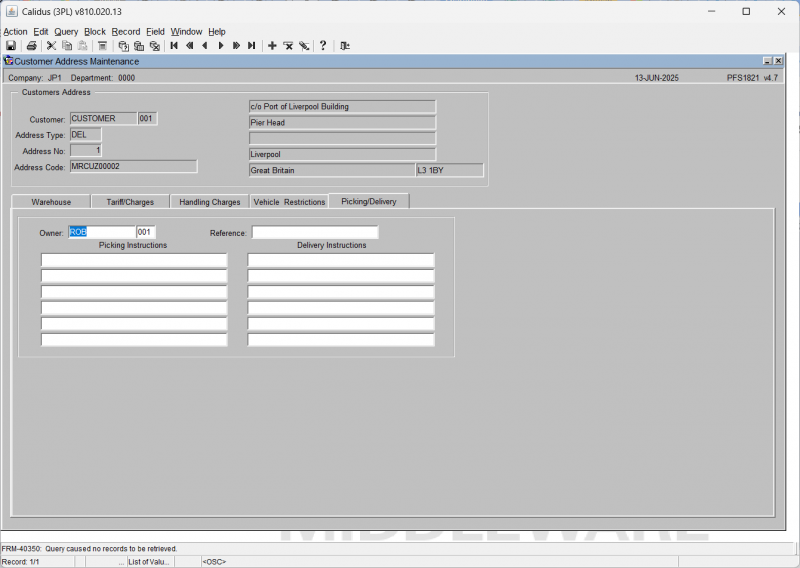
| Field Name | Description | Options | Generic Value |
|---|---|---|---|
| Owner | The owner. Display only | ||
| Reference | Any reference | ||
| Picking Instructions | if entered will appear on the pick note for that customer. | ||
| Delivery Instructions | if entered will appear on the despatch note for that customer. |
![]() Note: Not all pick note and despatch note formats will display instructions.
Note: Not all pick note and despatch note formats will display instructions.
SUPPLIER CLASS MAINTENANCE (PLGSPCL01A)

| Field Name | Description | Options | Generic Value |
| Code ** | The code for the supplier class | 4 character free text field | Defined by the client |
| Description ** | The description for the supplier class code | 20 character free text field | Defined by the client |
SUPPLIER WIZARD - SUPPLIER DETAILS (WHSORA045)

| Field Name | Description | Options | Generic Value |
|---|---|---|---|
| Ledger Code ** | The ledger code the system uses to define which information can be used | PL1 | PL1 |
| Short Name | An abbreviated version of the customer name | 10 character free text field or left blank | Defined by the client |
| Supplier Type ** | The type of supplier this is. (Note, no maintenance screen has yet been created for this – so an Aptean staff member will have to create this using SQL) | Must have been created in supplier types – LOV available | Defined by the client |
| Supplier Class ** | The class of supplier this supplier is grouped under. | Must have been created in supplier class maintenance – LOV available | Defined by the client |
| Currency ** | The currency code for this supplier | Must have been created in currency codes maintenance – LOV available | Defined by the client |
| Tax No | The VAT number for the supplier | 20 character free text field or left blank | Blank |
| Cust Ledger/Customer | The default customer code for this supplier (note, the ledger code always needs to be prefixed) | SL1/Customer code – customer must have been created in customer wizard – LOV available | SL1/Defined by the client |
| Settle Method | The frequency in which the supplier will settle their invoices (not migrated) | Month, Day | N/A |
| Settle Days | The number of days before an invoice needs to be settled (not migrated) | 4 digit numerical field | N/A |
| Bonded Flag | Determines whether a supplier is bonded or not (not migrated) | Y or N | N/A |
| SSCC Control Flag | Determines whether this supplier requires SSCC labels | 0 – SSCC are Optional | Defined by the client |
| M – SSCC are Mandatory | |||
| Invoice Required | Determines whether an inbound commercial invoice will be required for the supplier (client specific) | No Comm Inv Required | No Comm Inv Required |
| Comm Inv Required Std Rec Only | |||
| Comm Inv Required All Rec | |||
| Dispute Code ** | The code used for disputing an invoice (not migrated) | 1 character free text field | 0 |
| Payment Set | The payment group for the supplier (not migrated) | 1 character free text field or left blank | Blank |
| Buyer | The buyer code for the supplier (not migrated) | 4 character free text field or left blank | Blank |
| Discount Days | The number of days the discount will be valid for (not migrated) - will default to 1 | 3 digit numerical field or left blank | Blank |
| Discount % | The Discount percentage to be applied to the invoice (not migrated) - will default to 0.00 | 7 digit numerical field or left blank | 0 |
| Credit Amount | The amount of credit this supplier has on an invoice (not migrated) – will default to 0.00 | 0 – 99999999.99 | 0 |
| Credit Limit | The amount of credit limit this supplier can have (not migrated) – will default to 0.00 | 0 – 99999999.99 | 0 |
| Balance | The current invoice balance for this supplier | Display only | N/A |
| Turnover | The turnover balance for this supplier | Display only | N/A |
| Approved Supplier | Is this supplier approved? (not migrated) | Y or N or left blank | Blank |
| Duplicate Advice Note No | Does the supplier allow duplicate advice note numbers at receipt? | Y or N | Defined by the client |
| Date Created | The date the supplier was created | Display only | N/A |
| Amendment Date | The date the supplier details were last changed | Display only | N/A |
| Date Last Invoice | The date the supplier was last invoiced | Display only | N/A |
| Date Last Payment | The date the supplier last paid an invoice | Display only | N/A |
| Date Last PO | The date the supplier last raised a purchase order | Display only | N/A |
| Date Last GR | The date a receipt was last raised for this supplier | Display only | N/A |
Supplier Wizard – Further Details (WHSORA045)
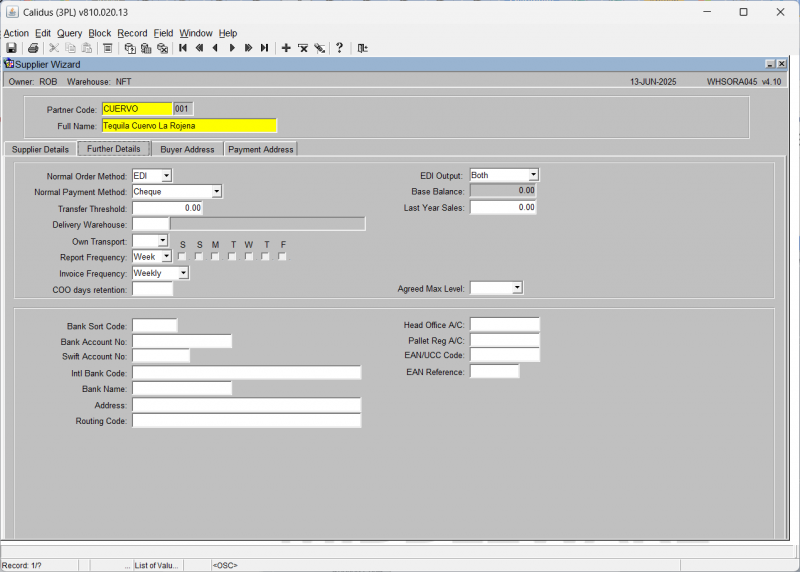
| Field Name | Description | Options | Generic Value |
|---|---|---|---|
| Normal Order Method ** | The method by which orders will be raised (not migrated) – will default to EDI | EDI, Post, Fax, Telex | EDI |
| Normal Payment Method | The method by which the supplier will pay invoices (not migrated) – will default to Cheque | Cheque, BACS, Credit Transfer | Cheque |
| Transfer Threshold | The maximum value before an invoice can be transferred (not migrated) – will default to 0.00 | 0 – 99999999.99 | 0 |
| Delivery Warehouse | The warehouse the supplier will default to (not migrated) | Must have been created in warehouse maintenance or left blank – LOV available | Blank |
| Own Transport | Does this supplier have their own transport (not migrated) – will default to Yes | Y or N | Yes |
| Report Frequency | The frequency in which reports are produced, If set to Day, the days they are to be produced on (not migrated) – will default to Week | Day | Week |
| Week | |||
| Month | |||
| Invoice Frequency | The frequency in which invoices are to be produced (not migrated) – will default to Weekly | Daily | Weekly |
| Weekly | |||
| Monthly | |||
| COO Days Retention | The number of days stock will be stored under this supplier before moving to another supplier (not migrated) | 3 digit numerical field or left blank | Blank |
| Bank Sort Code | The bank sort code for this supplier | 6 character free text field or left blank | Blank |
| Bank Account No | The bank account number for this supplier | 15 character free text field or left blank | Blank |
| Swift Account No | An account number for the Swift carrier account number (client specific) | 8 character free text field or left blank | Blank |
| Intl Bank Code | The international bank code for the supplier | 35 character free text field or left blank | Blank |
| Bank Name | The Bank Name for the supplier | 15 character free text field or left blank | Defined by the client |
| Address | The Bank address for the supplier | 35 character free text field or left blank | Defined by the client |
| Routing Code | The route code for the supplier | 35 character free text field or left blank | Defined by the client |
| EDI Output | The method by which the edi output will be produced (not migrated) – will default to Both | Autofax | Both |
| Both | |||
| Edi | |||
| File | |||
| None | |||
| Base Balance | The base value balance for this supplier (not migrated) | Display only | N/A |
| Last Year Sales | The amount of sales for last year (not migrated) – will default to 0.00 | 0 – 9999999.99 | 0 |
| Agreed Max Level | Does this supplier have an agreed maximum credit limit (not migrated) | Y or N or left blank | Blank |
| Head Office A/C | The head office account number for the supplier (not migrated) | 10 character free text field or left blank | Blank |
| Pallet Reg A/C | The registration account number for the supplier’s pallet account (not migrated) | 10 character free text field or left blank | Blank |
| EAN/UCC Code | The EAN code for the supplier | 10 character free text field or left blank | Defined by the client |
Supplier Wizard – Buyer Address (WHSORA045)
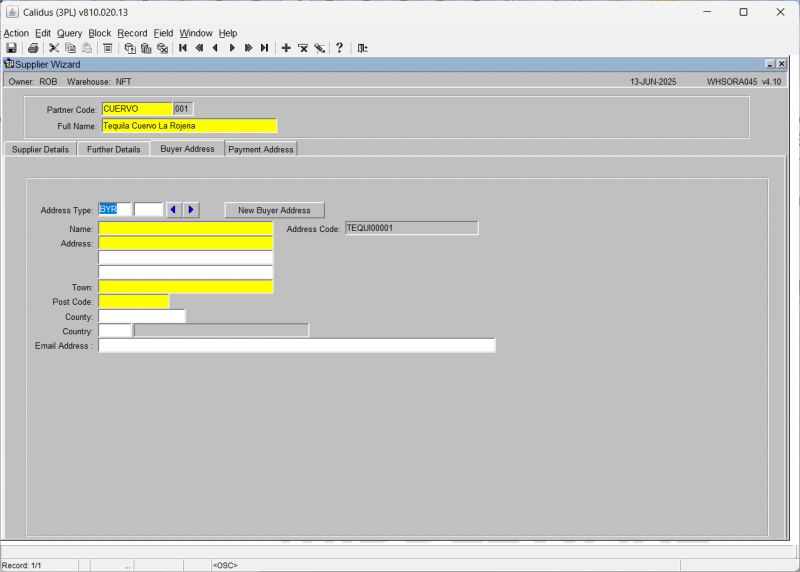
| Field Name | Description | Options | Generic Value |
|---|---|---|---|
| Address Type ** | The default address type for this customer and the address number | BYR – you can have multiple addresses for one customer | BYR |
| Name ** | The supplier’s name | 35 character free text field | Defined by the client |
| Address Code | The unique address identifier given by the WMS | Display only | N/A |
| Address ** | The first three lines of the customer’s invoice address | 3 x 35 character free text field (note, 2nd and 3rd line can be left blank) | Defined by the client |
| Town ** | The town of the invoice address | 35 character free text field | Defined by the client |
| Post Code ** | The post code/zip code for the invoice address | 10 character free text field | Defined by the client |
| County | The county /state of the invoice address | 15 character free text field or left blank | Defined by the client |
| Country | The country code of the invoice address | Must have been created in Country codes maintenance or left blank – LOV available | Defined by the client |
| Buttons | |||
| New Buyer Address | Enables the user to add an additional buyer address | ||
Supplier Wizard – Payment Address (WHSORA045)

| Field Name | Description | Options | Generic Value |
|---|---|---|---|
| Address Type ** | The default address type for this customer and the address number | PAY – you can have multiple addresses for one customer | PAY |
| Name ** | The supplier’s name to be paid to | 35 character free text field | Defined by the client |
| Address Code | The unique address identifier given by the WMS | Display only | N/A |
| Address ** | The first three lines of the supplier’s invoice address | 3 x 35 character free text field (note, 2nd and 3rd line can be left blank) | Defined by the client |
| Town ** | The town of the invoice address | 35 character free text field | Defined by the client |
| Post Code ** | The post code/zip code for the invoice address | 10 character free text field | Defined by the client |
| County | The county /state of the invoice address | 15 character free text field or left blank | Defined by the client |
| Country | The country code of the invoice address | Must have been created in Country codes maintenance or left blank – LOV available | Defined by the client |
| Phone No | The telephone number of the invoice address | 15 character free text field or left blank | Defined by the client |
| Buttons | |||
| New Payment Address | Enables the user to add an additional payment address | ||
Stock Set-up
This section describes the required screens to be used in setting up the information concerned with the stock to be stored in the warehouse. Other guides describe the set up of company, user, warehouse, owners etc.
This is a generic guide based on the version of the CALIDUS WMS system at the time of writing.
It can also be used by clients to specify their specific data values to aid initial system set up as well as for future reference.
Note that fields marked '**' are mandatory and are needed to ensure correct set up of the system.
OVERVIEW
The configuration dependency diagram below illustrates which configuration levels are contingent upon preceding configuration. The pre-requisites for setting up stock information are:
- Product type
- Product class
- Unit of measure
The main stock information is input in a number of tab screens within the main screen. Note that it is necessary to input all mandatory fields on all tabs before a product can be used within the system.
Once stock information is available it is possible to define:
- Substitute stock
- Sales kit configuration
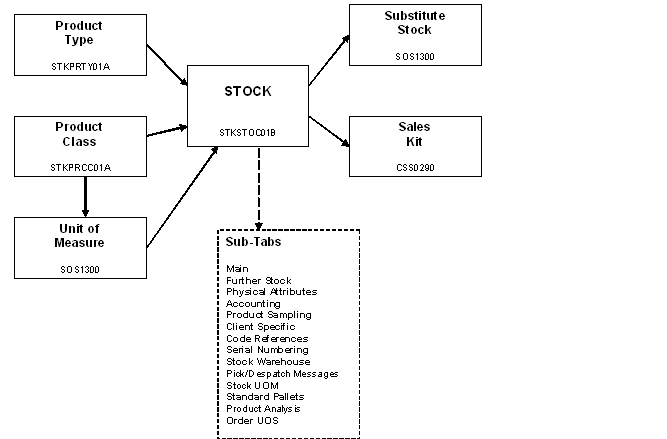
PRODUCT TYPE MAINTENANCE (STKPRTY01A)
Product type configuration is a pre-requisite to the configuration of products, given that product type is a mandatory field in the product configuration. Product types enable the grouping of stock, usually by physical classification. For example, frozen, chilled or ambient products may each be assigned a distinct product type, this will have an impact on how orders are processed and displayed in the system.
![]() Note: If an order is made up of multiple product types, the system will allow individual allocation and picking by product type, in effect splitting the pick list.
Note: If an order is made up of multiple product types, the system will allow individual allocation and picking by product type, in effect splitting the pick list.
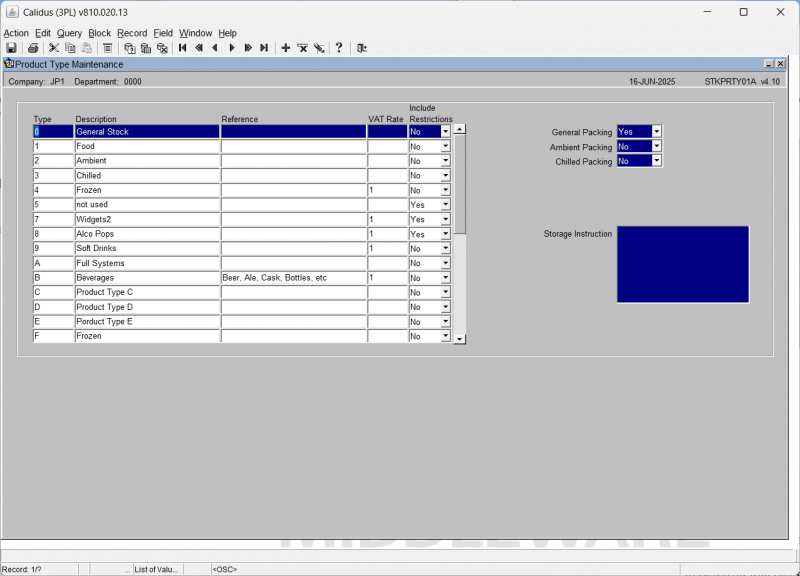
![]() Note: If RF is enabled there will be the option to send the entire table to the WCS (Send RF Data). All amended or newly created records are automatically sent to the WCS on update of the record.
Note: If RF is enabled there will be the option to send the entire table to the WCS (Send RF Data). All amended or newly created records are automatically sent to the WCS on update of the record.
| Field Name | Description | Options | Generic Values |
|---|---|---|---|
| Type | Specifies a particular product type. Product type differentiation enables separation of sales order processing via pick wave building. | 1 character free text field | Defined by the client |
| Description | Describes the product type as above | 30 character free text field or left blank | Defined by the client |
| Reference | Used with Owner Charging and Invoicing | 30 character free text field or left blank | Defined by the client |
| VAT Rate | Used with Owner Charging and Invoicing | 30 character free text field or left blank | Defined by the client |
| Include Restrictions | Yes, No | Defined by the client | |
| General Packing | Defines the General Packing process. Selecting this will disable Ambient and Chilled Packing. | Yes, No | |
| Ambient Packing | Defines the Ambient Packing process. Selecting this will disable General and Chilled Packing. This will also enable Temp Controlled Yes/No and Def Amb Temp Monitor. | Yes, No | |
| Chilled Packing | Defines the Chilled Packing process. Selecting this will disable General and Ambient Packing. | Yes, No | |
| Storage Instructions | Free text storage instructions | Free Text | |
| Temp Controlled Yes/No | Enabled when Ambient Packing is enabled. | Yes, No | |
| Def Amb Temp Monitor | Enabled when Ambient Packing is enabled. | List of Values | |
| Def Chill Temp Monitor | Enabled when Chilled Packing is enabled. | List of Values |
PRODUCT CLASS MAINTENANCE (STKPRCC01A)
Product Range, Class, Category and Group combinations are created in order to segregate stock within the warehouse. They can also be used to distinguish one type of product from another. You can use these combinations to specify putaway routines and for stocktaking purposes. Note, although you see all four here, when you set them up you have to create the range first, go through the rest of the fields and save the record. When you come to create the class field, you have to enter the range you just created and then go through the same process. In this way, you can have multiple combinations of all four criteria.

| Field Name | Description | Options | Generic Values |
|---|---|---|---|
| Prod Range ** | Used to denote a specific range for multiple products in conjunction with class, category and group | 1 character free text field | Defined by the client |
| Prod Class ** | Used to denote a specific class for multiple products in conjunction with range, category and group | 2 character free text field | Defined by the client |
| Prod Category ** | Used to denote a specific category for multiple products in conjunction with range, class and group | 2 character free text field | Defined by the client |
| Prod Group ** | Used to denote a specific group for multiple products | 2 character free text field | Defined by the client |
| Back Order ** | Used in union with other flags throughout the system to determine whether back ordering will be utilised Y or N | Defaults to No | N - Functionality not yet migrated |
| Preferred Location Bonded/Unbonded | Specifies putaway anchor points for the range,class,category,group combination | Must be valid locations or left blank - LOV available | Defined by the client |
| Box Required | Yes, No | ||
| Temp Monitor Required | Yes, No | ||
| Include in PO | Yes, No |
UNIT OF MEASURE MAINTENANCE (SOS1300)
Unit of measure maintenance, enables the configuration of warehouse storage medium for specific product groups, this level of configuration is a pre-requisite for the configuration of individual products, in that the UOMs configured against a product group will be applied to the stock codes that are assigned that product grouping.

| Field Name | Description | Options | Generic Values |
|---|---|---|---|
| Range, Class, Category ** | No entry allowed, the screen comes in as query mode and you find the combination of range, class, category you wish to assign valid unit of measures to. | Must already have been created in product class maintenance - LOV available | Defined by the client |
| Unit of Measure ** | Used to define what media the products will be packaged in/stored on. This will be used later in processing to determine how goods will be received into/ despatched from the warehouse. | 6 character free text field | Defined by the client |
| Unit of Measure 1/2/3 | 6 character free text field | Defined by the client | |
| Stocking Unit of Measure | 6 character free text field | Defined by the client |
STOCK MAINTENANCE (STKSTOC01B)
This form and all the tabbed sub screens carry all the product level configuration settings.
Stock Maintenance - Main Tab
First group of general product details.

| Field Name | Description | Options | Generic Value |
|---|---|---|---|
| Owner ** | Owner code the product is to be created against (the description will default to that setup in owner maintenance) | Must have been created in owner maintenance and be assigned to the current login id (will default to common) - LOV available | Defined by the client |
| Stock code ** | The product code you will be creating | 20 character free text field | Defined by the client |
| Description ** | The description of the product you are creating. This description will appear on pick lists and receipt notes etc | 30 character free text field | Defined by the client |
| Description 2 | An additional description for the product | 30 character free text field or left blank | Blank |
| Description 3 | An additional description for the product | 30 character free text field or left blank | Blank |
| Size | The size if required of the product | 10 character free text field or left blank | Blank |
| Product Range ** | The product range this product is grouped under | Must have been created in product class maintenance - LOV available | Defined by the client |
| Product Class ** | The product class this product is grouped under | Must have been created in product class maintenance - LOV available | Defined by the client |
| Product Category ** | The product category this product is grouped under | Must have been created in product class maintenance - LOV available | Defined by the client |
| Product Group ** | The product group this product is grouped under | Must have been created in product class maintenance - LOV available | Defined by the client |
| Product Sub-Group | The product sub-group this product is grouped under | Defined by the client | |
| Unit of Measure 1 ** | The first (smallest) packaging type the product can be stored in | Must already be setup in unit of measure maintenance - LOV available | Defined by the client |
| Unit of Measure 2 ** | The second (main) packaging type the product can be stored in | Must already be setup in unit of measure maintenance - LOV available | Defined by the client |
| Unit of Measure 3 ** | The last (pallet) packaging type the product can be stored in | Must already be setup in unit of measure maintenance - LOV available | Defined by the client |
| Factor (uom1 to uom2) ** | The quantity of uom1 within uom2 | 0-9999999 | Defined by the client |
| Factor (uom2 to uom3) ** | The quantity of uom2 within uom3 | 0-9999999 - NB - the two factors together cannot exceed 9999999 | Defined by the client |
| Stocking Unit of Measure ** | The default warehouse storage unit of measure - this will determine what quantities of goods are stored at receipt | Must already be set up in unit of measure maintenance and must be one of the three units of measure setup for this product - will default to UOM2 - LOV available | Defined by the client |
| Sales Kit | Determines whether the product will be a kit master, a component or not part of a kit | Both, No, Yes or Blank - will default to No | No |
| Convert Units | If goods are to be broken up in cases and units, determines whether a product will be 'exploded' from units into cases at order entry | Enter, Grams, Kilograms, Yes, No or Blank - will default to No | Defined by client |
| Product Status ** | Determines whether the product is available for processing or not | A - Active (can be used for IB and OB)
I - Inactive (cannot be used for processing) R - Redundant (can only be used for orders until all stock is cleared down) N - New (can only be used for receipts) |
Defined by client |
| Product Type ** | Specifies a product type against the current stock code | Must have been previously setup in product types maintenance - LOV available | Defined by client |
| To Transit | Allows an additional unit of measure to be assigned to a product to allow receipts of more than 9,999,999 - based on unit of sale 'I' for impressions | 0 - 9999999 - note, cannot exceed the combination with factor 3 (not yet migrated) | NA |
| Net Weight | Net weight of the product | 0 - 999999.99 or left blank | Defined by client |
| Net Weight UOM ** | Default weight format. Defined in the base_uom table | Left blank or LOV to select a valid value | Defined by client |
| Tax Code ** | Defines the default VAT rate for the product | Must have been set up in vat rates maintenance - LOV available | Defined by the client |
| Gross Weight | Gross weight of the product | 0 -999999.99 or left blank. If entered, must be greater than net weight | Defined by the client |
| Gross Weight UOM ** | Default weight format. Defined in the base_uom table | Defined by the client or left blank | Defined by the client |
| Normal Supplier ** | Default supplier this stock code will be received from | Must have been created in partners maintenance for this owner - LOV available | Defined by the client |
| Pallet Type ** | The default pallet type this product will be stored on - note this will work in conjunction with the factors of stock to work out how may pallet a quantity of cases equal to | Must have been created in pallet types maintenance - LOV available | Defined by client |
| ABC Code | Denotes whether a product is fast moving or not. Can be used for stocktaking purposes | 1 character free text field or left blank | Defined by the client |
| Country of Origin ** | Country code from where the stock was received from | Must have been created in countries maintenance - LOV available | Defined by the client |
| EAN Code | Specifies an EAN number for the product code | 30 character free text field or left blank | Blank |
| Bonded ** | Denotes whether a product is bonded or not | Y or N | N |
| Auditing ** | Determines whether a history of any changes to the product is required | Y or N | N |
| Button | Description |
|---|---|
| Copy Item | Will copy the stock code |
| Notes | Allow view and entry of notes |
Stock Maintenance - Further Stock Tab
Second group of general product details.
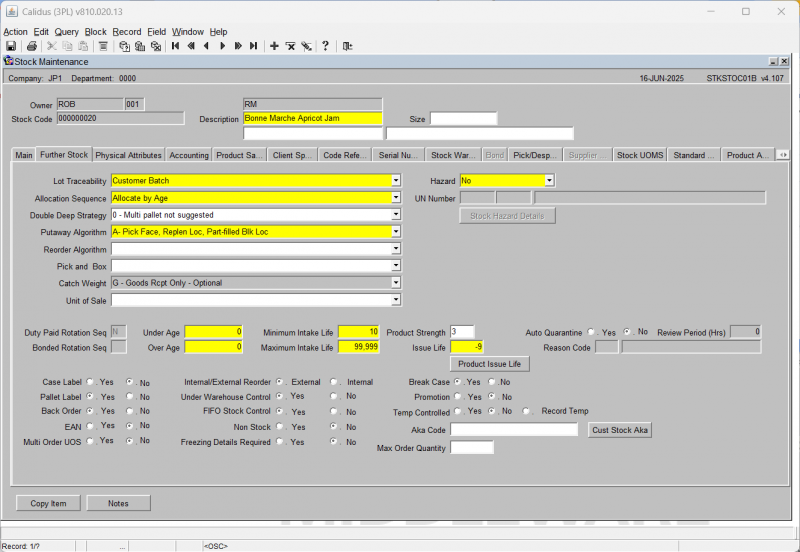
| Field Name | Description | Options | Generic Value |
|---|---|---|---|
| Lot Traceability ** | Determines what kind of rotation traceability you want for this product. This setting will prompt for this information at receipt | D - Customer Batch
F - No Customer Batch G - System Generated M - Manually Generated S - Sell by Date O - Manual Override P - Production Date T - Tea Garden Invoice N - No Rotation Note: lot traceability cannot be changed where there is on hand stock for the product |
G |
| Allocation Sequence ** | Allows the user to specify in what priority order allocation will take place for this product | A - Allocate by Age
C - Customer Batch S - System Batch R - Sys Batch in location and pallet sequence B - Sell By Date Note: allocation sequence cannot be changed where there is on hand stock for the product |
A |
| Double Deep Strategy | Dicatates whether multi-deep functionality will be utilised and if so, in what priority | 0 - Multi pallet not suggested
1 - Multi pallet prior to std. 2 - Multi pallet after std. 3 - Linked D.Deep prior to std or left blank |
0 |
| Putaway Algorithm ** | If auto putaway is to be utilised, determines which anchor point this product will use to start the putaway process. Note, there are 5 places to action autoputaway:-
Owner Bulk Locations Warehouse Bulk Locations Product Class Bulk Locations Location Class Bulk Locations Product Bulk Locations |
See AutoPutaway Section for details | A |
| Reorder Algorithm | Used for purchase order suggestion (not migrated) | 1 - Suppliers review days
2 - Daily replenishment Minm. 3 - Daily replenishment Maxm. 4 - As 1 + On Hand Qty of SW 5 - Required & available diff. Or left blank |
Blank |
| Pick and Box | Client specific packing functionality (not migrated) | C - One Case to a Box
N - None (Default) T - Cases to a Box||N | |
| Catch Weight | Determines whether an 'adhoc' weight is to be captured at receipt or outbound - will override stock weight if set - also used for specific functionality | C - Carton Wt. @ Rec/Pick
D - Carton Wt. @ Pick only F - Catch Wt. @ Pick Conf. N - No Catch Wt. recording P - Catch Wt. @ Order Entry For settings 'C' and 'D' carton weights are subtotalled to pallet level. |
N |
| Unit of Sale | Denotes an additional unit of measure for the product other than the standard UOM's created in stock maintenance (Main Tab.) Used mainly for reporting purposes (see 'To transit' for factorisation of unit to Impressions) | A -Area
I - Impressions L - Length P - Pack Q - Quantity V - Volume W - Weight Or left blank |
Blank |
| Hazard ** | Dictates whether a product is hazardous or not. Setting this flag to anything other than 'N' will take you into an additional hazardous details screen | N - No
S - In Storage W - In Warehouse Y - Yes |
No |
| UN Number | Hazardous required UN number. Only allowed entry if hazardous flag is other than 'N' | 4 character plus single character UN variant - must be already created in hazard maintenance or left blank | Blank |
| Auto Quarantine ** | Determines whether a product will be automatically put on hold at receipt. If Y is selected, the user will be prompted for a reason code and a review period | Y or N | N |
| Reason Code | The reason code used for stock to be automatically put on hold | Must have been created in reason codes maintenance - LOV available | Defined by the client |
| Review Period (Hrs) | The number of hours before the hold is released | 0 -9999 | Defined by the client |
| Duty Paid Rotation seq | Taken from ware_last_numbers of type ROT - no setup required | ||
| Bonded Rotation Seq | Taken from ware_last_number of type ROT - no setup required | ||
| Under Age ** | The number of days the stock is in the warehouse before it is under age (not migrated) Used in allocation - the system determines if it is under age based on the age of the stock + under age days and if this is greater than current date | 0 - 999999999 (displays only 8 digits) will default to zero | Defined by the client |
| Over Age ** | The number of days the stock is in the warehouse before it is over age (not migrated) Used in allocation - the system determines if it is under age based on the age of the stock + over age days and if this is less than current date | 0 - 999999999 (displays only 8 digits) will default to zero | Defined by the client |
| Minimum Intake Life ** | If sell by dates are required, determines the minimum number of days the product must be in the warehouse. Allocation will use this flag in conjunction with max intake life and issue life to establish if it the product is outside the sell by date allowance | 0 - 99999 will default to zero | Defined by the client |
| Maximum Intake Life ** | If sell by dates are required, determines the maximum number of days the product can be in the warehouse. Allocation will use this flag in conjunction with min intake life and issue life to establish if it the product is outside the sell by date allowance | 0 - 99999 will default to zero. This must be greater than or equal to the minimum intake life | Defined by the client |
| Product Strength | The strength of the product if applicable (will print on the pick list when migrated) | 2 character free text field | Defined by the client |
| Issue Life ** | If sell by dates are required, determines the actual shelf life of the product. Allocation will use this flag in conjunction with max intake life and min intake life to establish if it the product is outside the sell by date allowance | 0 - 99999 will default to zero | Defined by the client |
| Case Label | Determines whether case labels are required for the product. Currently only generic case labels are available | Y or N - will default to N | N |
| Pallet Label | Determines whether pallet labels are required for the product. Currently only generic and Schenker specific pallet labels are available | Y or N - will default to N | N |
| Back Order | Used in conjunction with product class and other flags, indicates whether this product can be back ordered | Y or N - will default to N | N |
| EAN | Indicates whether an EAN number is required | Y or N - will default to N | N |
| Multi Order UOS | Allows the user to enter an additional unit of sale at order entry if required | Y or N - will default to N | N |
| Internal/External Reorder | Used for automatic purchase ordering (not migrated) | E or I - will default to E | E |
| Under Warehouse Control ** | Specifies whether the product is under full warehouse control (not migrated) | Y or N | Y |
| FIFO Stock Control ** | Will determine at autoputaway whether FIFO will be considered | Y or N | Defined by the client |
| Non Stock ** | Specifies whether the product will actually be stored and monitored as a normal stock item or classed as a 'not in stock' i.e. not to be processed product | Y or N | N |
| Freezing Details Required ** | Determines, if product is to be frozen whether an additional box for freeze details will appear at receipt to capture date/ place frozen. | Y or N | N |
| Break Case ** | If a product is to be processed in both cases and units, specifies whether cases can be broken into units for this product in order to fulfil ordered unit qtys where no units are available at time of allocation. | Y or N | N |
| Promotion ** | Is this a promotional material? | Y or N | N |
| Temp Controlled ** | Specifies whether the product is temperature controlled. This will determine whether special processing throughout the system will be required | Y or N | N |
| Record Temp | If this flag is checked, the temperature recorded at receipt will be held on the system | Checked or left blank | Blank |
| Aka Code | An additional 'also known as' field to allow an alternative product code to be used | 20 character free text field or left blank | Blank |
| Max Order Qty | Maximum order quantity | 0-9999999 | |
| Buttons | |||
| Stock Hazard Details | Allows the user to enter specific hazardous information for the product | ||
Stock Maintenance - Physical Attributes Tab
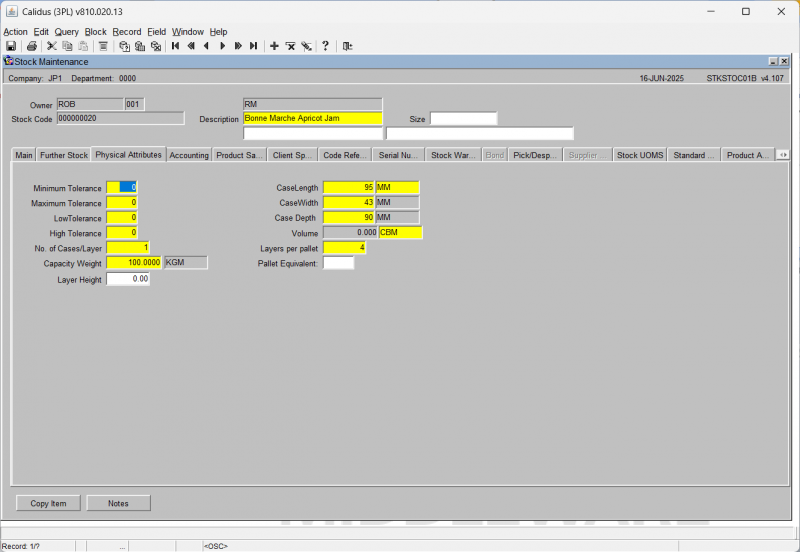
| Field Name | Description | Options | Generic Value |
|---|---|---|---|
| Minimum Tolerance | This determines the lowest catch weight value that can be entered at any point throughout the system. This percentage figure may be taken off the exact catch weight entry without error. Subtracting more than this percentage will trip an error condition. Consider a receipt of 10 cases of a product with a weight of 1Kg per case. The exact catch weight is 10Kg, but a Minimum Catch weight tolerance of 10.00% will allow 9Kg to be input. | Any lesser values than this will trip an error condition forcing re-input until the value is within the 10% tolerance range. (not migrated) 0 - 99999 - will default to zero | 0 |
| Case Length | The length of the case in the set UOM. The next field will allow you to set the value i.e. CM, IN | 0 - 99999999 - will default to zero - UOM will default to base UOM | 0 |
| Maximum Tolerance | This determines the highest catch weight value that can be entered at any point throughout the system. This percentage figure may be added onto the exact catch weight entry without error. Adding more than this percentage will trip an error condition. Consider a receipt of 10 cases of a product with a weight of 1Kg per case. The exact catch weight is 10Kg,but a Maximum Catch weight tolerance of 10.00% will allow 11Kg to be input. Any greater values than this will trip an error. | 0 - 99999 - will default to zero | 0 |
| Case Width | The width of the case in the set UOM. The UOM will be taken from the previous entry | 0 - 99999999 - will default to zero - UOM will default to base UOM | 0 |
| Low Tolerance | This determines the value at which a warning condition is tripped during catch weight entry. This percentage figure may be taken off the exact catch weight entry without warning. Subtracting more than this percentage will trip a warning condition. Any lesser values than this, up to and including the Minimum catch weight tolerance, will trip a warning condition. | 0 - 99999 - will default to zero | 0 |
| Case Depth | The depth of the case in the set UOM. The UOM will be taken from the previous entry | 0 - 99999999 - will default to zero - UOM will default to base UOM - note however, the combination of the length, width and depth cannot exceed 99999999 | 0 |
| High Tolerance | This determines the value at which a warning condition is tripped during catch weight entry. This percentage figure may be added onto the exact catch weight entry without warning. Adding more than this percentage will trip a warning condition. Consider a receipt of 10 cases of a product with a weight of 1Kg per case. The exact catch weight is 10Kg, but a High Catch weight tolerance of 5.00% will allow 10.5Kg to be input without warning. Any greater values than this, up to and including the Maximum catch weight tolerance, will trip a warning condition. | 0 - 99999 - will default to zero | 0 |
| Volume | Calculated field - sums up the length, width and depth of the product | N/A | N/A |
| No. of Cases/Layer | Normally used for pallet levelling - specifies how many cases per layer | 0 - 999999 - will default to std pallet qty, total cases per layer + layers/pallet cannot exceed total cases pallet in main tab | Defined by the client |
| Layers/Pallet | Normally used for pallet levelling - specifies how many layers per pallet | 0 - 999999 - will default to std pallet qty, total layers per pallet + cases/layer cannot exceed total cases per pallet in main tab. | Defined by the client |
| Capacity Weight | Sets the maximum weight for the pallet for this product. The UOM in the next field will default to the base UOM | 0 - 99999.9999 - will default to zero | 0 |
| Pallet Equivalent | |||
| Layer Height |
Stock Maintenance - Accounting Tab
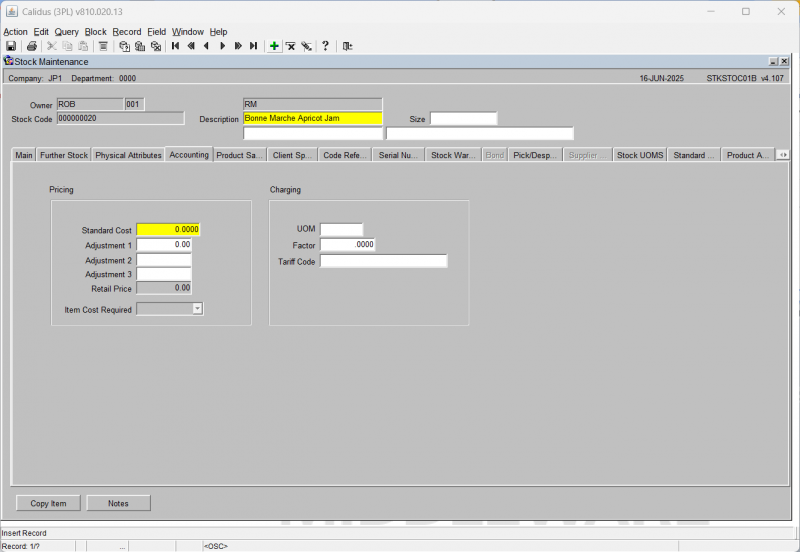
| Field Name | Description | Options | Generic Value |
|---|---|---|---|
| Standard Cost ** | The standard cost of the product (Purchase Price) | 0 - 999999.9999 | Defined by the client |
| Adjustment 1 | Any change to the standard cost can be added here - this will affect the retail price value (Fee 1) | 0 - 999999.99 or left blank | Blank |
| Adjustment 2 | Any change to the standard cost can be added here - this will affect the retail price value | 0 - 999999.99 or left blank | Defined by the client |
| Adjustment 3 | Any change to the standard cost can be added here - this will affect the retail price value | 0 - 999999.99 or left blank | Blank |
| Retail Price | A calculated field. This is a sum of the above four fields - NO ENTRY ALLOWED | 0 - 9999999.99 - note - the sum of the above 3 fields cannot exceed this quantity | N/A |
| UOM | The default unit of measure of the product | Must have been created in unit of measure maintenance or left blank - LOV avail | Blank |
| Factor | The charging factor placed against the default UOM | 0 - 99999.9999 - will default to zero | Blank |
| Tariff Code | |||
| Item Cost Required |
Stock Maintenance - Product Sampling Tab
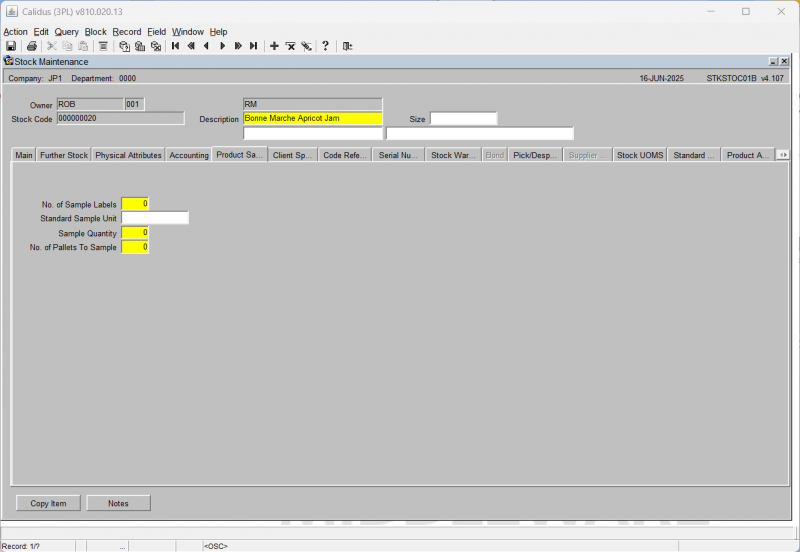
| Field Name | Description | Options | Generic Value |
|---|---|---|---|
| No. of Sample Labels ** | Enter the number of sample labels to be printed (not migrated) | 0 - 999 - will default to zero | 0 |
| Standard Sample Unit | Normally entered as the default UOM for the product - however no validation (not migrated) | 10 character free text field or left blank | Blank |
| Sample Quantity ** | The qty of UOM to be sent as a sample | 0 - 999 - will default to zero | 0 |
| No. of Pallets to Sample ** | The qty of pallets to be sent as a sample | 0 - 999 - will default to zero | 0 |
Stock Maintenance - Client Specific Tab
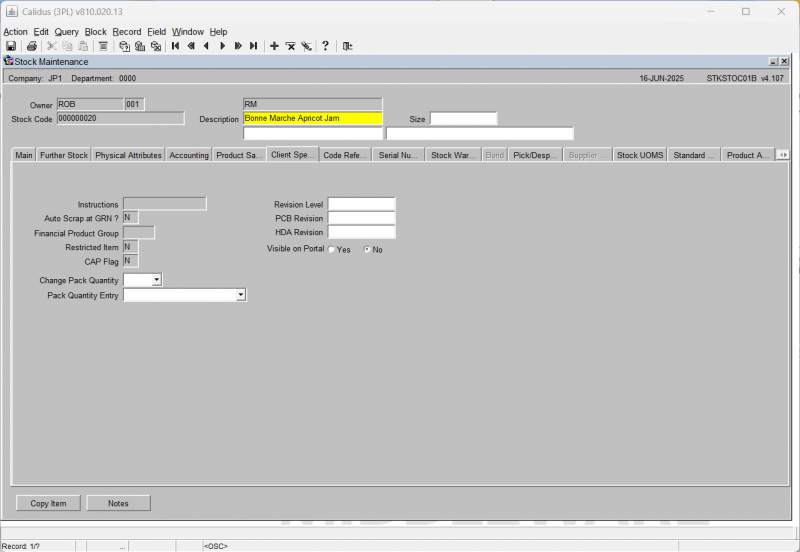
| Field Name | Description | Options | Generic Value |
|---|---|---|---|
| Instructions | The ability to enter instructions for the product to be printed at GRN (not migrated - No entry allowed) | None | Blank |
| Auto Scrap at GRN? | Denotes whether the product will be automatically scrapped at receipt (not migrated - No entry allowed) | None | Blank |
| Financial Product Group | Denotes a specific financial grouping criteria for the product (not migrated - No entry allowed) | None | Blank |
| Restricted Item | Affects later processing in the system - denotes a restricted item (not migrated - No entry allowed) | None | Blank |
| CAP Flag | Indicates whether or not a product operates under Common Agriculture Policy rules (not migrated - No entry allowed) | None | Blank |
| Revision Level | Allows extra information to be stored against the product - normally used for hardware type products i.e. v.8.2 | 10 character free text field or left blank | Blank |
| PCB Revision | Allows a PCB revision reference to be entered against the product | 10 character free text field or left blank | Blank |
| HAD revision | Allows an HDA revision reference to be entered against the product | 10 character free text field or left blank | Blank |
| Visible on Portal | No | ||
| Change Pack Quantity | Yes, No | Blank | |
| Pack Quantity Entry | Automated - 1 UOM, Manual Entry | Blank |
Stock Maintenance - Code References Tab
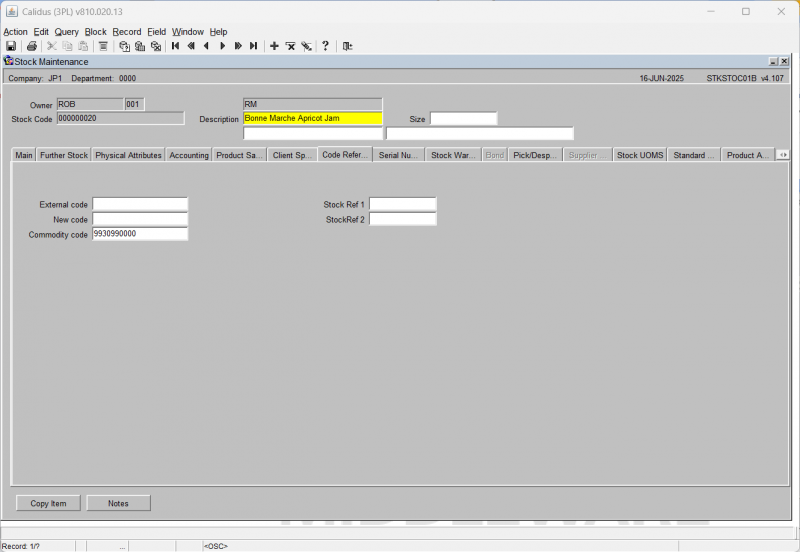
| Field Name | Description | Options | Generic Value |
|---|---|---|---|
| External Code | Client specific additional reference to a product - can be used for any client | 20 character free text field or left blank | Blank |
| New Code | Client specific field to allow entry of a new product code | 20 character free text field | Blank |
| Commodity Code | Allows entry of a customs specific commodity code | 20 character free text field | Blank |
| Stock Ref 1 | |||
| Stock Ref 2 |
Stock Maintenance - Serial Numbering Tab
This tab screen enables the configuration of a product to enable the capture of serial number details at a carton level at either the inbound or outbound stages.
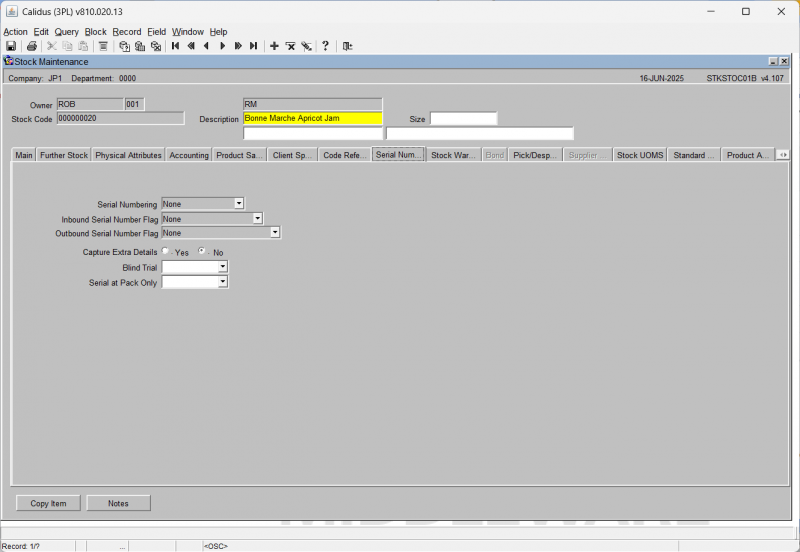
| Field Name | Description | Options | Generic Value |
|---|---|---|---|
| Serial Numbering ** | Determines whether serial numbering is required, and if so, how they are generated | 0 - Random
1 - Consecutive 2 - None||2 - None | |
| Inbound Serial Number Flag ** | Determines whether serial number capture is required at inbound | 0 - None
1 - Capture at Receipt |
0 - None |
| Outbound Serial Number Flag ** | Determines whether serial number capture is required at outbound, and if so, where. If serial numbers have been captured at inbound receipt or a product then on the outbound they can be assigned, otherwise serial numbers will be captured at outbound. | 0 - None
1 - Capture/assign at Pick 2 - Capture/assign Latest at Pack 3 - Capture/assign Latest at Despatch 4 - Capture/assign Latest at POD||0 - None | |
| Capture Extra Details ** | If serial numbers are required, is the additional information box required to capture carton level information (i.e. carton level catch weight) | Y or N - will default to N | N |
| Blind Trial | Y or N | Blank | |
| Serial at Pack Only | Y or N | Blank |
Stock Maintenance - Stock Warehouse Tab
This tab screen provides configuration control for a product's warehouse level settings. Note that there can be multiple records for a given product in cases where the product is stored in multiple warehouses.
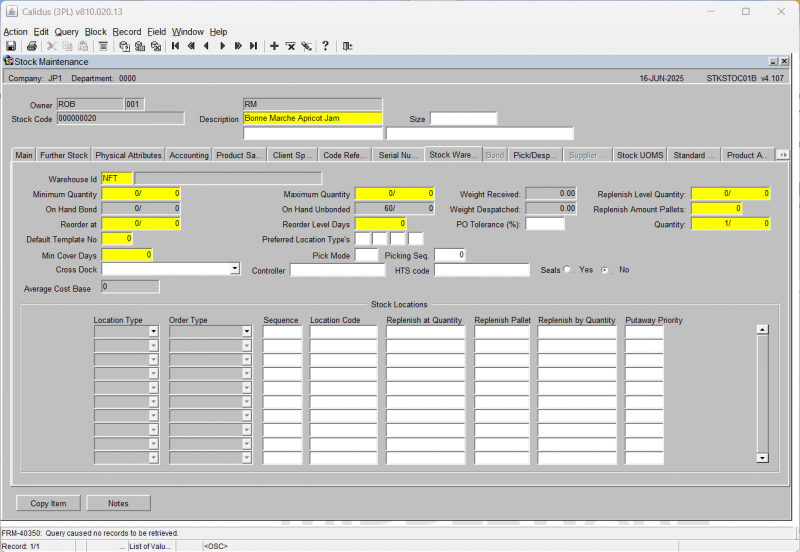
| Field Name | Description | Options | Generic Value |
|---|---|---|---|
| Warehouse ID ** | Assigns a warehouse ID for the product. Note, this record MUST be created in order for this product to be available for ordering/receipts | Must have been setup in warehouse maintenance - LOV available | Defined by the client |
| Minimum Quantity | Used for purchase order suggestion, states the minimum qty that can be in the warehouse before a PO is required (not migrated) | 0 - 99999999 (plus allows entry of 99999999 units) - will default to zero | 0 |
| Maximum Quantity | Used for purchase order suggestion, states the maximum qty that can be in the warehouse (not migrated) | 0 - 99999999 (plus allows entry of 99999999 units) - will default to zero | 0 |
| On Hand Bond | Calculated field that sums up the total bonded qty in stock for this warehouse - No entry allowed | None | NA |
| On Hand Unbonded | Calculated field that sums up the total unbonded qty in stock for this warehouse - No entry allowed | None | NA |
| Weight Received | Calculated field that sums up the total weight of product in receipt | None | N/A |
| Weight Despatched | Calculated field that sums up the total weight of product sent | None | N/A |
| Reorder at | Used for purchase order suggestion, states the reorder at qty for a PO to be created (not migrated) | 0 - 99999999 (plus allows entry of 99999999 units) - will default to zero | 0 |
| Reorder Level days | Used for purchase order suggestion, states the maximum qty that can be in the warehouse (not migrated) | 0 - 99999999 (plus allows entry of 99999999 units) - will default to zero | 0 |
| Default Template No | Allows information from a template to be passed into the product record (not migrated) | Must have been created in stock templates maintenance - LOV available - will default to 0 | 0 |
| Preferred Location Type's | Used to be used within the RF pre advice message - no longer used | 4 x 1 character fields or left blank | Blank |
| Min Cover Days | Used for purchase order suggestion, states the minimum number of days stock must be in the warehouse for (not migrated) | 0 - 99999999 - will default to zero | 0 |
| Pick Mode | Used at order entry, is related to the pallet levelling functionality. The pick modes set will dictate how pallet levelling occurs | 2 digit numerical field - must have been created in pick modes maintenance or left blank - LOV available | Blank |
| Picking Seq | |||
| Cross Dock | If a product is flagged as cross dock, it is then possible to raise an order without any stock and process it to status 5. When the stock arrives at receipt, you can 'cross dock' it and it will automatically allocate to the outstanding order. | 0 - Never
1 - Order Sequence with Warning 2 - Customer Sequence with warning 3 - Order Sequence without Warning 4 - Cust Sequence without warning||0 | |
| Controller | A client specific reference that can be applied to the product | 20 character free text field or left blank | Blank |
| HTS Code | A client specific customs reference that can be applied to the product for reporting purposes. | 20 character free text field or left blank | Blank |
| Seals ** | If this settings is checked as 'Y' a warning message will appear at receipt and packing to state seals are required | Y or N | N |
| Replenish Level Quantity | (greyed out for Bonded as not a bonded warehouse) - not used any more due to the flags being set within the Bonded/Unbonded Stock Locations Button | N/A | 0 |
| Replenish Amount Pallets | (greyed out for Bonded as not a bonded warehouse) - not used any more due to the flags being set within the Bonded/Unbonded Stock Locations Button | N/A | 0 |
| Replenish Amount Quantity | (greyed out for Bonded as not a bonded warehouse) - not used any more due to the flags being set within the Bonded/Unbonded Stock Locations Button | N/A | 0 |
| Average Cost Base | |||
| Stock Locations | |||
| Location Type ** | Determines what type of location you are setting | 1 - Bulk
2 - Pick 9 - Replenish M - Multi |
Defined by the client |
| Order type ** | Specifies for what order type the replenishment settings are for, should always set to 'H' Home Use | There are currently a range of options, non of which are currently supported | H - Home Use |
| Location Code ** | The location code to be used as the default for this product | Must have been created in location codes maintenance and be a valid use type against the /replenish type - LOV available | Defined by the client |
| Location Code | |||
| Replenish at Quantity | The minimum qty of cases/units to be in the location before a replenishment is triggered | 0 - 99999999/99999999 - will default to zero | Defined by the client |
| Replenish Pallet | The quantity of pallets by which the location will be automatically replenished | 0 - 99999999 | Defined by the client |
| Replenish by Quantity | The quantity of cases/units by which the location will be automatically replenished | 0 - 99999999/99999999 - will default to zero | Defined by the client |
| Putaway Priority | Determines in which order the location replenishments will take place | 0 - 99 | Defined by the client |
Stock Maintenance - Pick/Despatch Messages
This tab screen enables the configuration of product level message lines that can be configured for individual customers for reporting purposes, namely on despatch notes and pick lists.
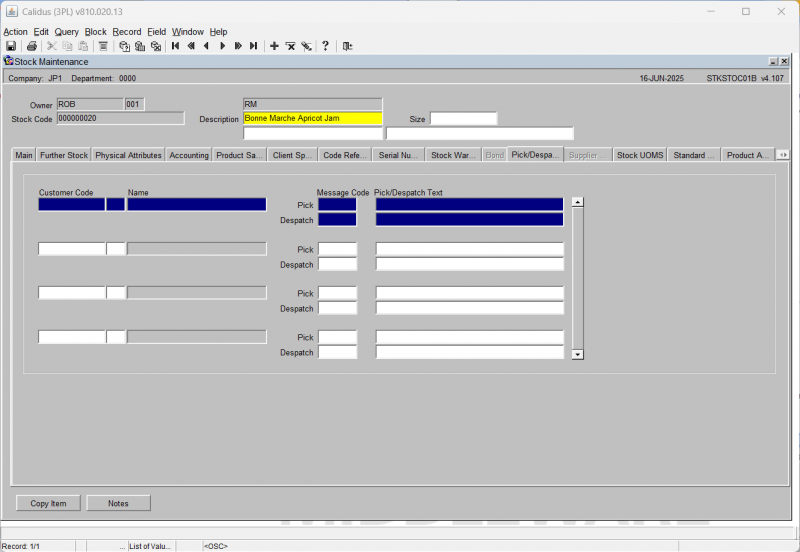
| Field Name | Description | Options | Generic Value |
|---|---|---|---|
| Customer Code ** | The customer code the pick/despatch messages will apply to | Must have been created in partners maintenance/customer wizard - LOV available | Defined by the client |
| Name | Will default in the customer name from the main settings | None | N/A |
| Pick Message Code ** | The template message text code to apply to this customer | 4 character free text field or left blank | Blank |
| Despatch Message Code ** | The template message text code to apply to this customer | 4 character free text field or left blank | Blank |
| Pick/Despatch Text | The text to apply to the message code you have just typed in. At order entry for this customer, you can then enter the message code and this text will automatically appear (not migrated) | 70 character free text field or left blank | Blank |
Stock Maintenance - Stock UOMS Tab
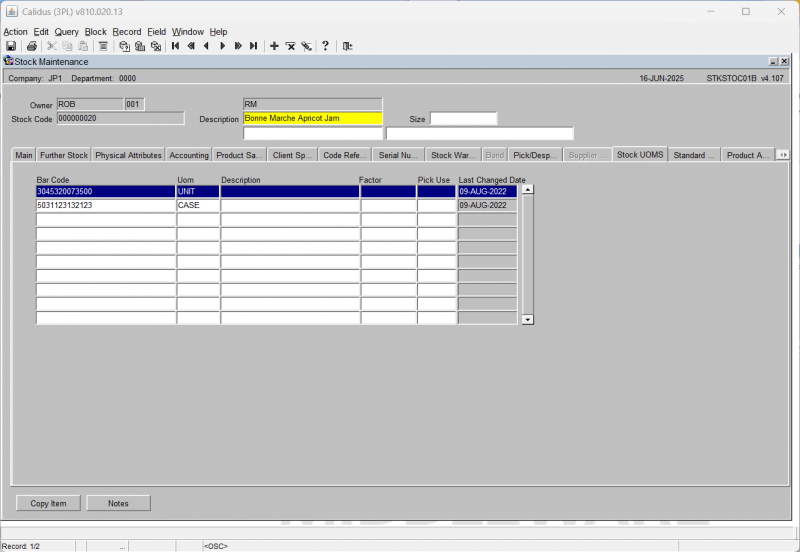
| Field Name | Description | Options | Generic Value |
|---|---|---|---|
| BarCode | The default bar code number used for this product/UOM combination. The user can have various barcodes for the different UOMS to be scanned by the RDT (not migrated) | 30 character free text field or left blank | Blank |
| Uom | The Unit of measure for this barcode | Must have been created in Unit of Measure maintenance - LOV available | Defined by the client |
| Description | Description of the particular Uom/barcode combination | 30 character free text field or left blank | Blank |
| Factor | Number of smallest Uom within the Uom entered | 0 - 99999999 | Blank |
| Pick Use | The factor level of the UOM. N.B. the factor for level 4 must be less that of 3, which must be less than that of 2 etc | - | Blank |
| Last Changed Date | The last time this information was changed. This is not editable, but is automatically captured for reference whenever changes are made. | - | - |
Stock Maintenance - Standard Pallets Tab
This screen enables the user to assign different pallet types and quantities per pallet to a product other than its default set in the main tab. This can then be used at receipt to enable multi auto putaway settings for different pallets into different location types.
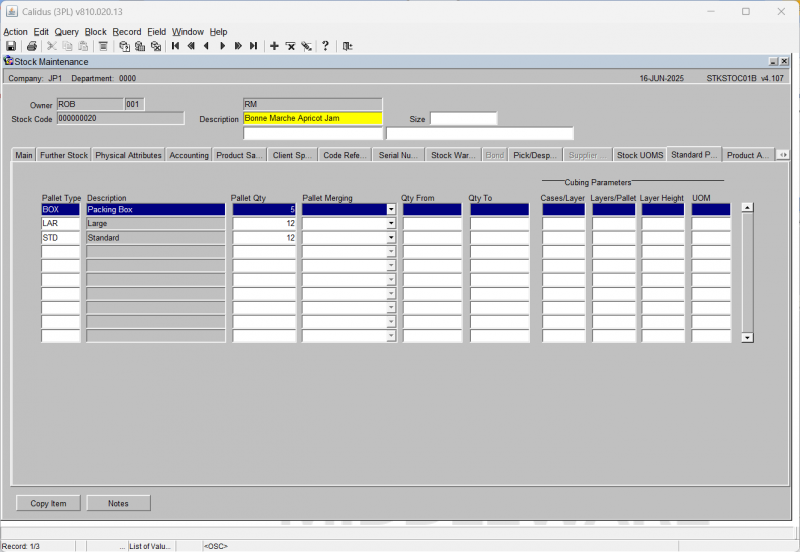
| Field Name | Description | Options | Generic Value |
|---|---|---|---|
| Pallet Type ** | The pallet type this product can be received in on | Must be set up in pallet types maintenance - LOV available (note, the first record will always be created from the default already set up) | Defined by the client |
| Description | The description of the pallet type will be automatically populated from the description set up in pallet types maintenance | None | N/A |
| Pallet Qty ** | The qty of stocking uom of this product to this pallet type | 0 - 9999999 | Defined by the client |
| Pallet Merging | |||
| Qty From | |||
| Qty To | |||
| Cubing Parameters | |||
| Cases/Layers | |||
| Layers/Pallet | |||
| Layer Height | |||
| UOM |
Stock Maintenance - Product Analysis Tab
This screen is used to assign analysis types to a particular product. Once assigned, this analysis type can be used to group products together and assign values to them.
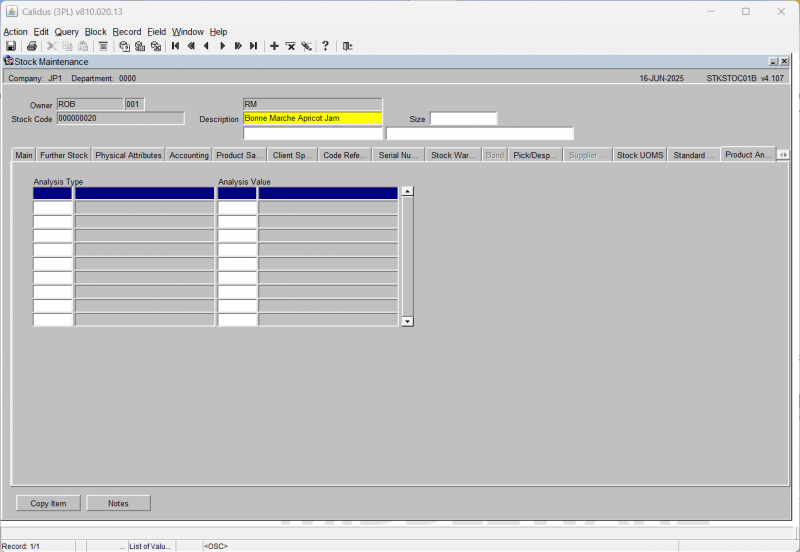
| Field Name | Description | Options | Generic Value |
|---|---|---|---|
| Product Analysis Type | The analysis type to be assigned to the product | Must have been created in product analysis maintenance (not migrated) | Blank |
| Product Analysis Value | The value assigned to this particular analysis type | 3 character free text field | Blank |
Stock Maintenance - Order UOS Tab
You are only allowed entry into this tab if you have the 'Multi Order UOS' box checked to Y in the Further Stock Tab. Facilitates ordering in multiple units of measure for conversion into case/unit quantities for allocation and picking.
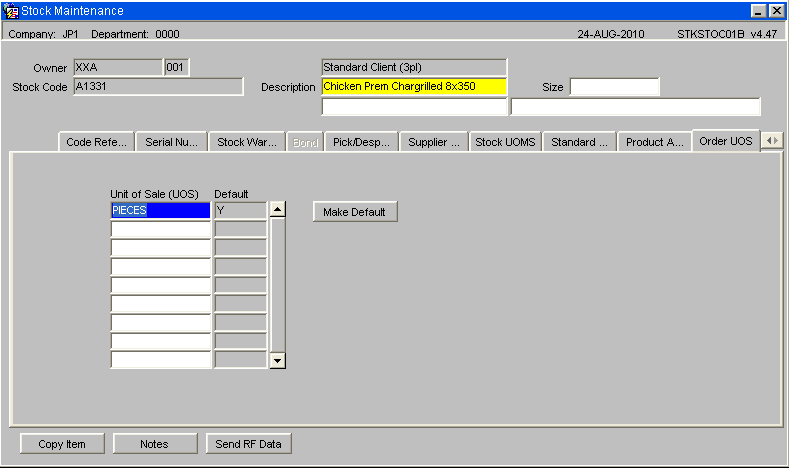
| Field Name | Description | Options | Generic Value |
|---|---|---|---|
| Unit of Sale (UOS) ** | The Unit of sale to be applied to the product | Must have been setup as one of the three units of measure and any other values set up in owner maintenance under owner UOS | Defined by the client |
| Default | Is this the default UOS | Y or N | Defined by the client |
| Buttons | |||
| Make Default | Allows the user to highlight the specific Unit of Sale and make this the default for the product | ||
Appendix A: Document History
A.1 References
| Ref No | Document Title & ID | Version | Date |
|---|---|---|---|
| 1 | |||
| 2 | |||
| 3 |
A.2 Glossary
| Term or Acronym | Meaning |
|---|---|
| Ad Hoc (WCS) | A task instigated on the device (spec. Ad Hoc Pallet Move), rather than a task instigated from the WMS and Stock Control. |
| Advice Note Number | An external reference linked to a Goods Receipt. |
| Aisle (WMS) | A component of a location; usually a space through rows of racking or storage locations; a collection of locations; |
| Allocation (order) | The systemic act of identifying and ring-fencing product matching the order requirements, following proscribed warehouse rules. |
| Anchor Point (WMS) | A starting location for a search for a suitable storage location; auto-putaway location suggestion start point. |
| Area (WMS) | A collection of aisles; an area in the warehouse for a particular purpose. |
| Batch (WMS) | A production batch of a product; a quantity of product that is considered to have the same characteristics; |
| Bay (Warehouse) | A physical loading or unloading point for the warehouse. |
| Bay (WMS) | A component of a location; usually a space between uprights in racking, comprising several levels (horizontal beams). |
| Bay Diary | The mechanism for booking hauliers inbound/outbound and assigning bays. The OBS Logistics system is CALIDUS Bay Diary. |
| Block Stack | A stable stack of pallets. |
| Booking | A time slot for a bay, booked with a Carrier/Haulier. |
| Bulk (WMS) | Bulk storage; Usually full-pallet storage areas, racked or stacked. |
| Cancellation (WCS) | The facility to cancel a task due to some problem, identified by the user when performing the task. |
| Carrier; Haulier | The transport company (by road or sea). |
| Check Digit (WMS) | A short code, usually randomly generated and stored against a location, used to help identify that a user is at the right location before they proceed with a warehouse task. |
| Container | The actual physical container, identified uniquely by the Container Number. The Container will be identified as a Container Type. |
| Container Type | Descriptive of the use and capability and physical characteristics of a container. Container types are 40ft End Loader, Reefer, etc. |
| Container Yard | The storage areas for full and empty locations in the facility. The OBS Logistics system to manage this area is CALIDUS Container Yard. |
| CSV | Character-separated values; a text file with multiple rows and values, usually separated with commas. |
| C-WCS | CALIDUS WCS, the name of the OBS Logistics Warehouse Control system |
| C-WMS | CALIDUS WMS, the name of the OBS Logistics Warehouse Management system |
| Dead Leg (WCS) | A movement of a truck without a pallet; wasted resource. |
| Despatch | The final physical stage of an order; handover of goods to the haulier. |
| De-stuffing | The act of emptying a container and storing the contents in the warehouse. |
| Drive-In | A drive-in location, typically multi-level, multi-deep location. |
| Dry Van | Any type of non-refrigerated container. |
| Dual Cycling | Processes utilizing P&D locations for interleaving tasks in and out of specific areas, reducing dead leg movements. |
| EDI | Electronic Data Interchange; any form of automatically or semi-automatically uploading or downloading information from a computer system without manually re-keying the information. |
| ERP | Enterprise Resource Planning; a system for this. |
| Exchange (WCS) | Specifically Pick Exchange or Task Exchange. The process of allowing a user to select a different pallet in a multi-pallet location and exchanging the expected pallet for this one. If the pallet is planned for another task, task exchange will complete this task instead of the expected one first. If the pallet is not planned, pallet exchange will swap the pallet (if suitable). |
| GR; GRN | Goods Receipt; Goods Receipt Number or Note |
| High Bay | Typically tall (greater than 5 level) racking, usually full pallet storage, usually Narrow Aisle. |
| Inbound (Booking) | A booking linked to a Goods Receipt. |
| JIT | Just In Time; processes designed to trigger at the last instant. |
| KPI | Key Performance Indicator. |
| Level (WMS) | A component of a location; usually the vertical compartments of an area, delineated by horizontal beams. |
| Loading | The act of loading pallets onto a vehicle. |
| Location (WMS) | A uniquely identified space in the warehouse for storage of product. There are many types, most commonly Floor locations (for example, Marshalling, Inbound), Racking or Bulk Storage Locations and Pick faces. |
| Manifest | The contents of a vehicle or container. |
| Marshalling | The act of bringing pallets for an order or load together; an area to do so. |
| Multi-deep | A location with 2 or more pallets stored sequentially i.e. only one can be accessed at a time. |
| NA (WCS) | Narrow Aisle; usually any area in the warehouse that is restricted access due to space limitations, Narrow Aisles have associate P&D locations. |
| Outbound (Booking) | A booking linked to a Sales Order. |
| P&D | Pick-up and Drop-off locations; locations used to control the handover of pallets between distinct areas, for example between chambers and the wider area of the warehouse. |
| PI; Perpetual Inventory | The act of continuously checking locations in a warehouse, identifying and correcting product quantity issues. Usually used in Bulk environments rather than Pick Faces. In pick faces, this process is called is called Residual Stock Balance and usually takes place after picking from a pick face. |
| Pick Face | A location designed for picking part of a pallet of stock. Usually a low- or ground-level location. |
| Pick List (order) | The instructions to pick pallets or cases from locations; the paper report associated to this; the stage of preparing these instructions; the sending of these instructions to WCS. |
| PO | Purchase Order. |
| Pre-advice; Goods Receipt Pre-advice | An advanced notification of what is being received. Part of a manifest. Pre-advices can be stock and quantity, or individual pallet level. |
| Putaway | The physical move of a pallet to a storage location as a result of receiving it into the warehouse. |
| RAG | Acronym for Red/Amber/Green, a traffic light colouration system depicting (in sequence) Errors, Warnings or Informational messages. Usually used in operational monitoring to effectively display when certain processes are not working as expected. |
| RDT | Radio Data Terminal. |
| Reefers | Refrigerated Containers. |
| Replen; Replenishment | The act of moving product (usually a pallet) from bulk storage to a pick face. |
| Reposition (WCS) | The facility to change the location of a movement or putaway when at the final destination, sue to some issue discovered when performing the task. |
| RF | Radio Frequency; An RF device is an RDT, typically used by CALIDUS WCS for executing warehouse tasks. |
| SCR; CR | Software Change Request. |
| Short Allocate | The process of not fulfilling an order due to failure to identify sufficient product at Allocation. |
| Short Pick | The process of not fulfilling an order due to failure to identify sufficient product when picking. May also be used as a term to indicate Short Allocation. |
| SO | Sales Order. |
| Truck Types | Plants, Mechanical Handling Equipment. For example, Reach trucks, Counter-balance trucks, pallet riders, etc. |
| UOM | Unit of Measure. |
| WA (WCS) | Wide Area; usually any area in the warehouse that is not restricted access due to space limitations, for example, floor areas, not Narrow Aisle. |
| WCS | Warehouse Control System |
| WMS | Warehouse Management System |
Oracle App Terms
| Term or Acronym | Description |
|---|---|
| DDL | Drop-down list of values, usually denoted by a down-arrow to the right of the field. |
| LOV; Lookup | List of Values. A Lookup of values from data maintained in the system (rather than fixed data that a DDL may be used for), |
| Form; Window; Screen | Alternative terms for each displayed window within the application. |
| Tab | A tab on a form, which contains its own panel of data to be viewed or entered. Denoted in this guide as italics. |
| Panel | A panel on a form contains data to be viewed or entered. |
| Button | A clickable button. Denoted in this guide as bold. |
| Field | Data that can be displayed or entered is referred to as a field. This is the core of where you will view or enter information within Forms. Fields are described by Labels and usually come as a pair. These (and labels) are denoted in this guide as italics. |
| Table | When there are multiple data to be shown in a group, those records are usually displayed in a table. Tables allow showing multiple fields in columns, are scrollable vertically and sometimes horizontally, will have buttons for title labels if the columns are sortable and may allow configuration, usually through a Configure button, which will take you to WHS0909. |
| Label | A label is the annotation of the field being displayed and typically tells you what it is. CWMS supports multi-lingual labels in a lot of forms. |
| Click; Select | Clicking the left mouse mutton on a field, table or button using your mouse. |
| Right-click | Clicking the right mouse mutton on a field, table or button using your mouse. |
| Viewport | The viewport is the means by which you are viewing the forms within the application. Within a browser, this may be the size of the browser window, or just a fixed portion. When running the app browserless, this is the size of the window displayed on your desktop. |
| DPI | Dots per Inch. This may be used to adjust the resolution of the application within the viewport. |
| Menu | The menu where all forms are selected, as opposed to the Oracle standard query menu. In CWMS, this is the Explorer window. (FXMEXPLR). Menu items are sometimes denoted in this guide in bold/italics. Slashes typically indicate a sub-menu. for example, Warehousing/Goods Receipt/Goods Received Advice denotes the top-level Warehousing menu, then the Goods Receipt sub-menu, and then the Goods Received Advice screen. As menus in CWMS are pretty much completely user configurable, this may have less meaning than you would like in your system, and we generally refer to these on what we call the standard menu structure. |
| Control Bar; Format bar | The control bar for searching, inserting and pretty much doing anything within the selected Oracle form. See System_Navigation_Guide#Format_Toolbar for more information. |
| Key; Function Key; Shortcut Key | Alternative terms for a keypress on your keyboard. In this guide, these are denoted with fixed width text in a box e.g. F4
|
| Multi-Modal | A term denoting whether the forms can be open and active at the same time. CWMS is not multi-modal. |
| Scroll | The act of moving a fixed window vertically or horizontally to show more information. Typically you will see and use these on tables. |
| Check box | A simple notation of whether something is enabled or disabled (or Yes or No, True or False, etc) is typically displayed as a checkbox. If the box is checked, then this means Yes/True/Enabled, the functionality depending on the label of the checkbox. |
| Option Select; Radio Buttons | When a field has a limited number of options, sometimes this is displayed with bulleted options, all visible n the screen. This is called an Option Select or Radio button. The option that is selected will have the button filled in. |
A.3 Document History
| Version | Date | Status | Reason | By |
|---|---|---|---|---|
| 1.0 | 08/03/2011 | Issue | Initial Version | LBW |
| 2.0 | 13/11/2018 | Issue | Updated version for formatting | ANW |
| 2.1 | 13/11/2018 | Draft | Added System Navigation Guide section | ANW |
| 2.2 | 13/11/2018 | Draft | Added Company Set-up Guide section | ANW |
| 2.3 | 13/11/2018 | Draft | Added Owner Set-up Guide section | ANW |
| 2.4 | 13/11/2018 | Draft | Added Customer & Supplier Set-up Guide section | ANW |
| 2.5 | 13/11/2018 | Draft | Added Stock Set-up Guide section | ANW |
| 3.00 | 1/7/2025 | Draft | Updated to latest versions | ANW |
A.4 Authorised By
Matt Tipping | Aptean Project Manager | _____________________________ |
Tony Walker | Aptean Consultant | _____________________________ |
